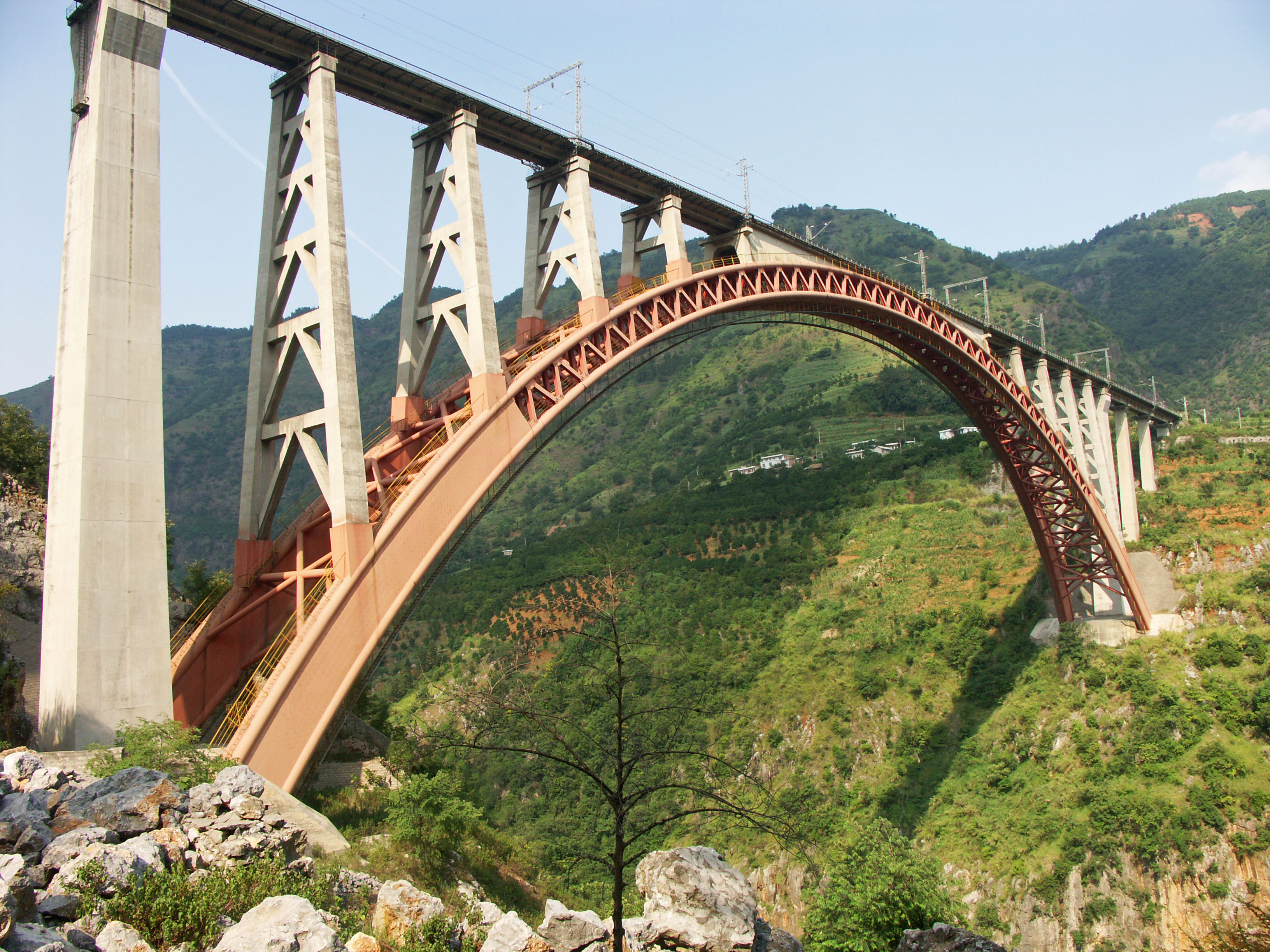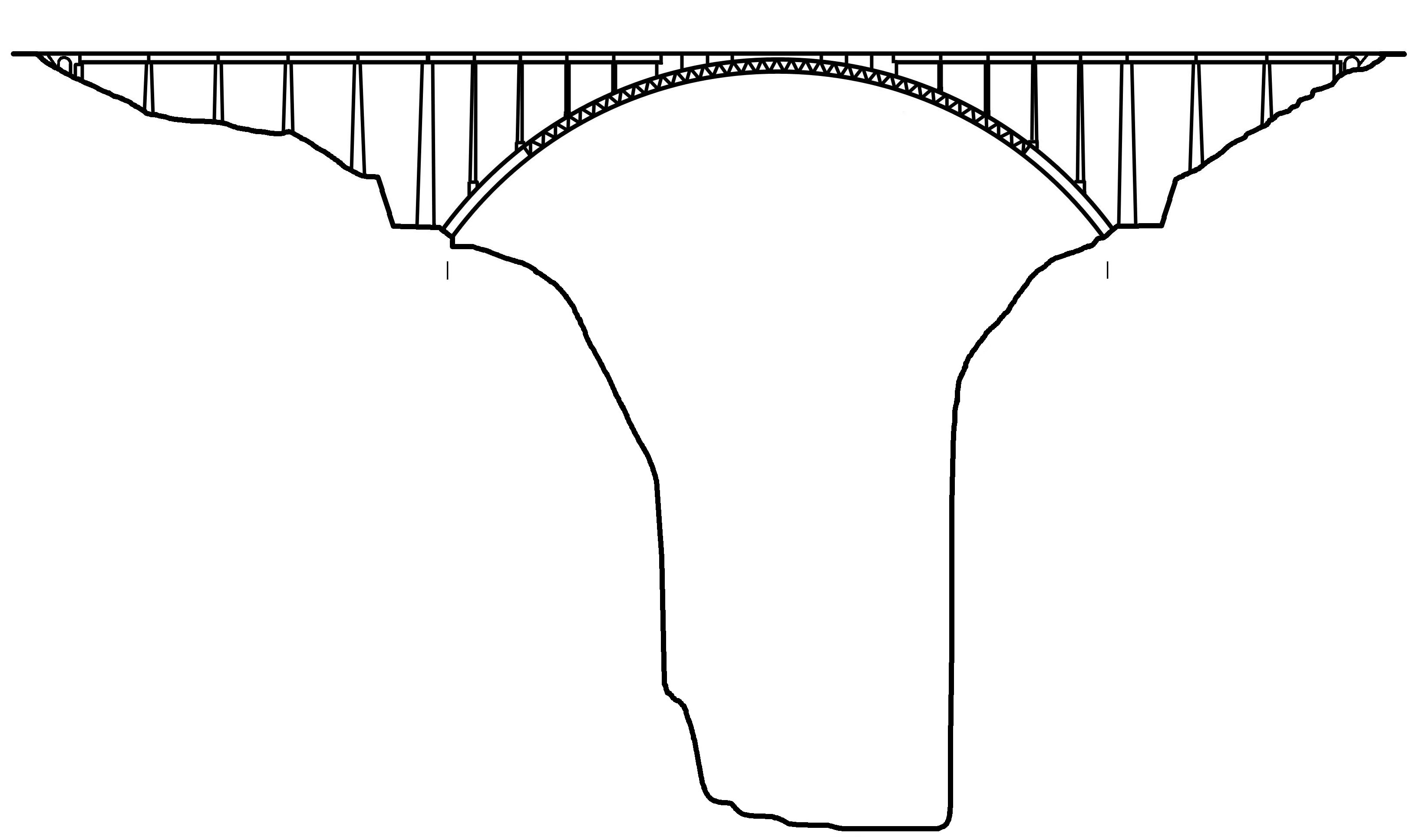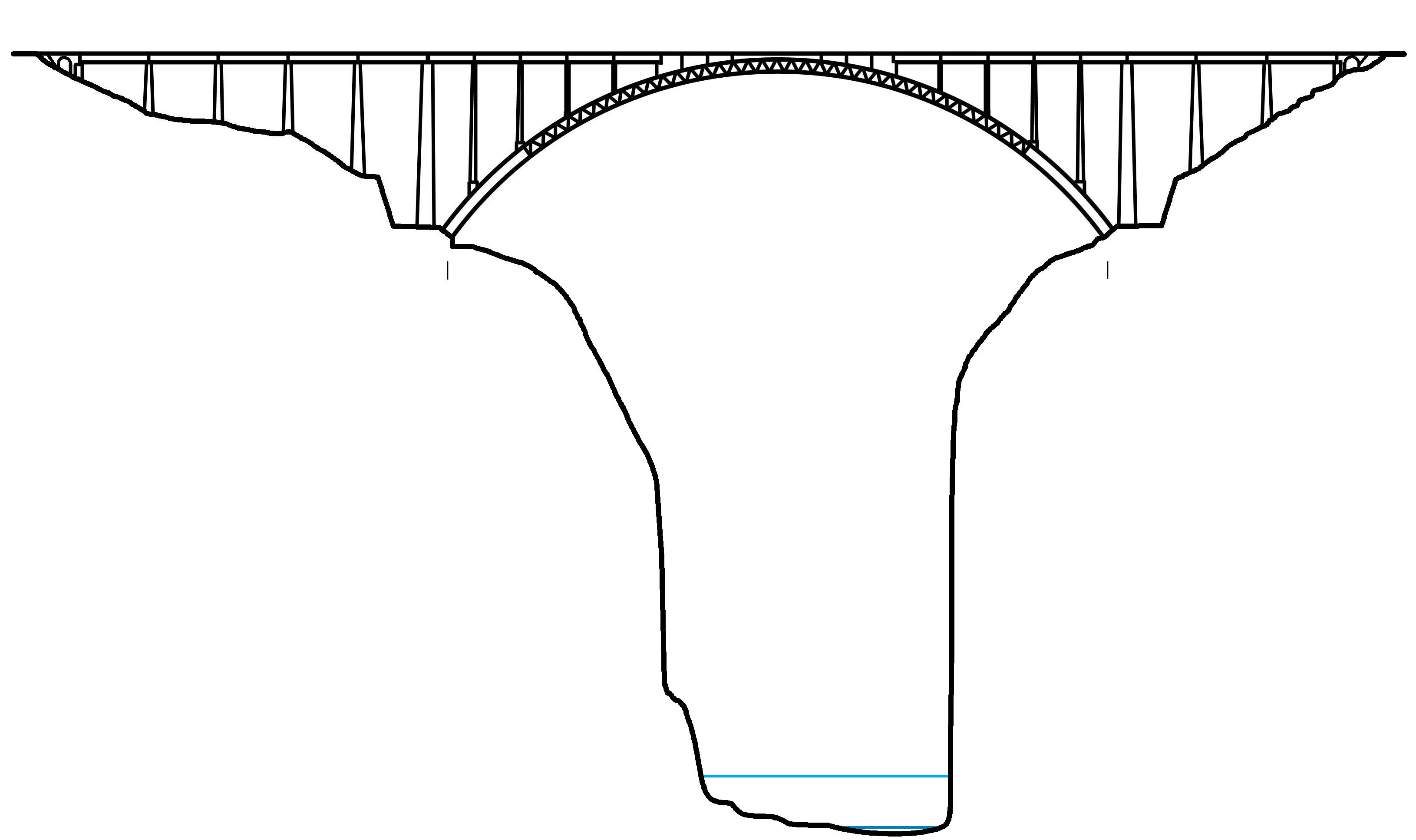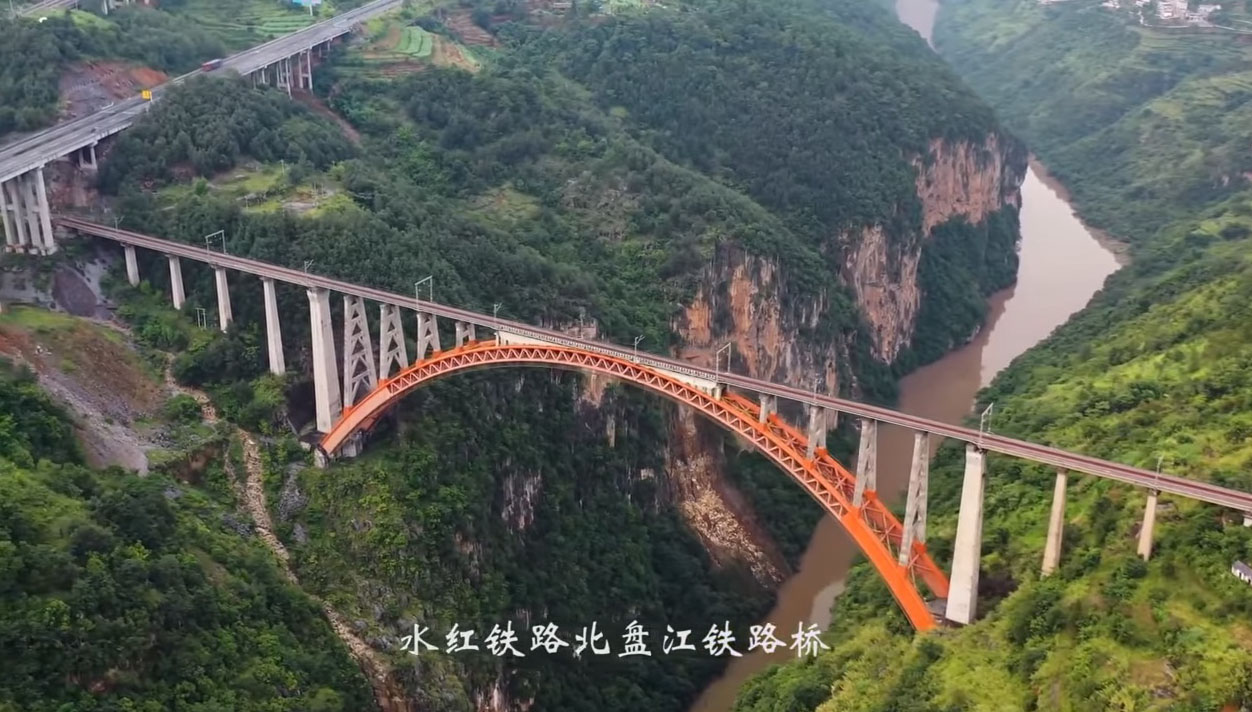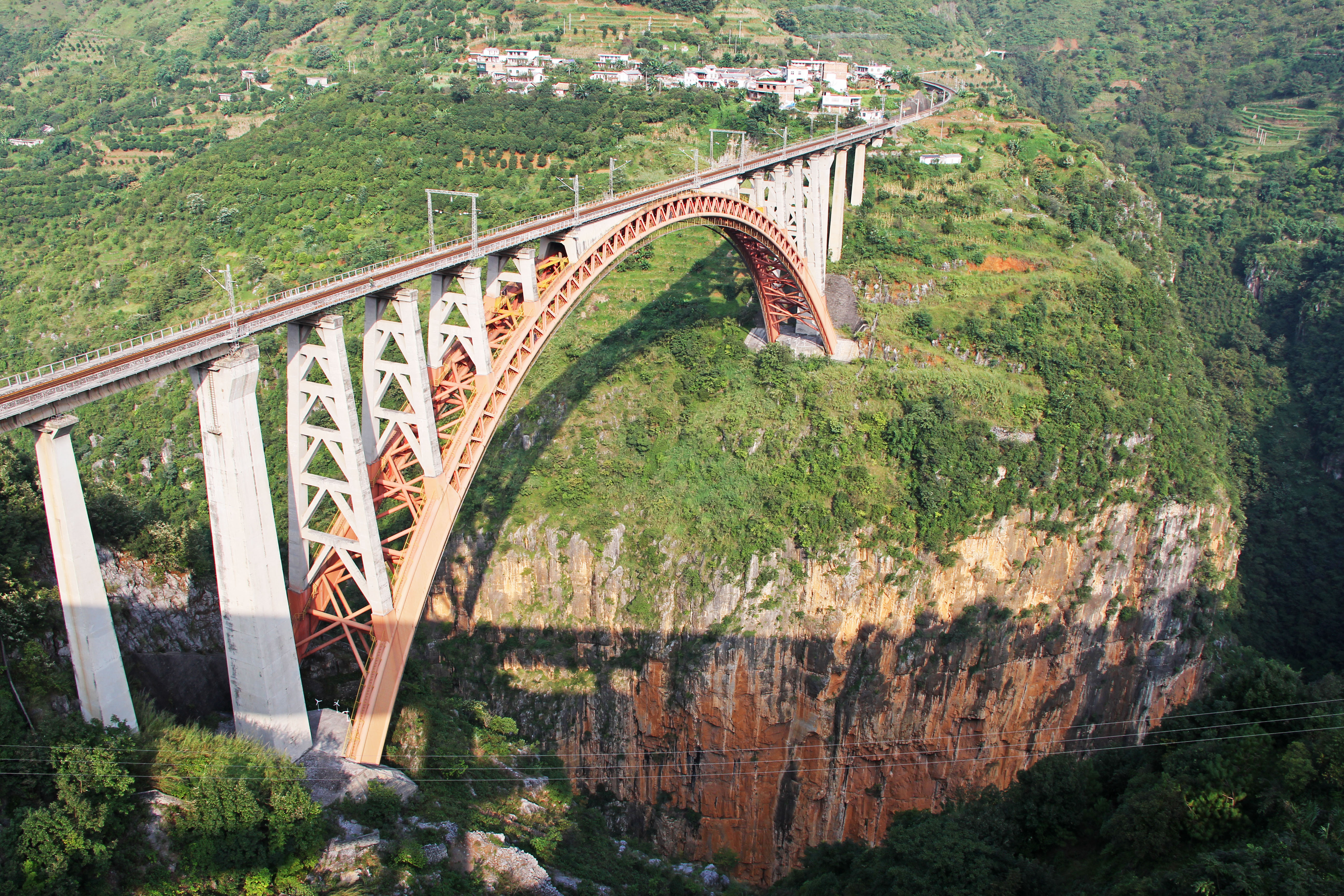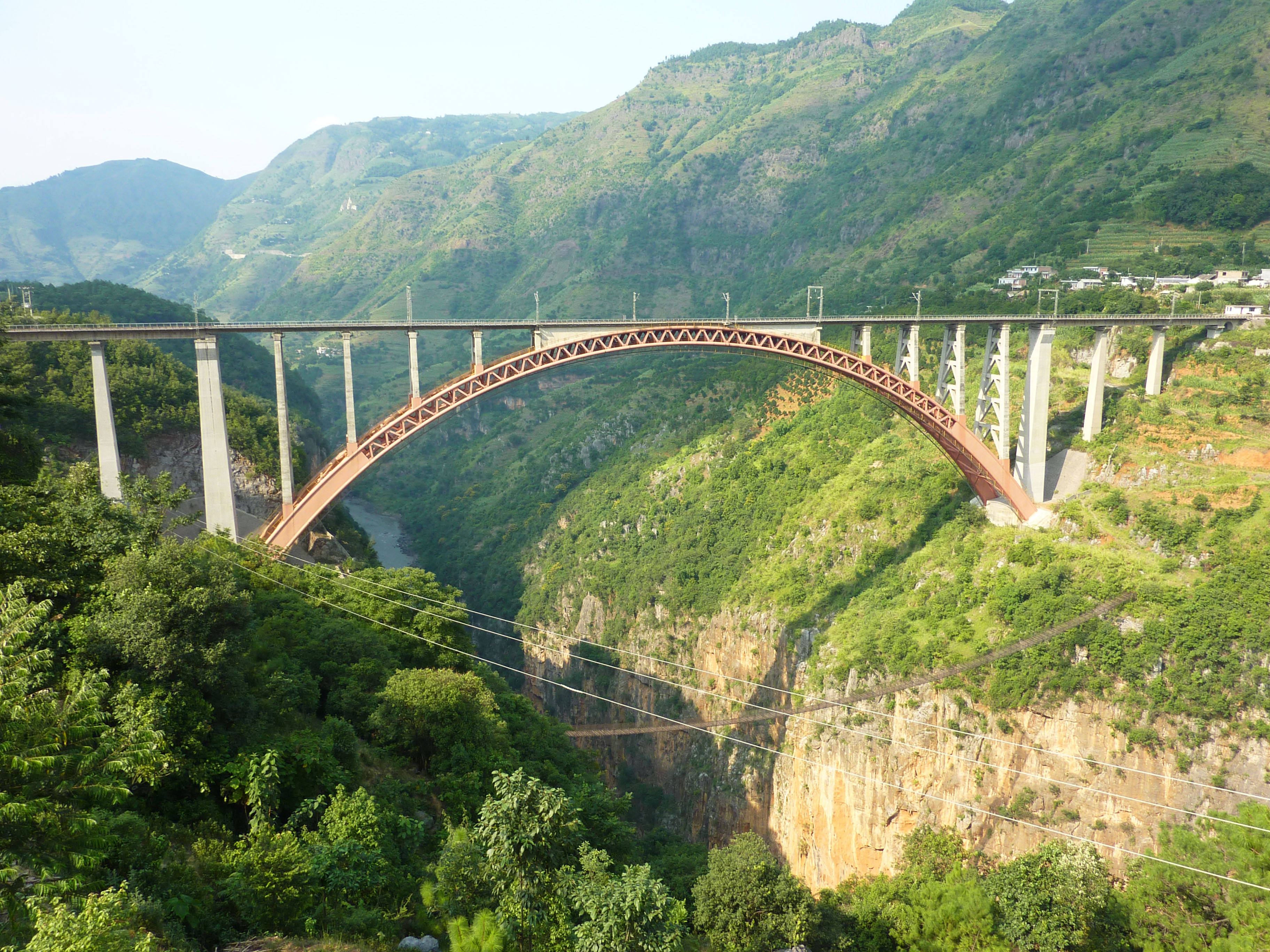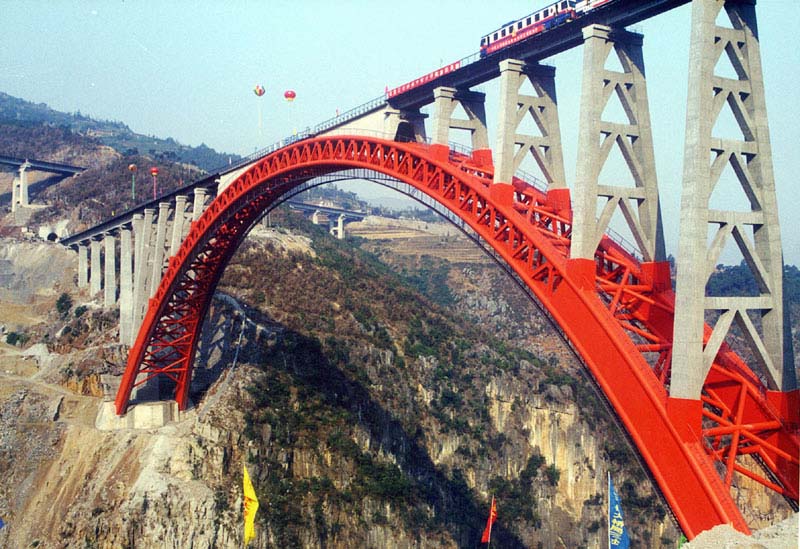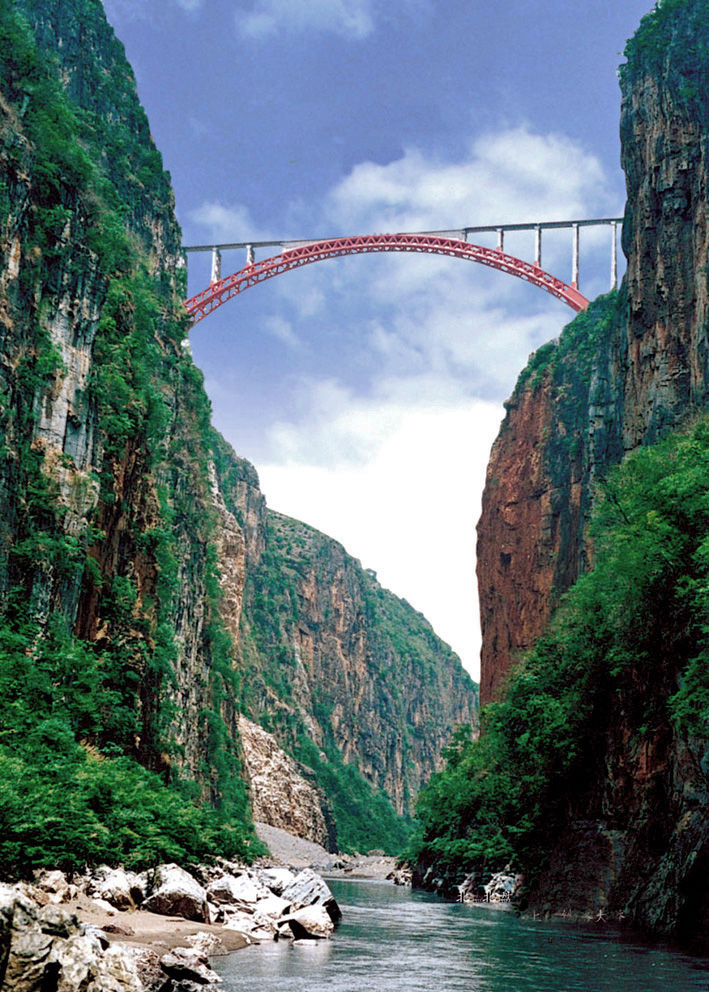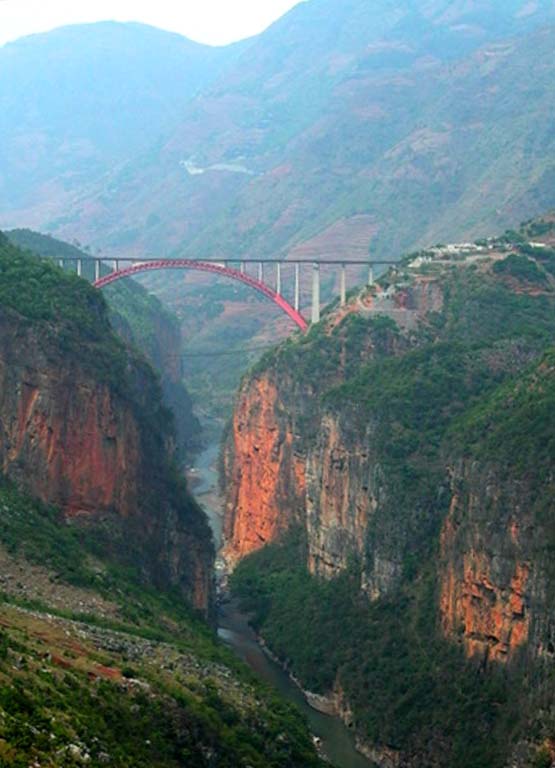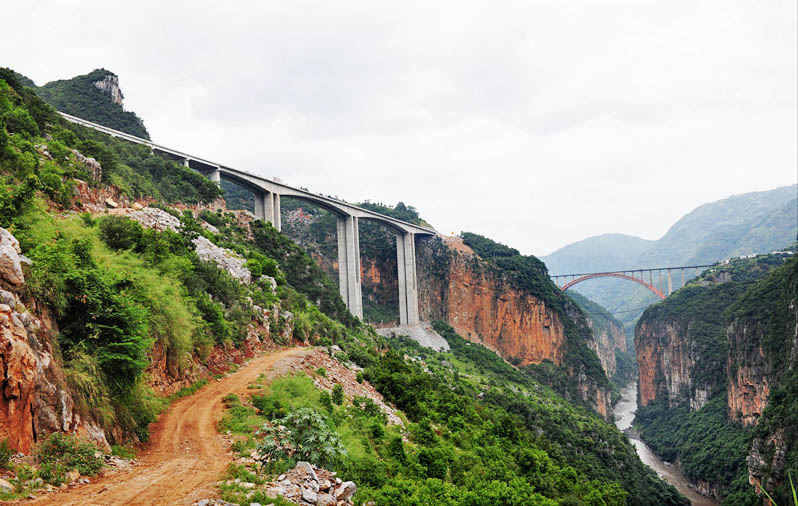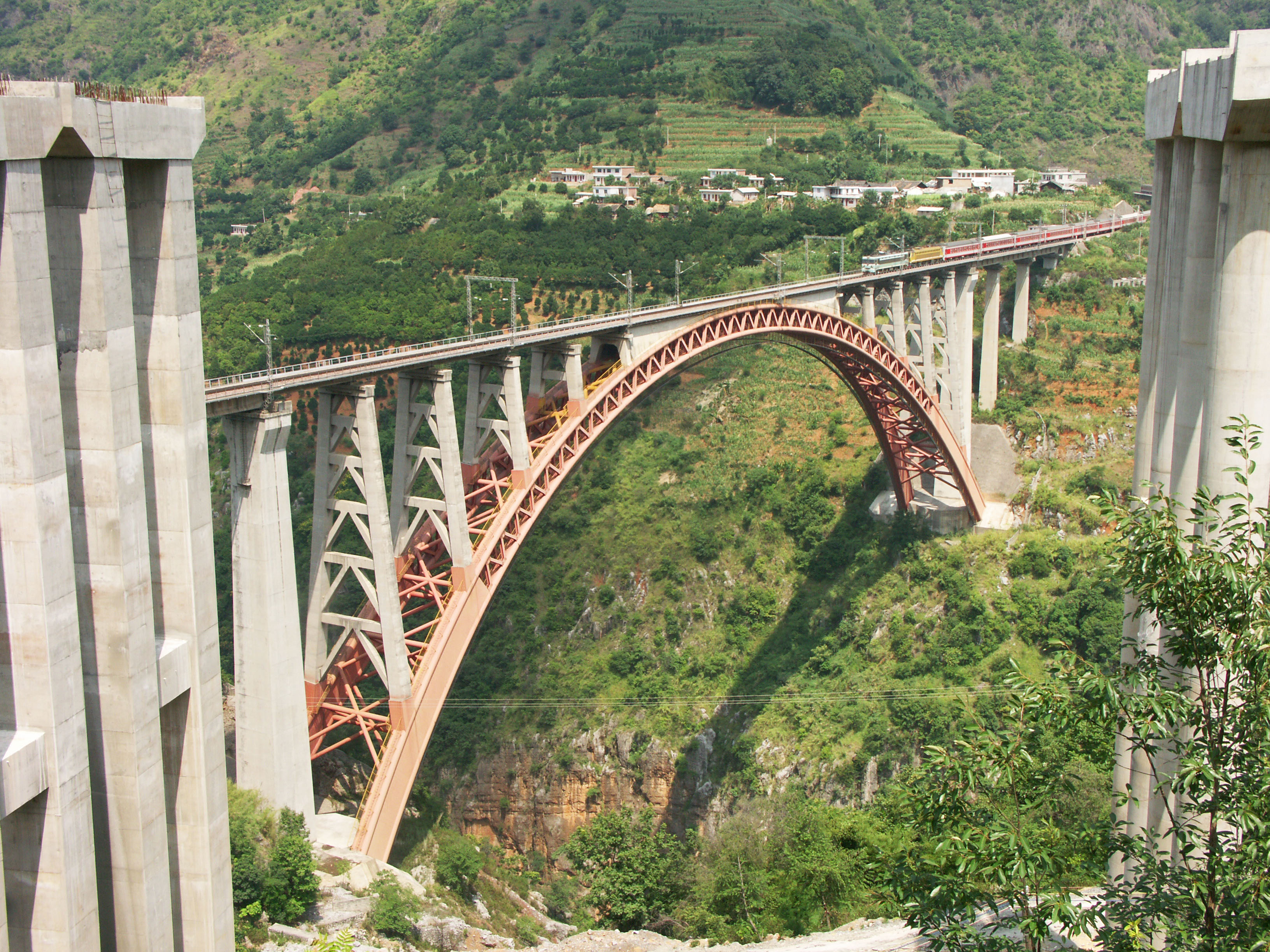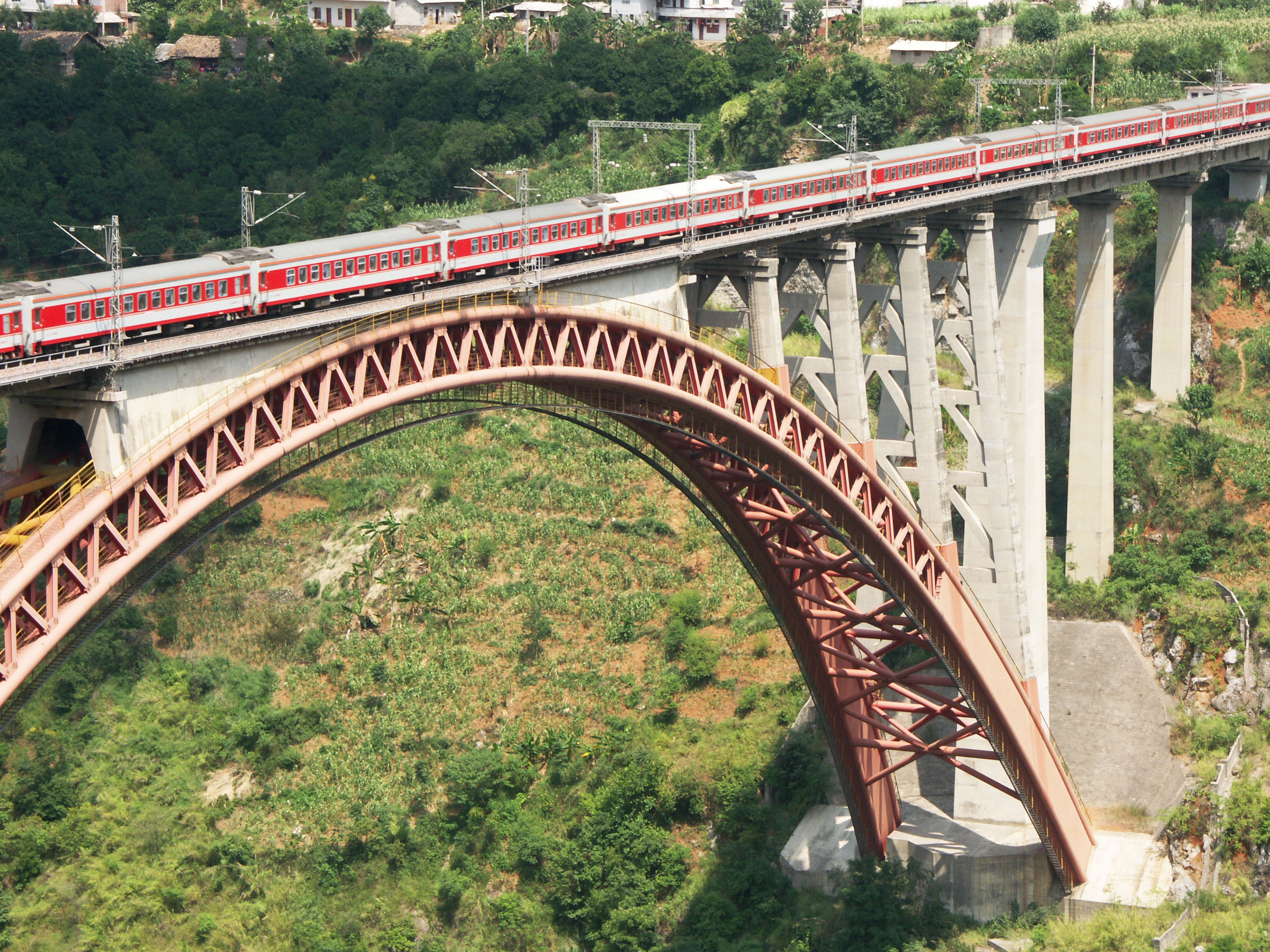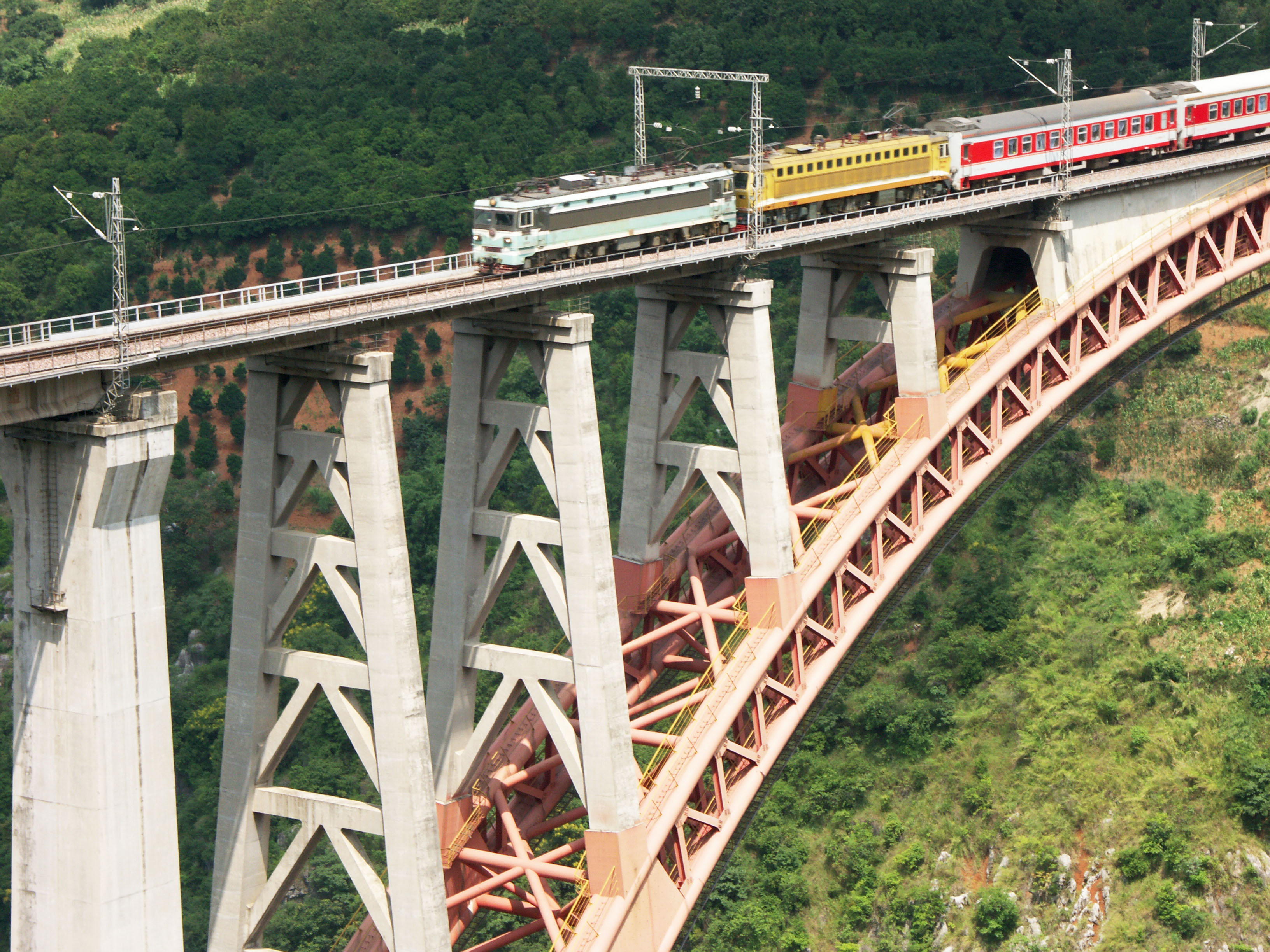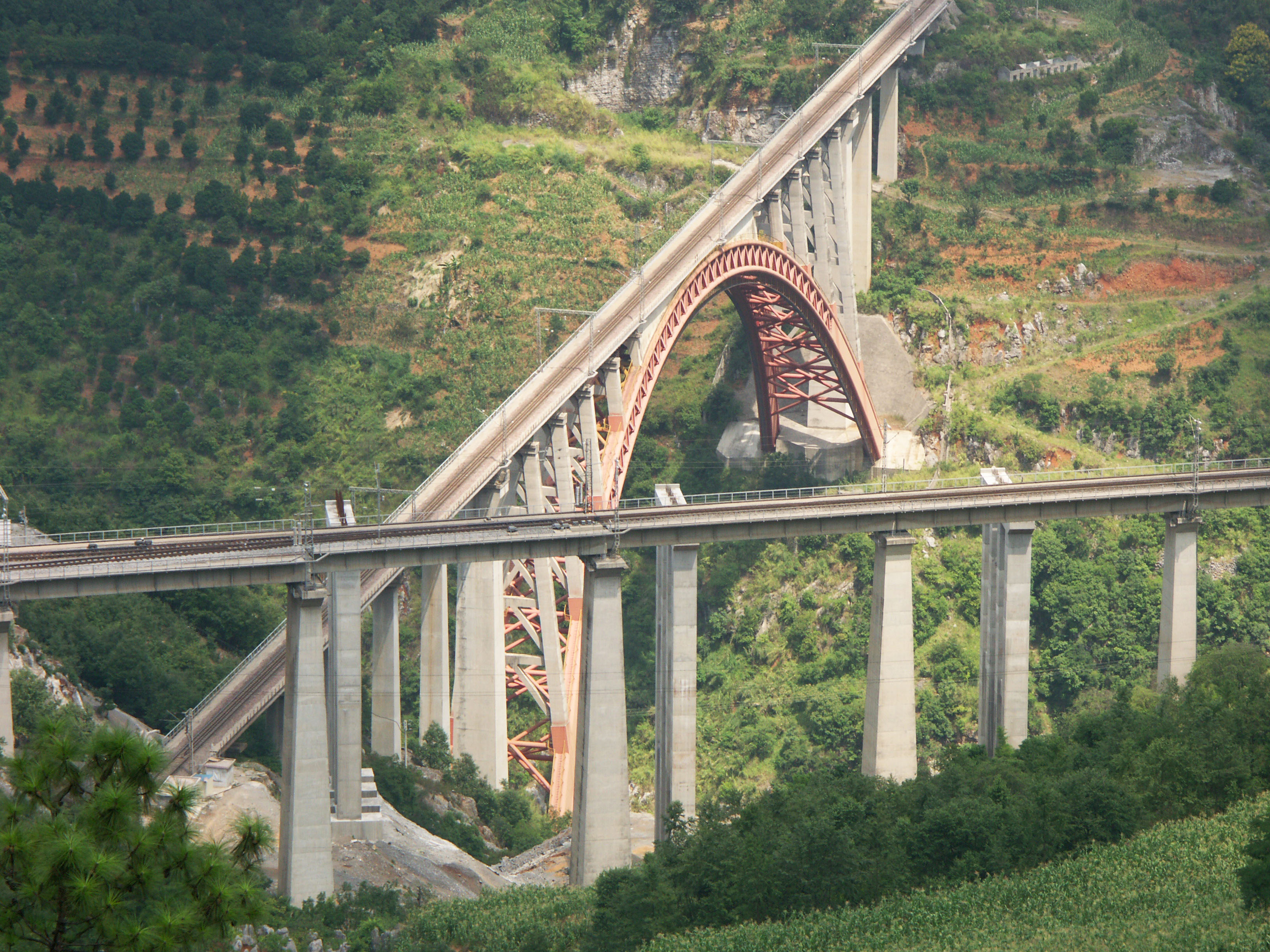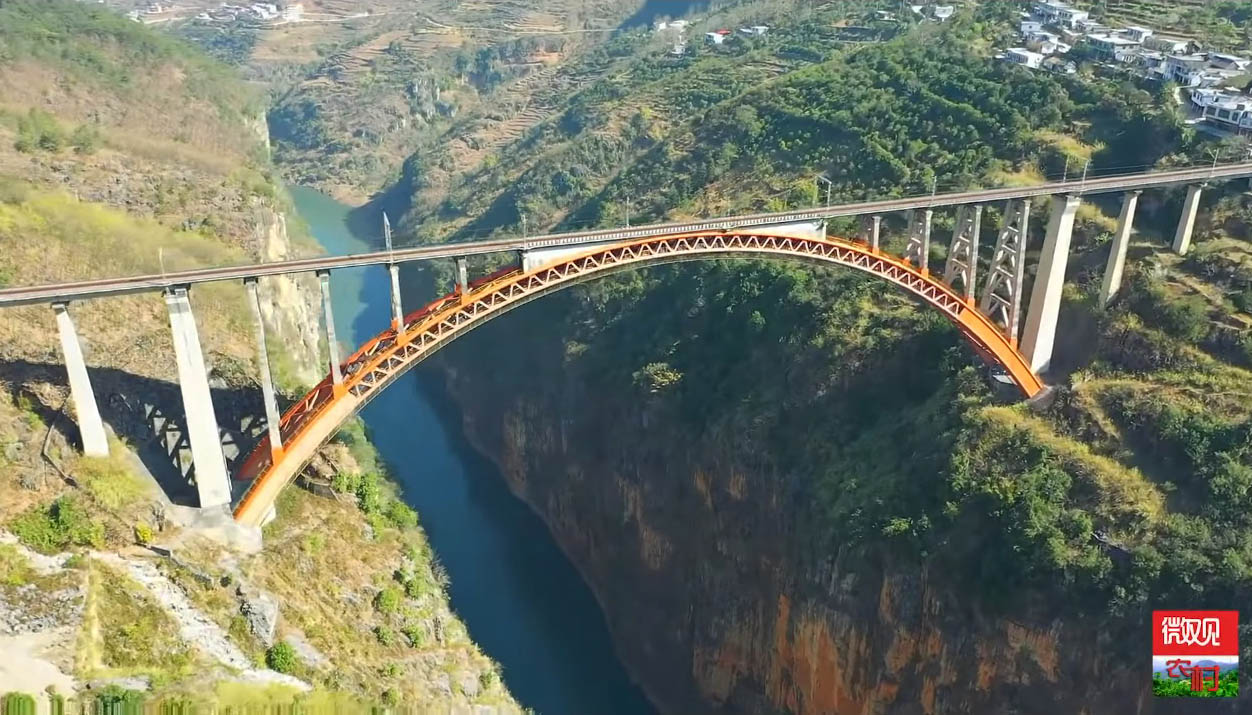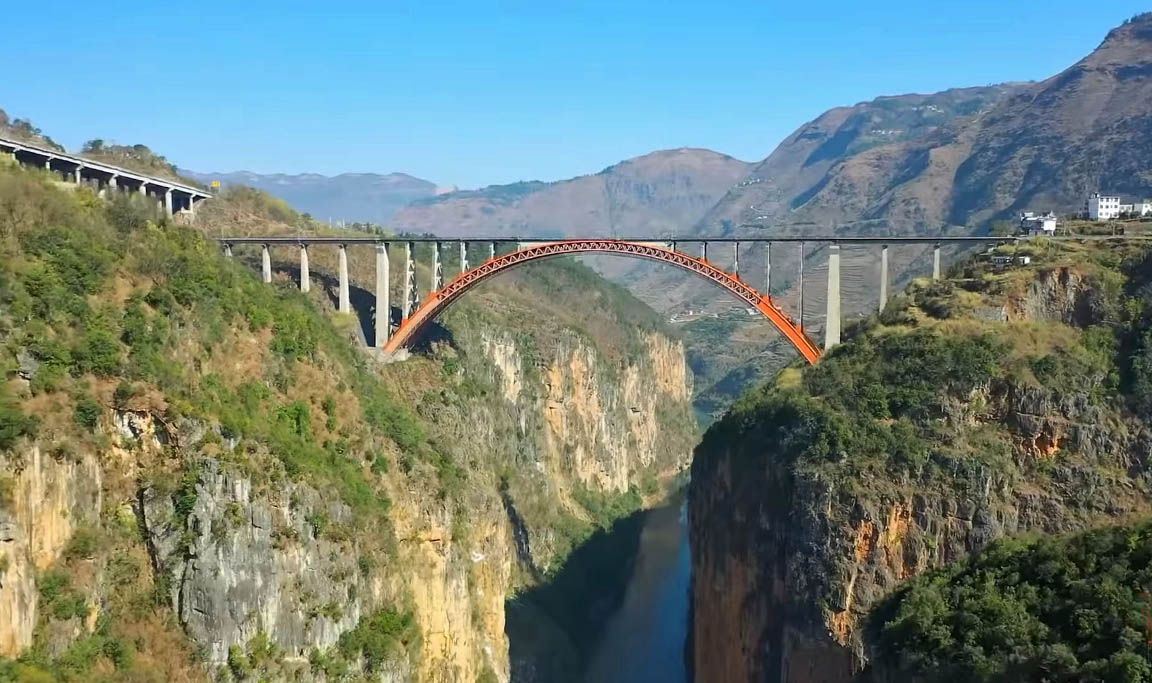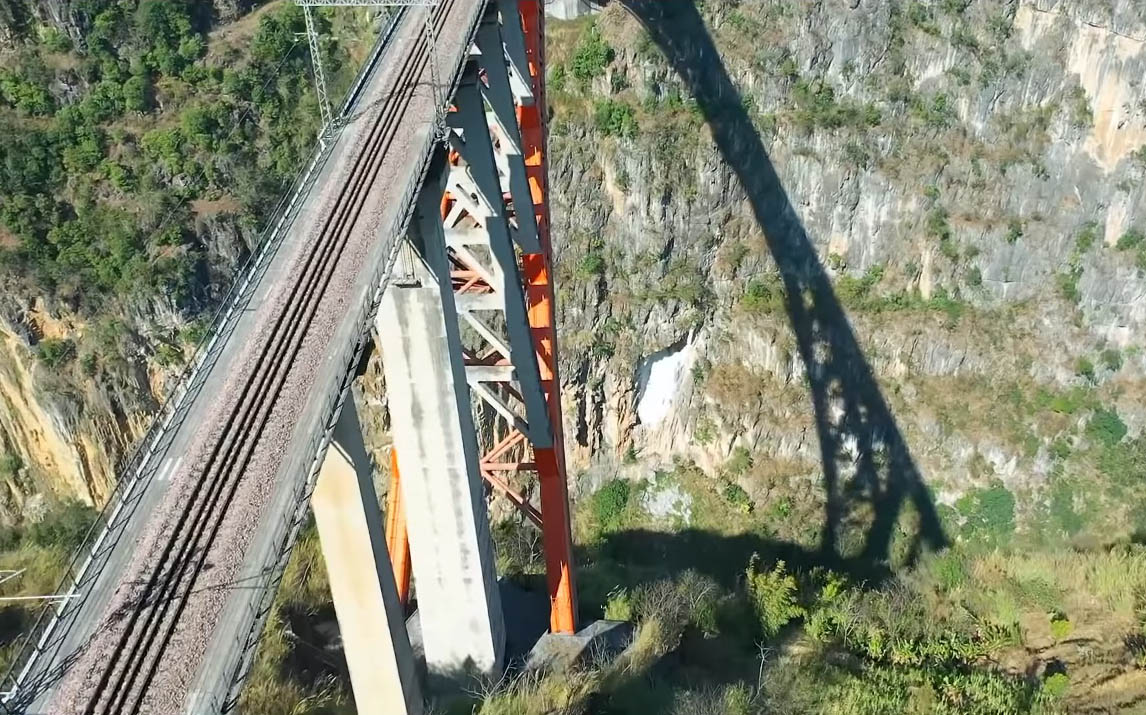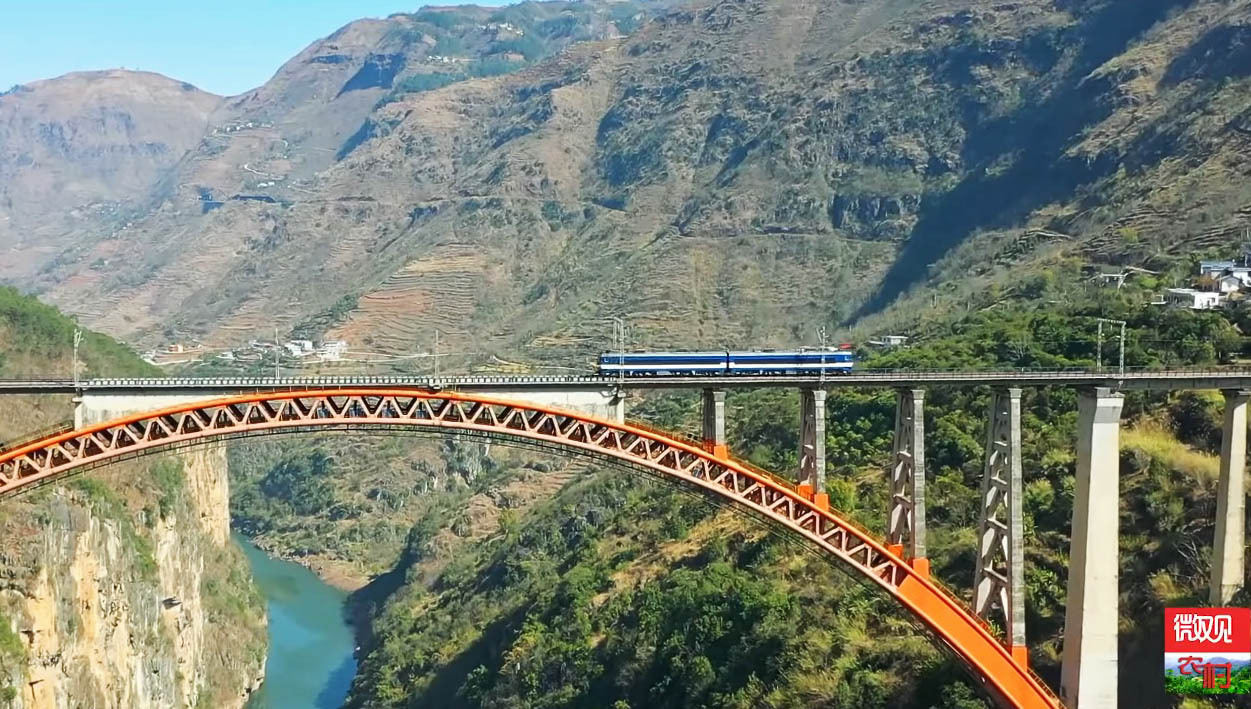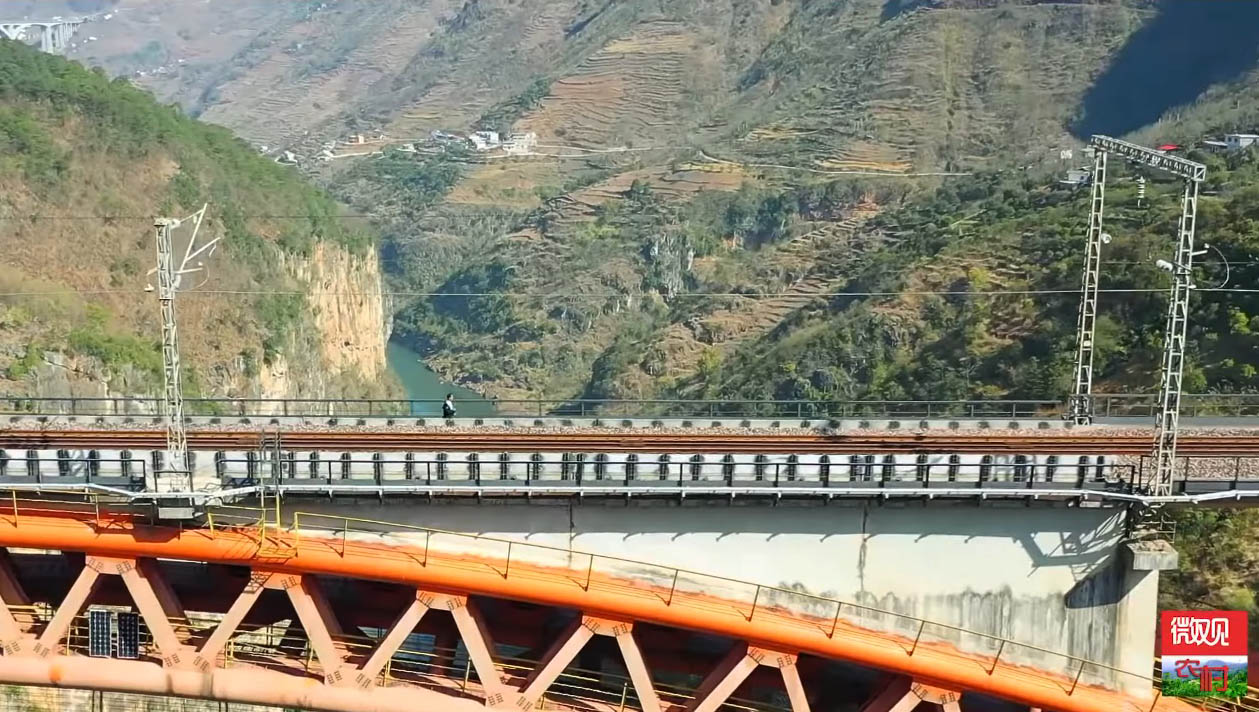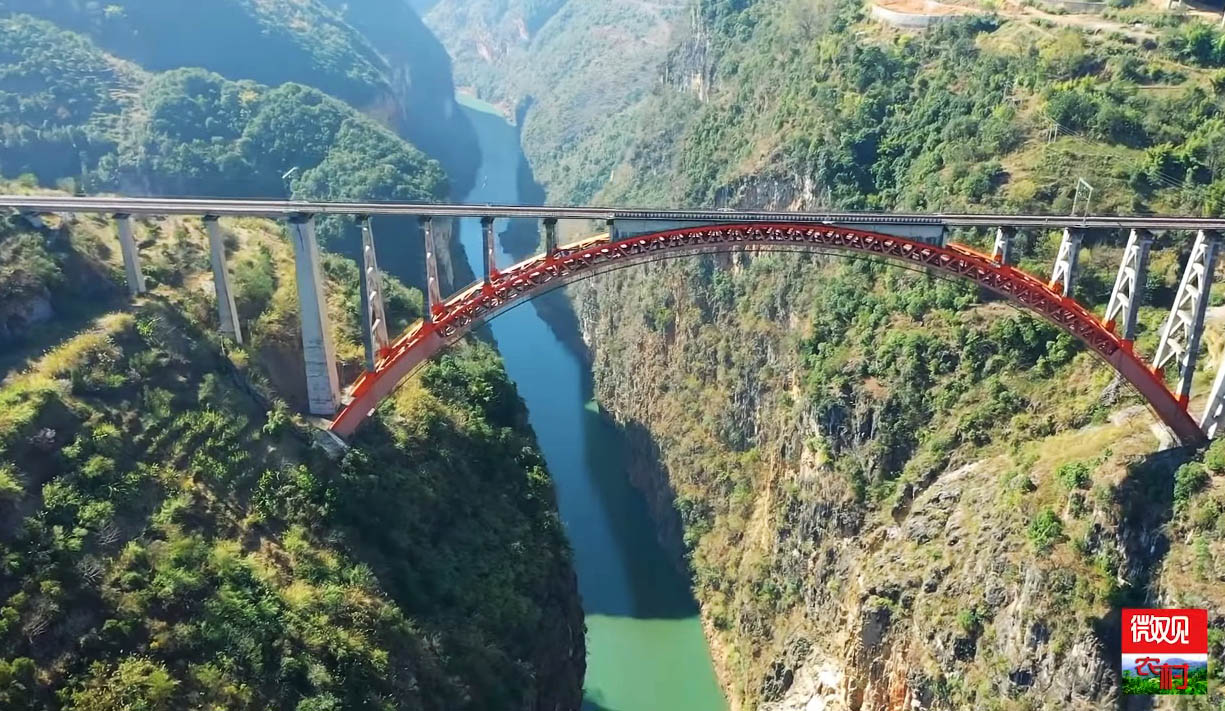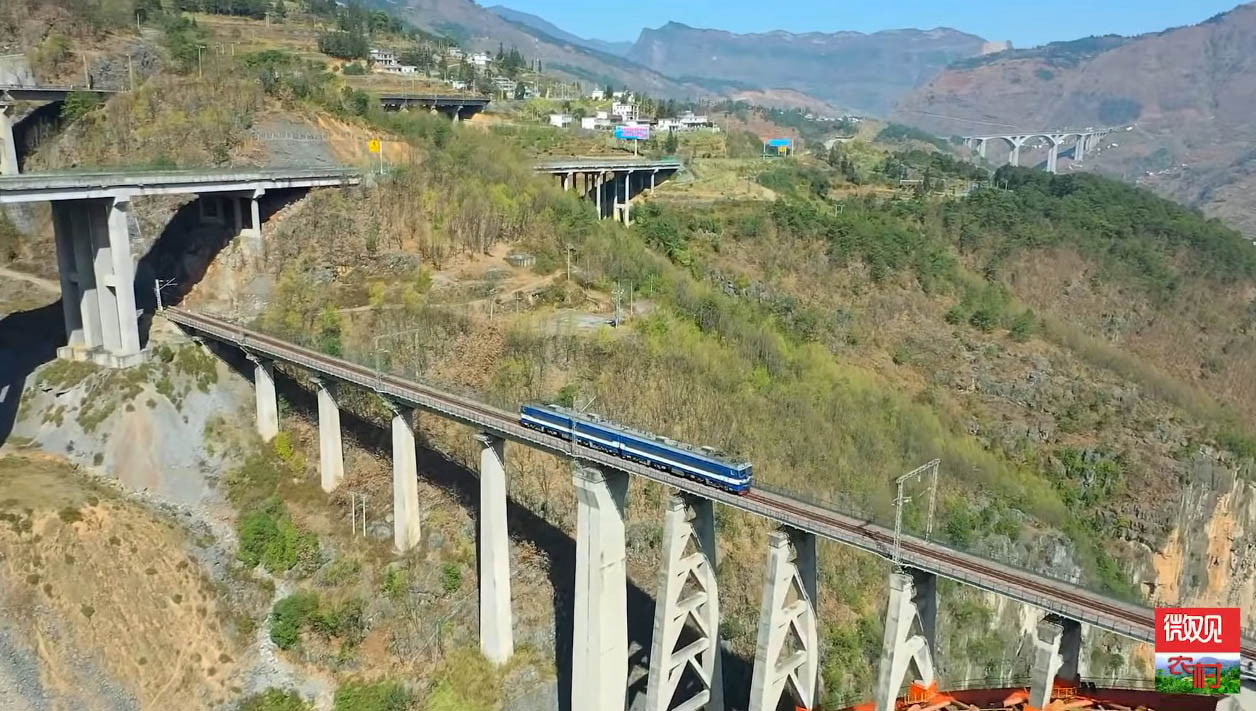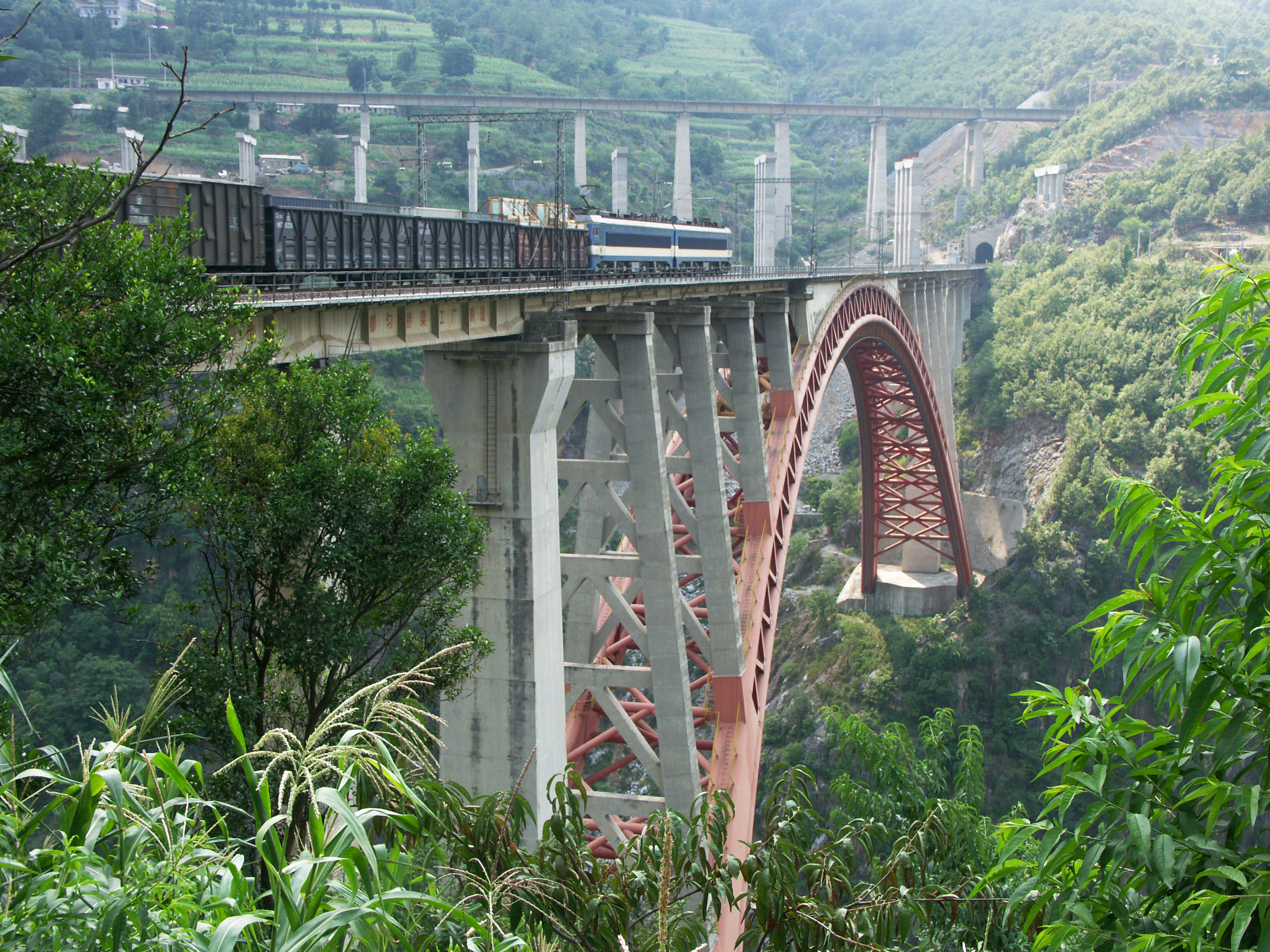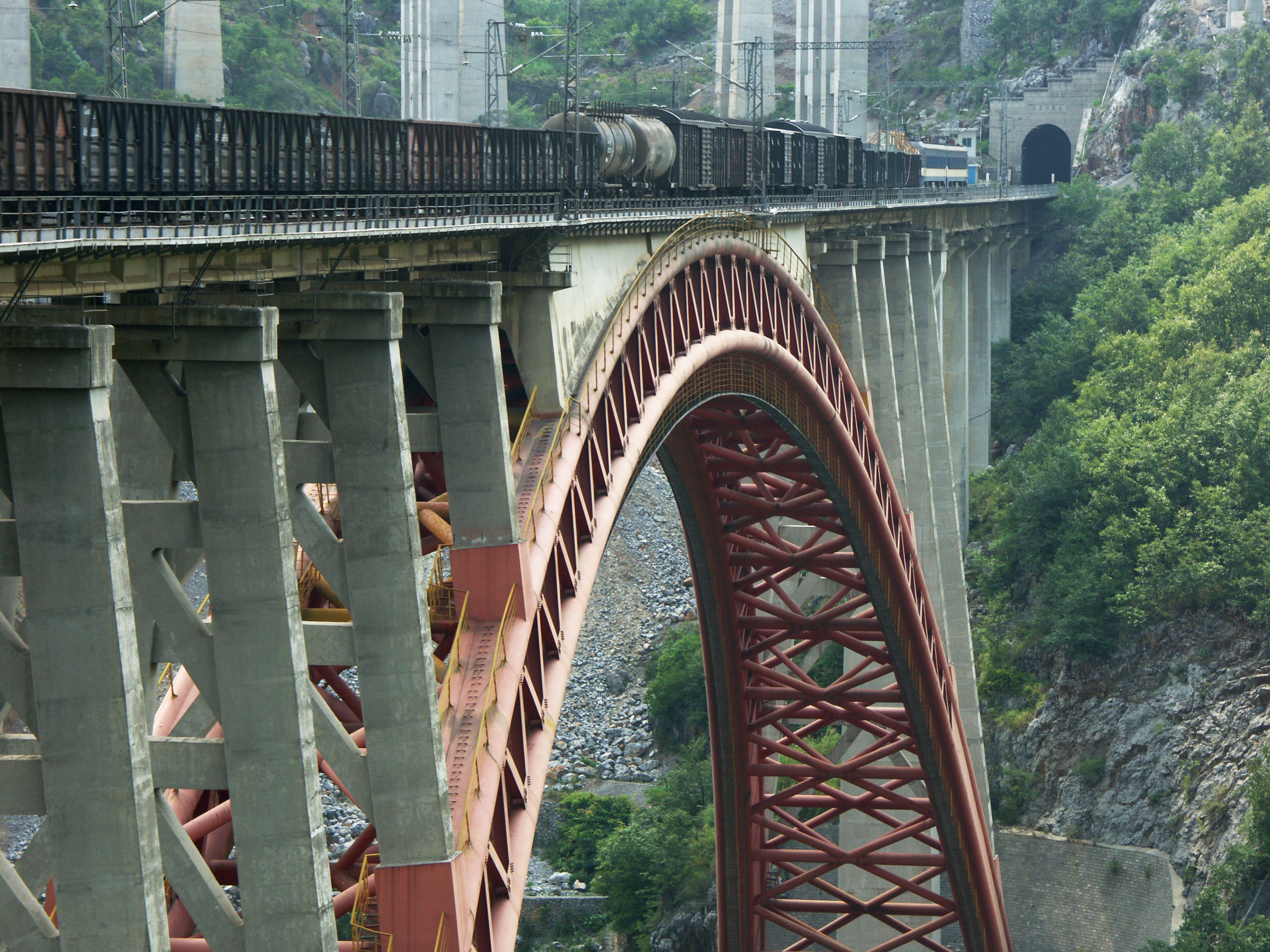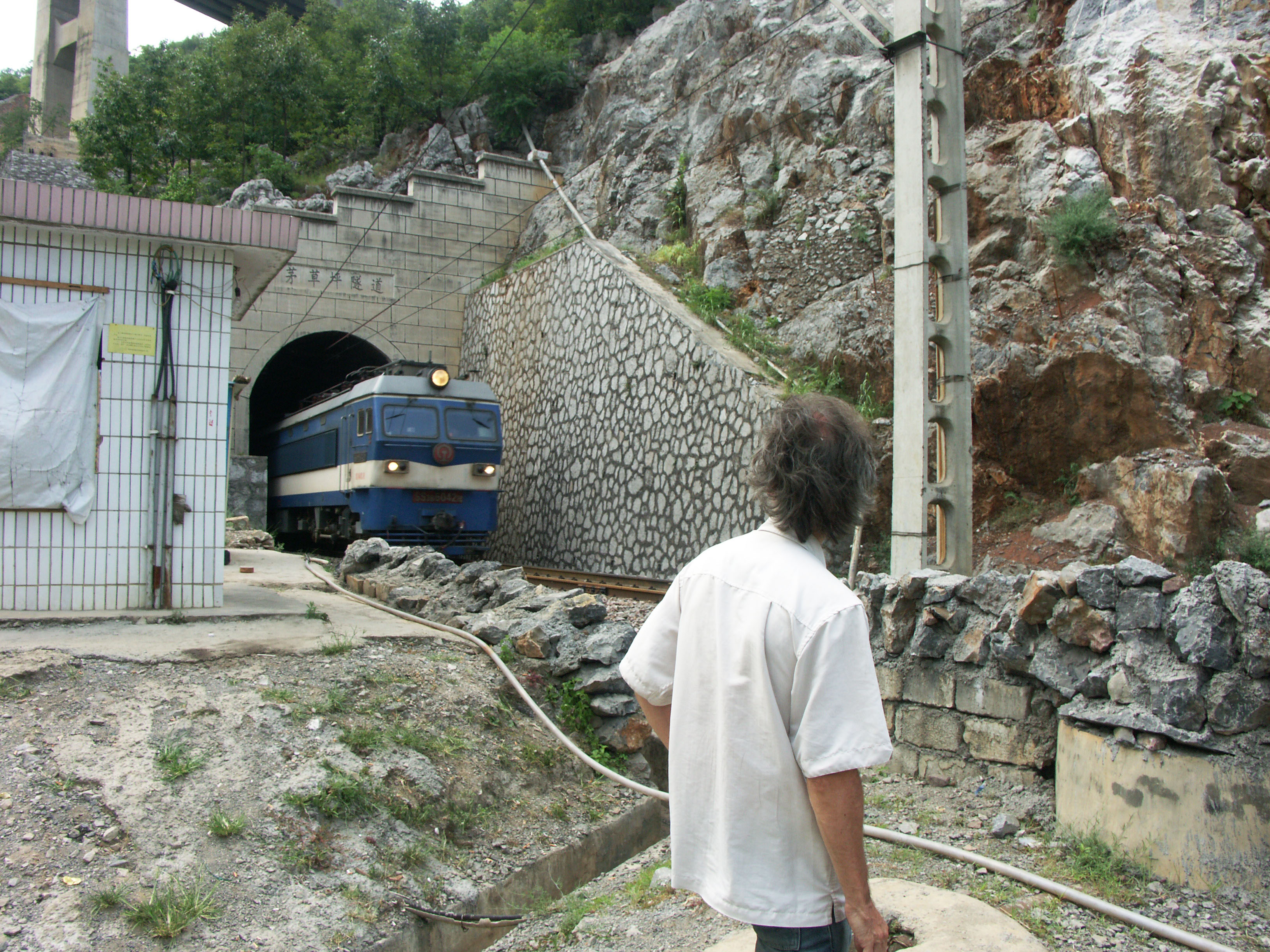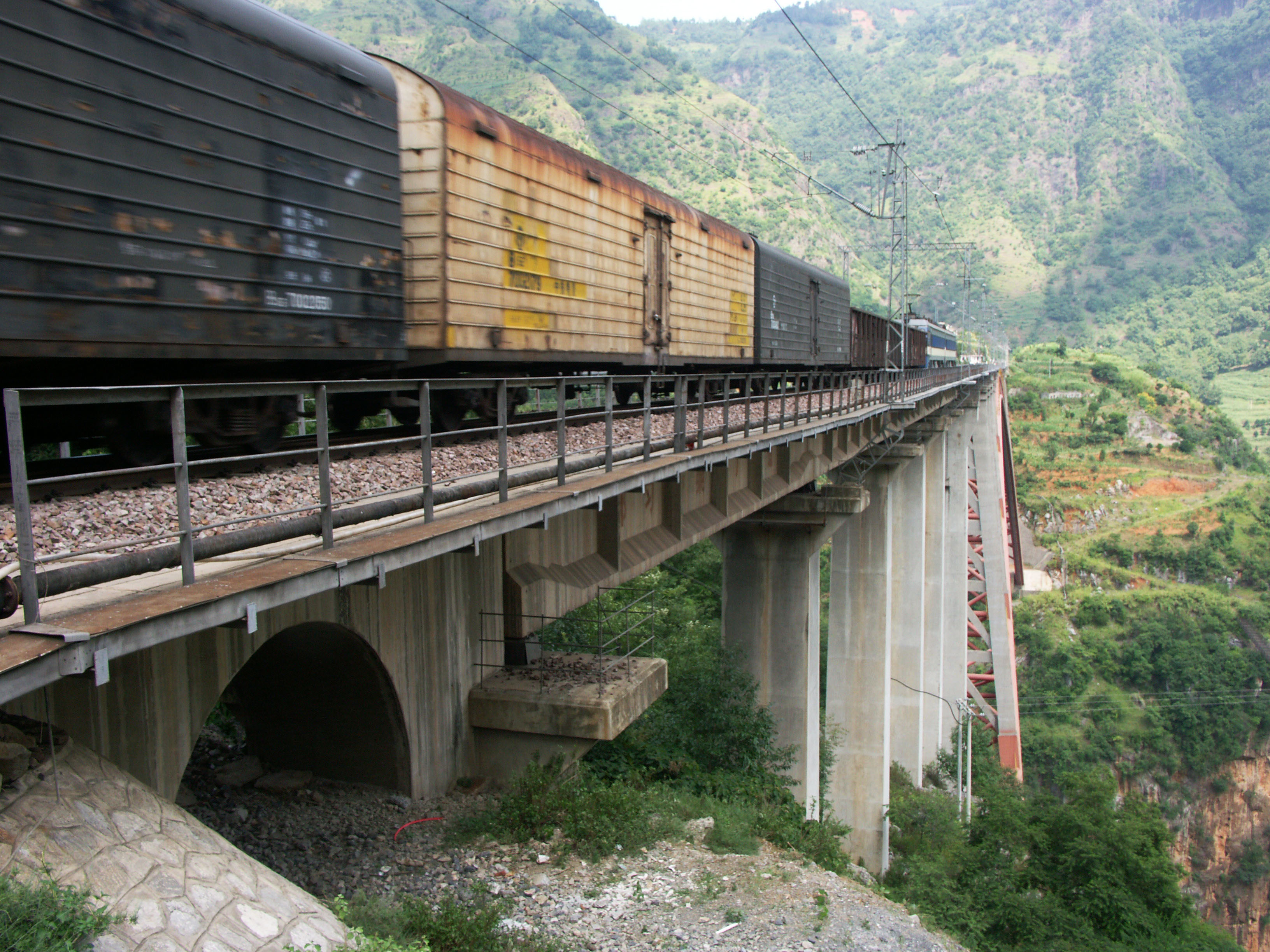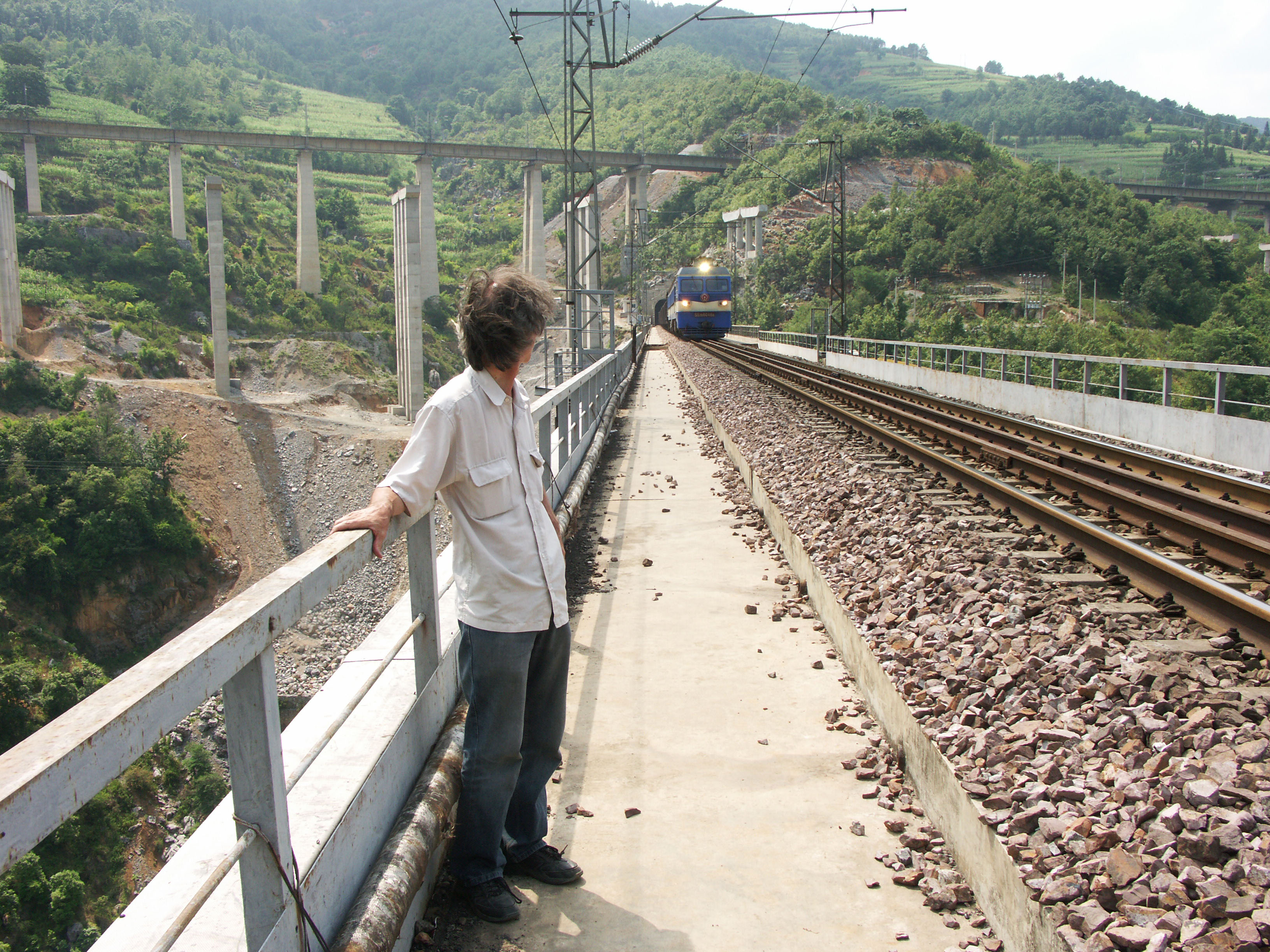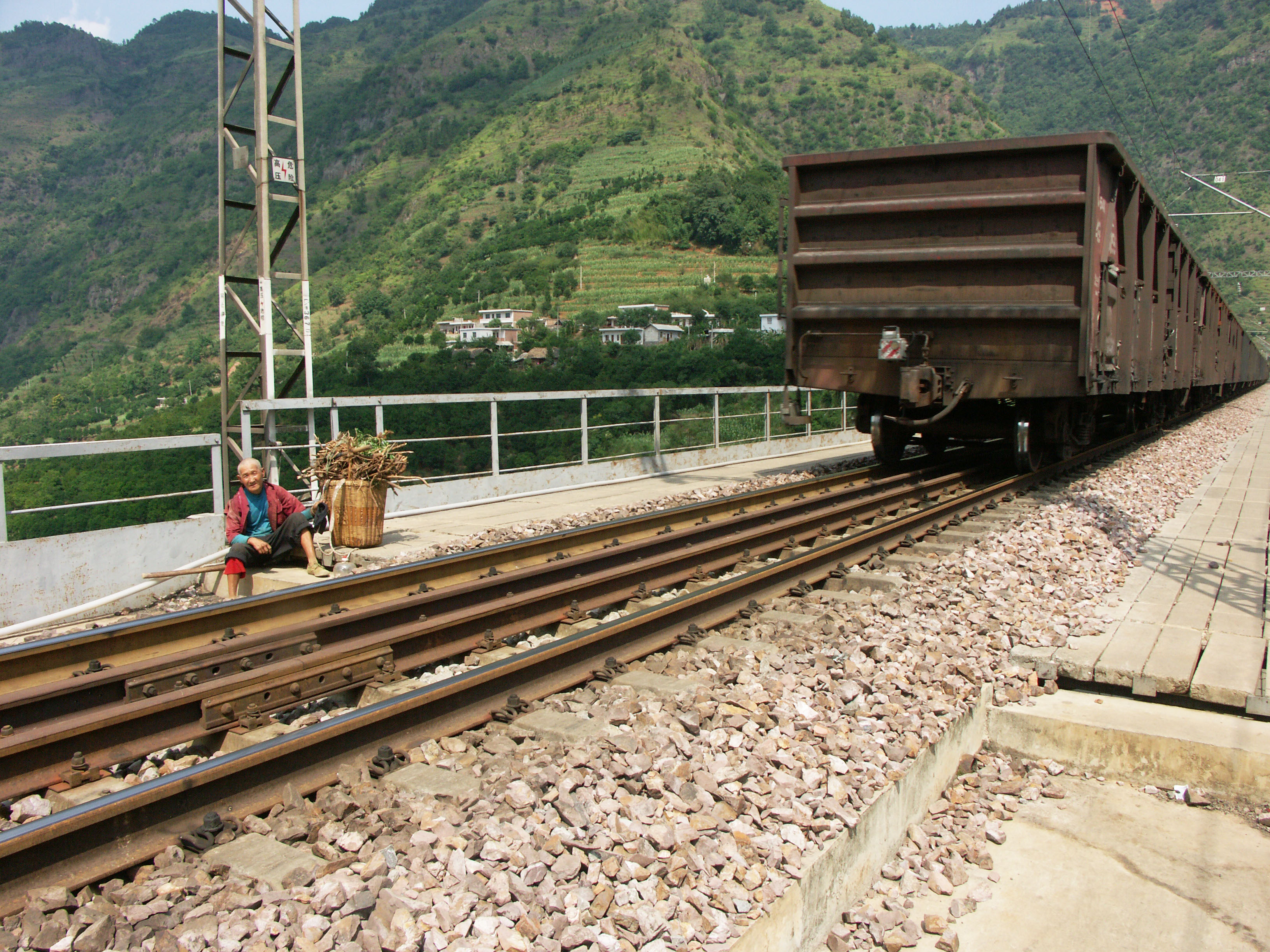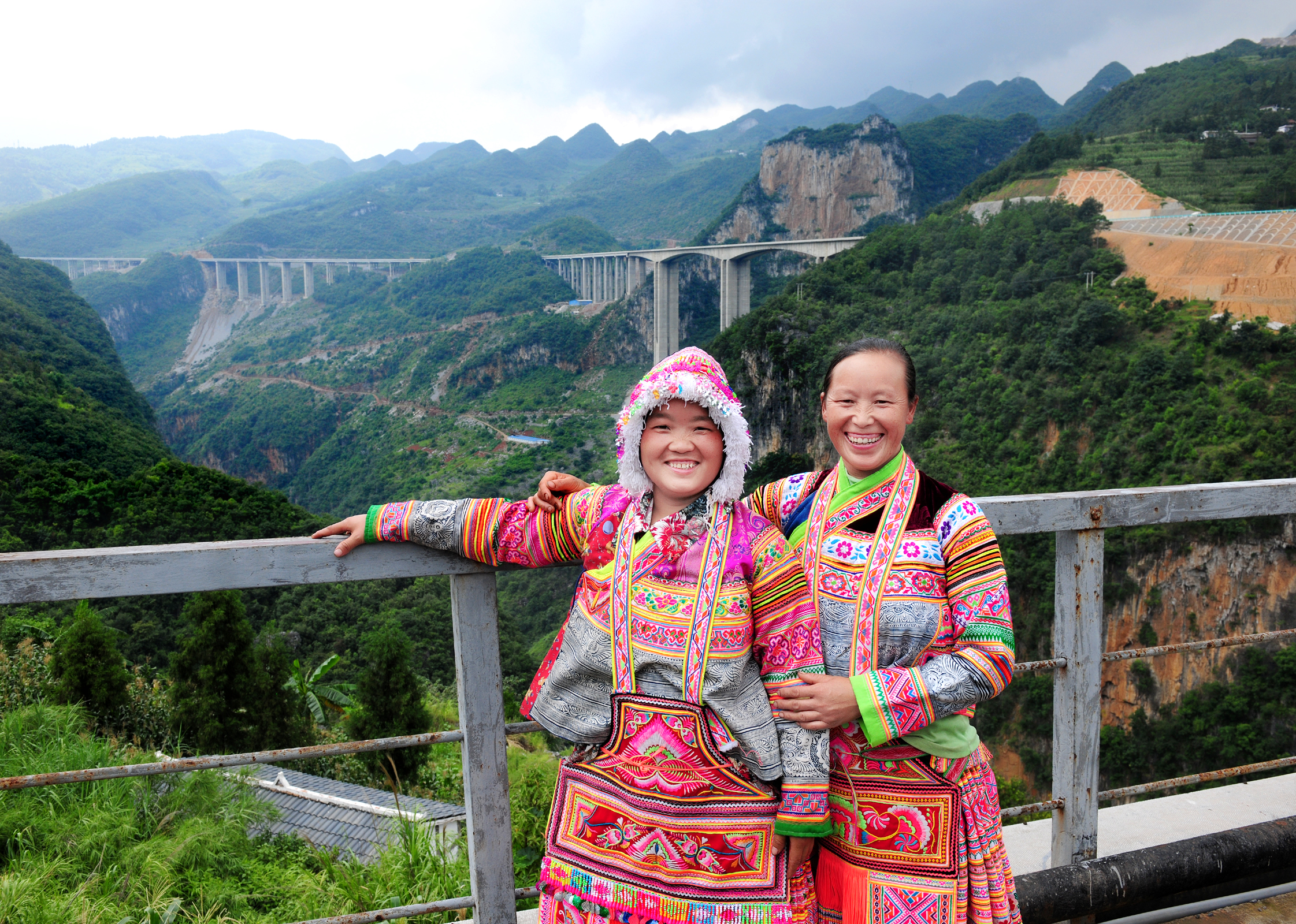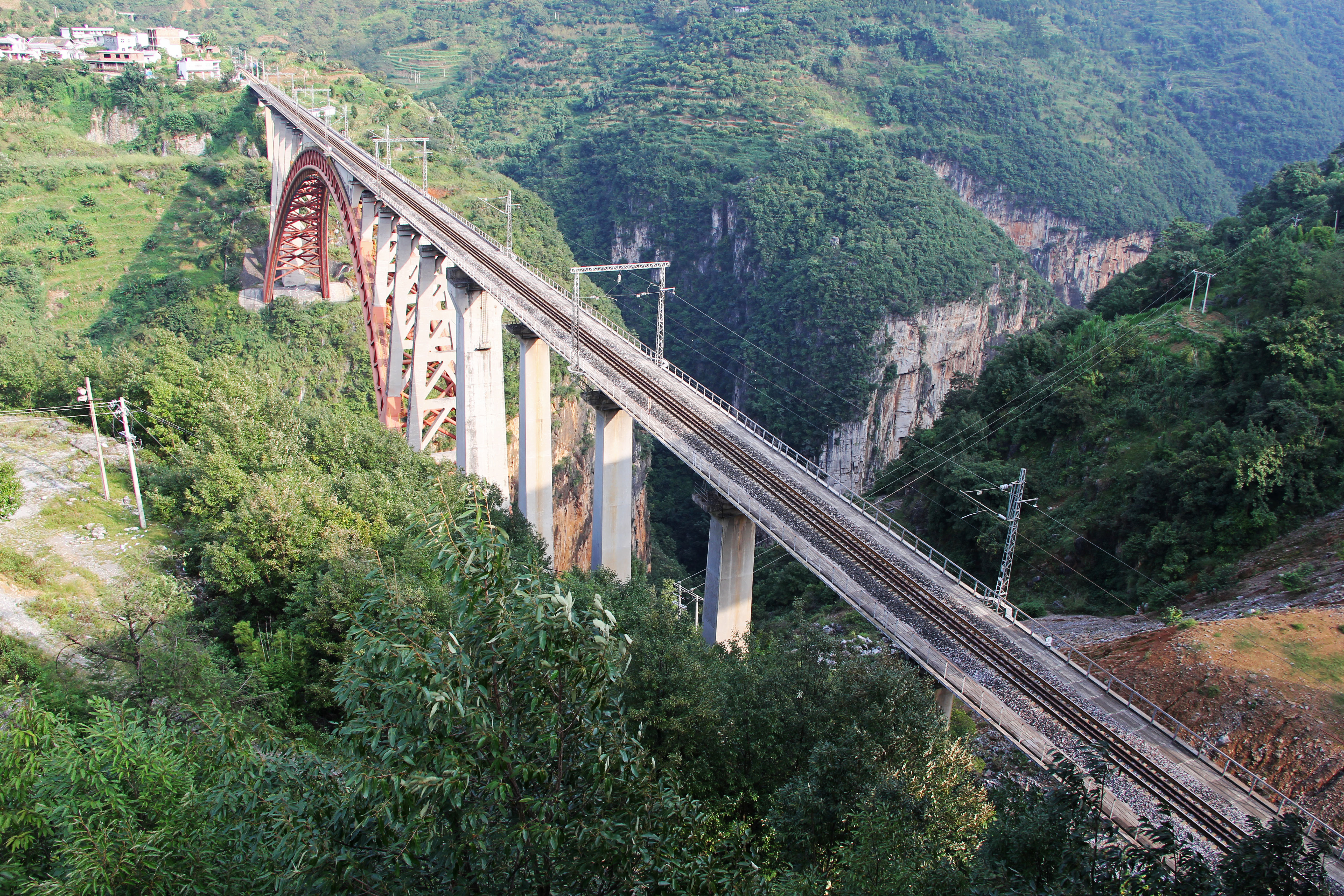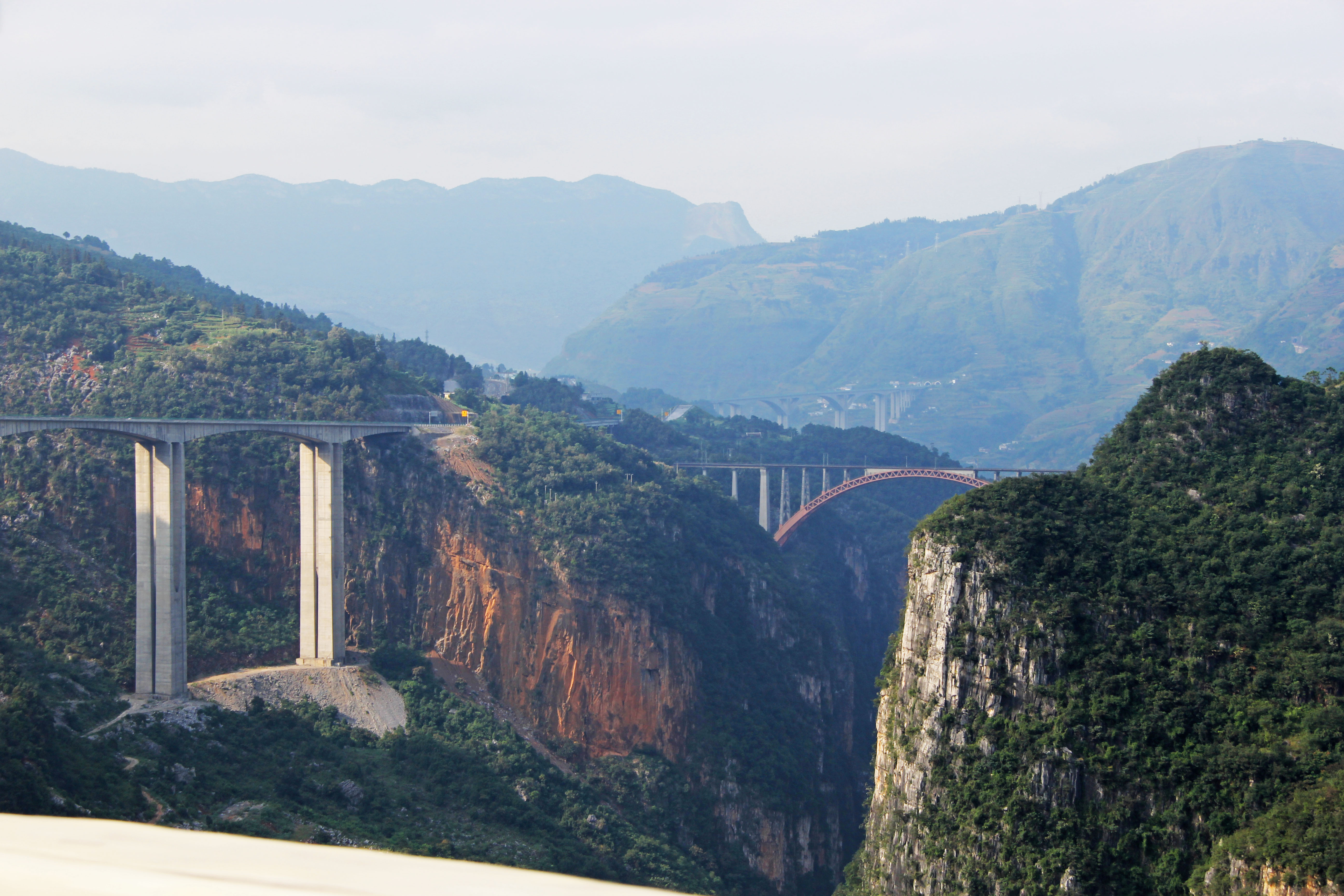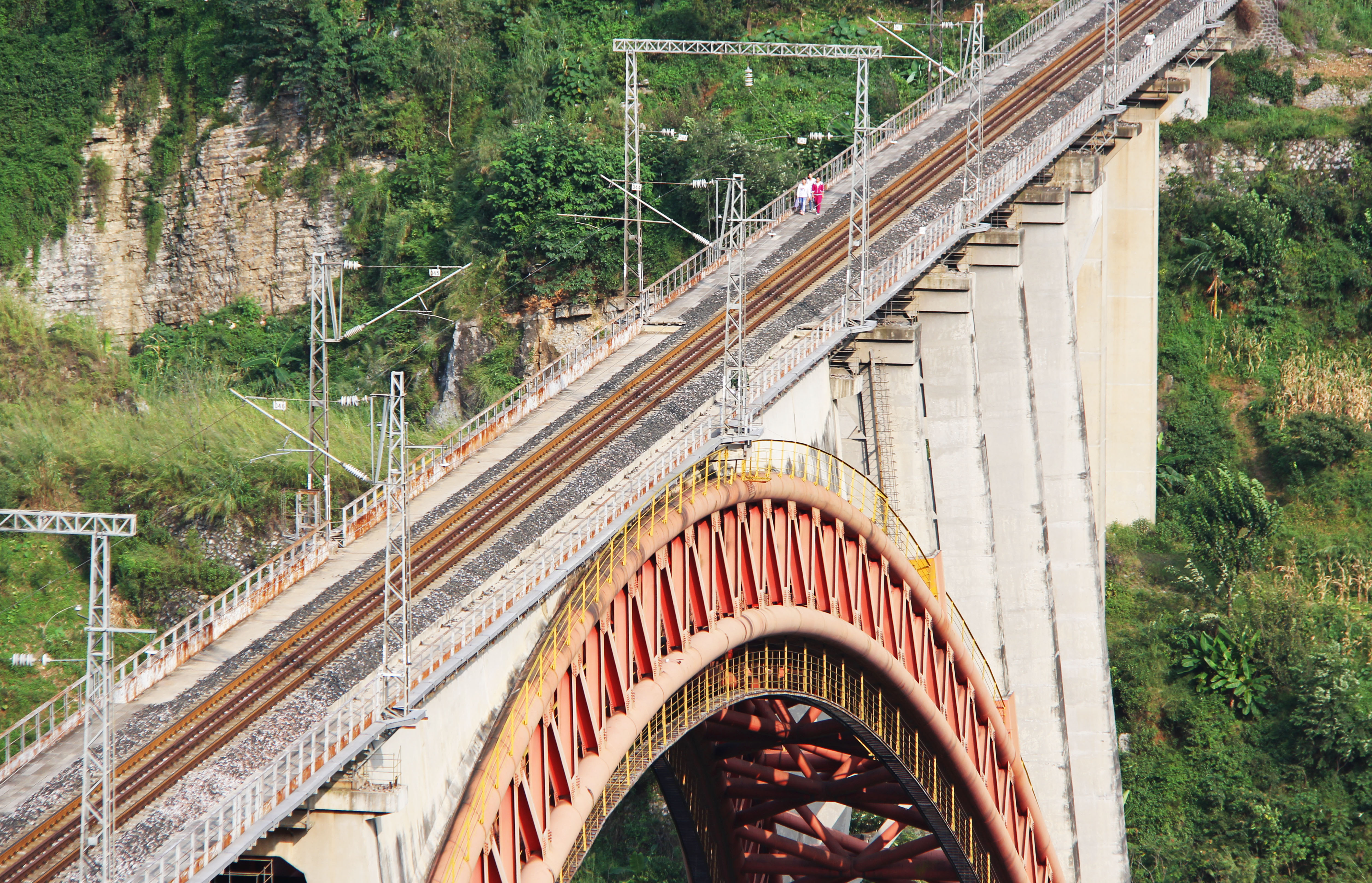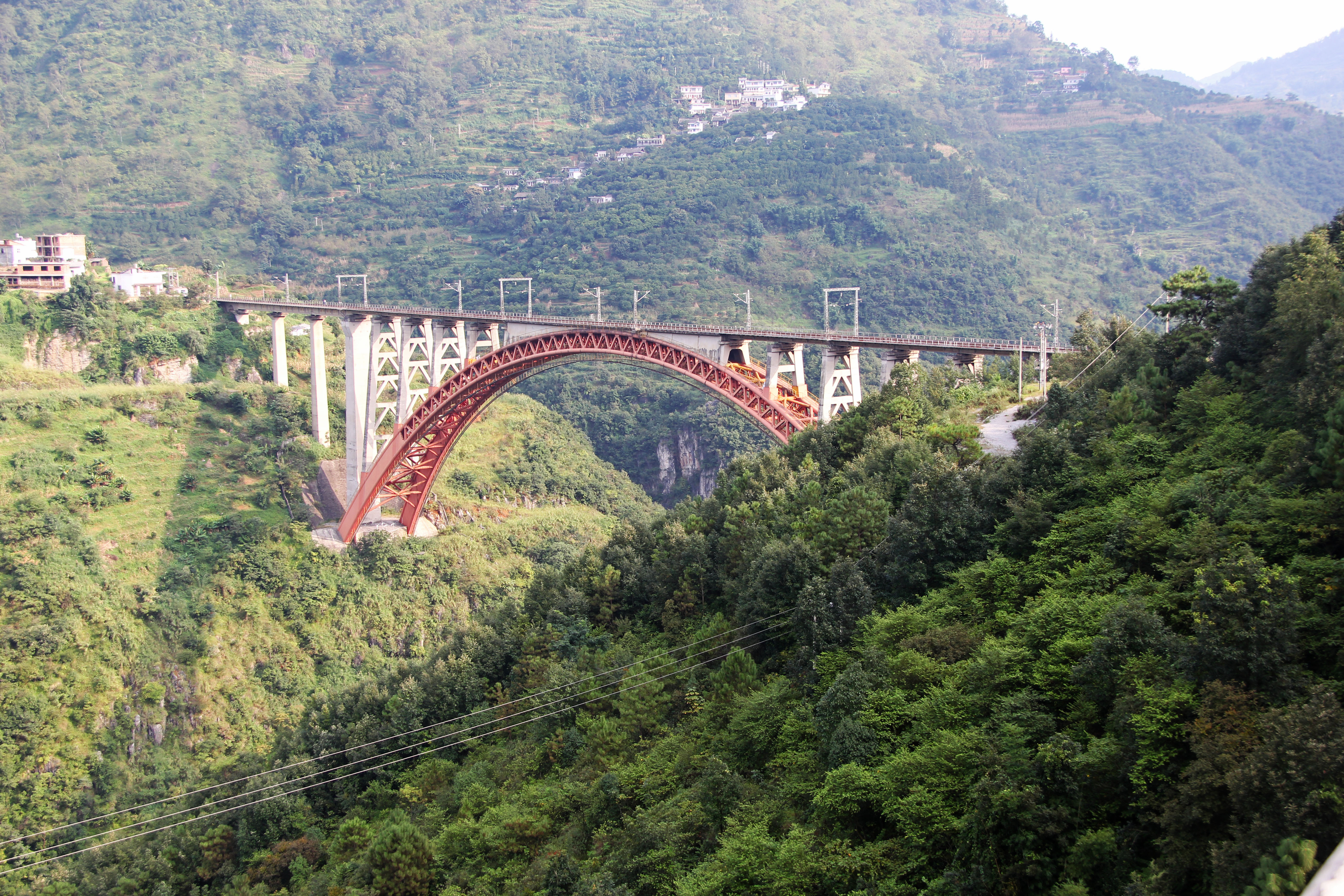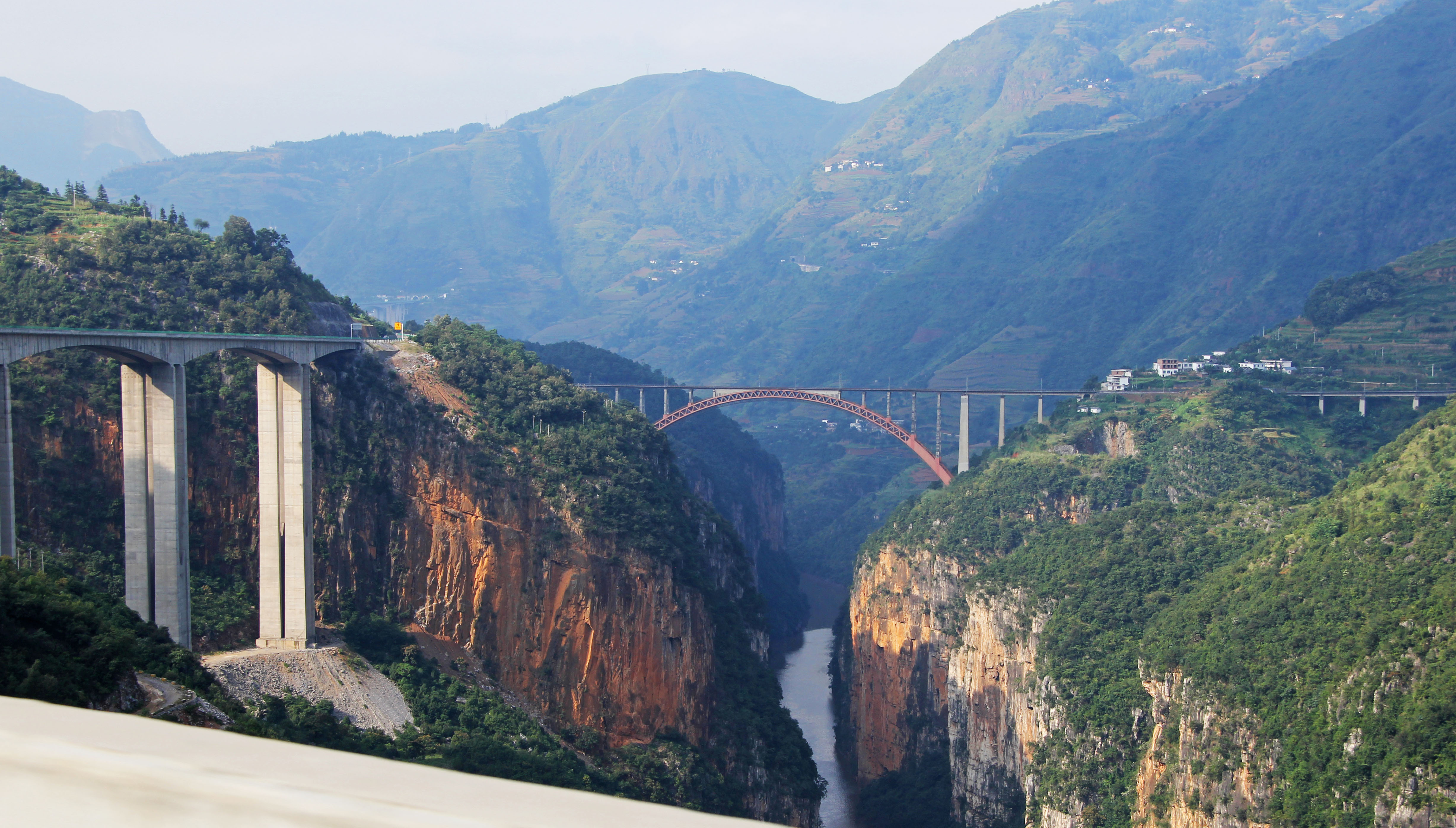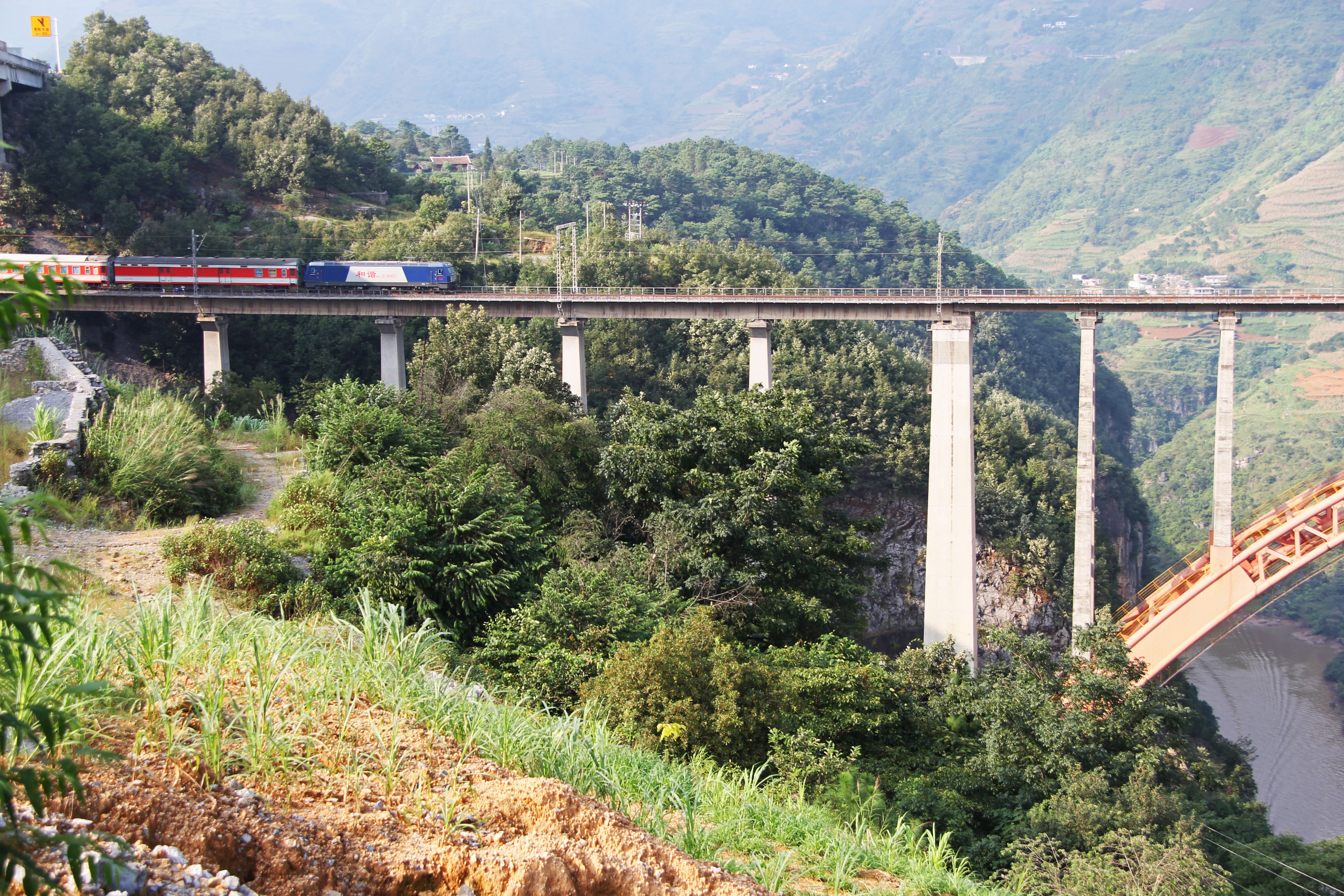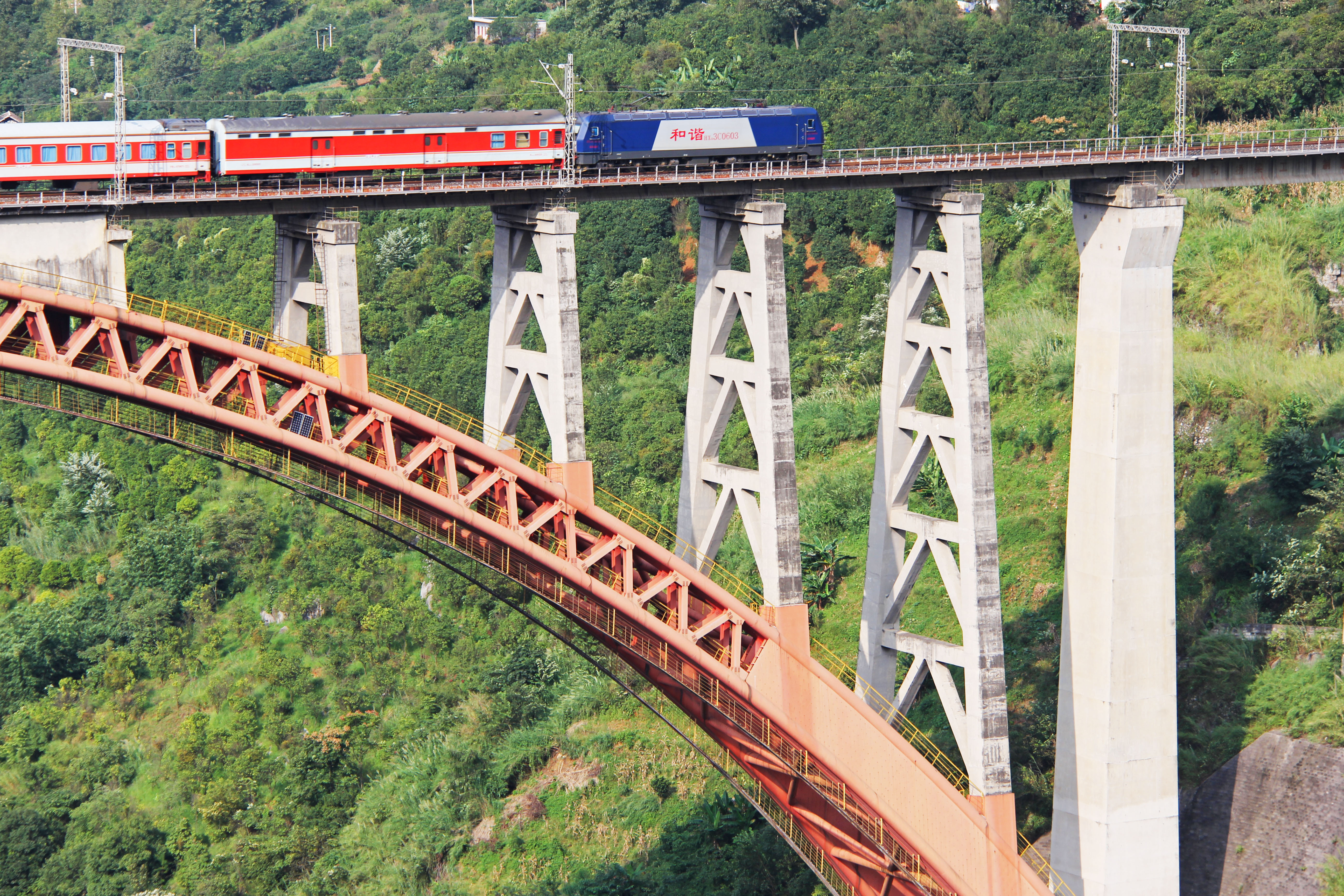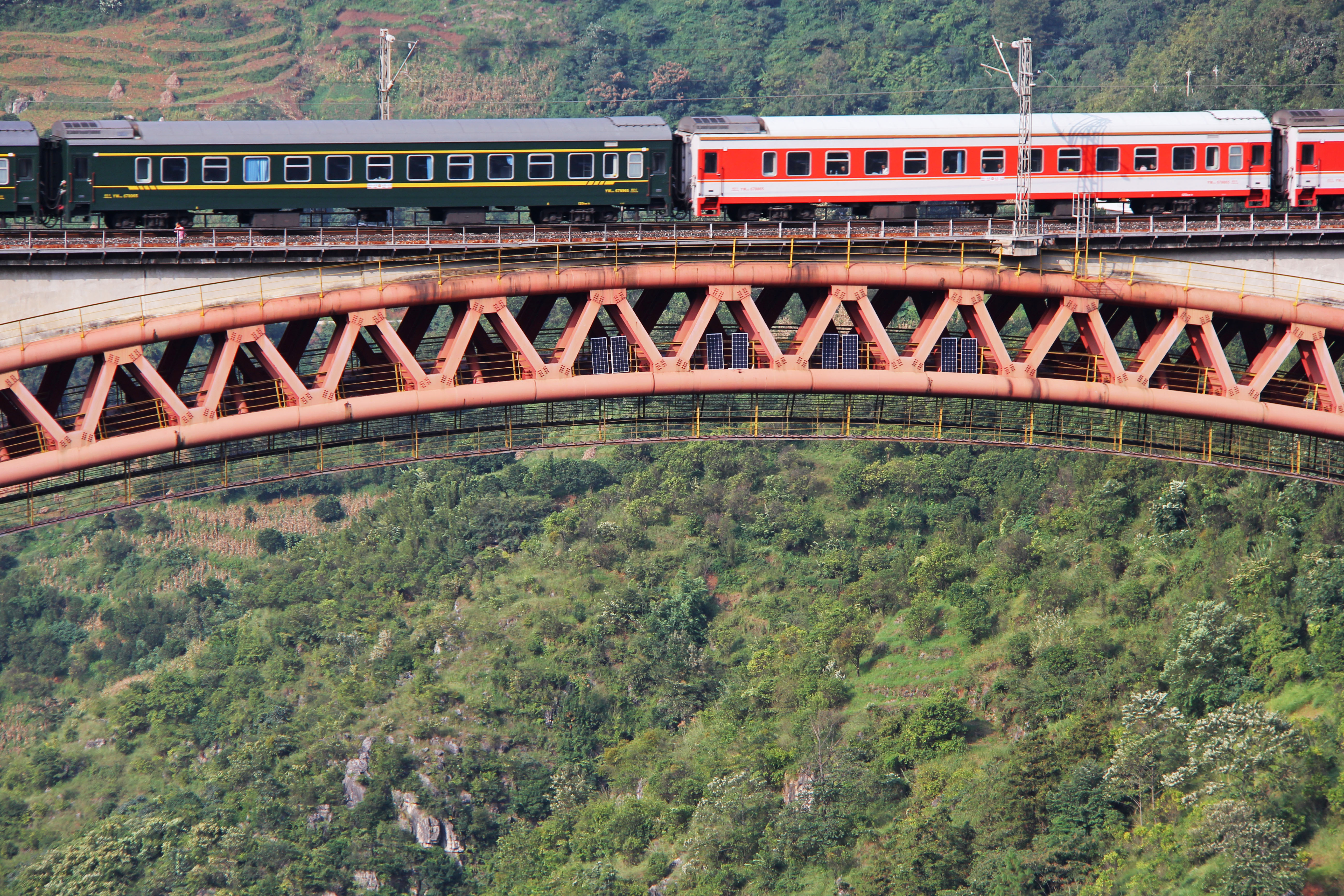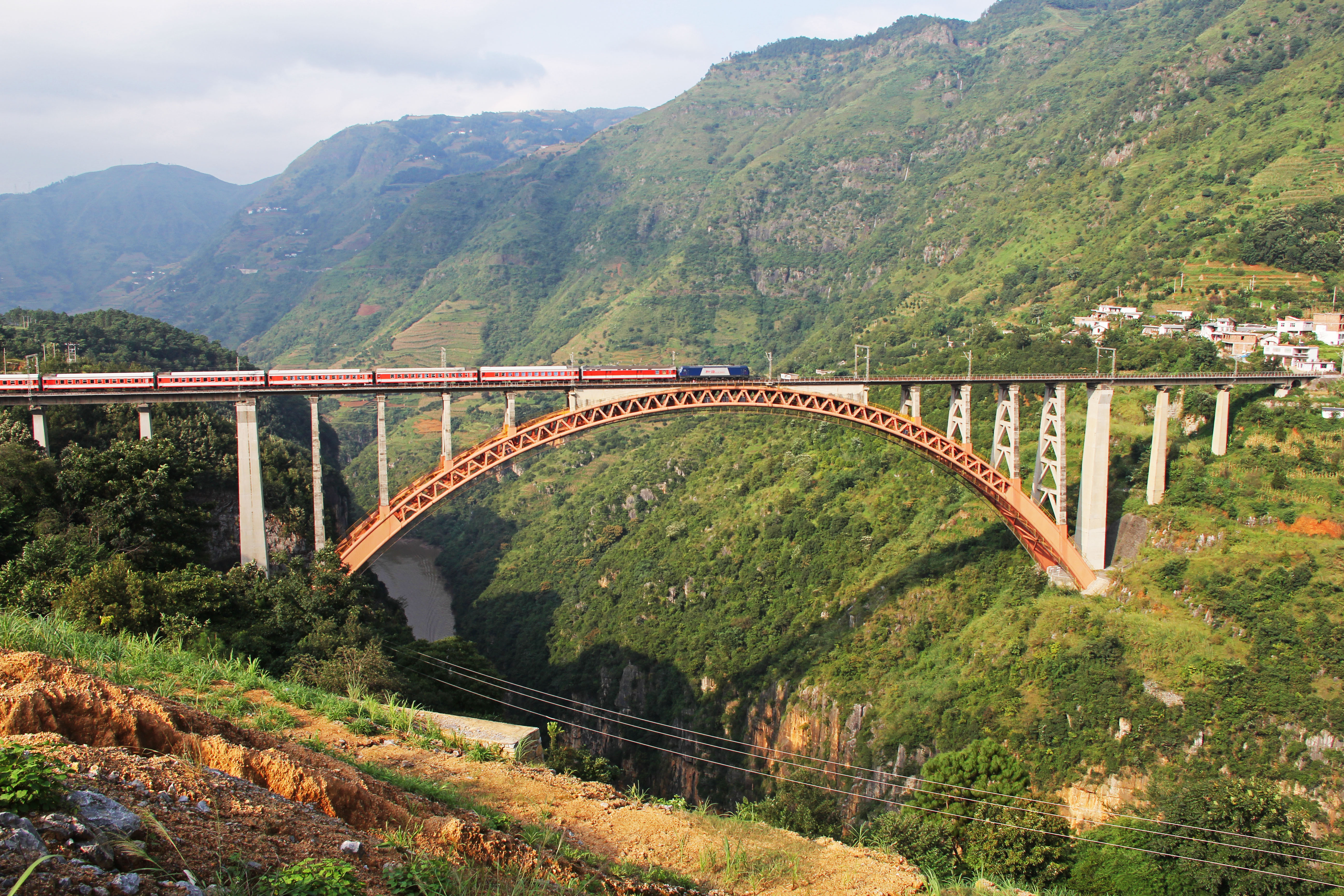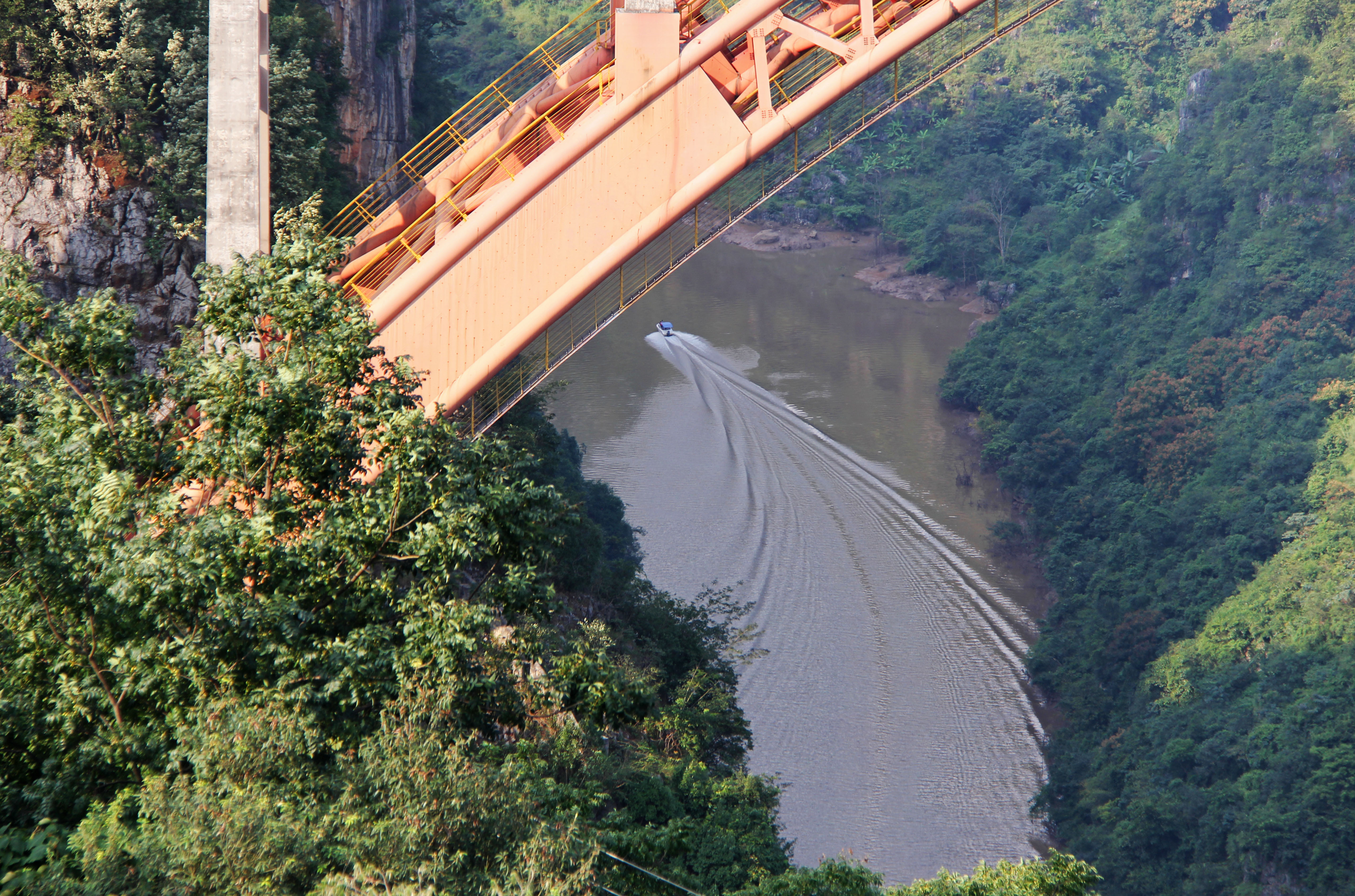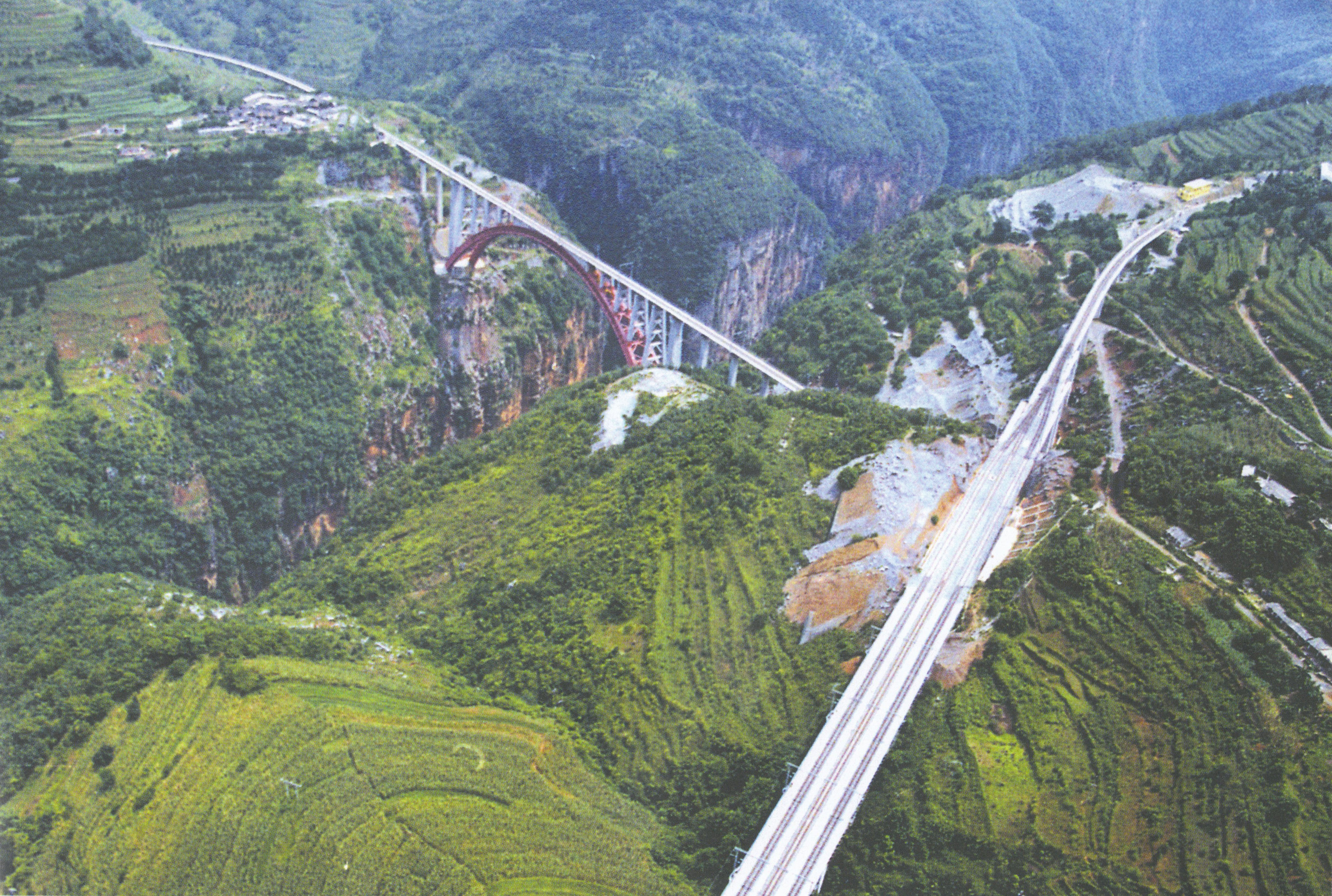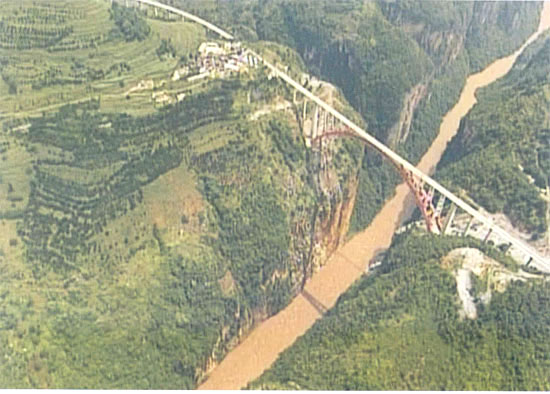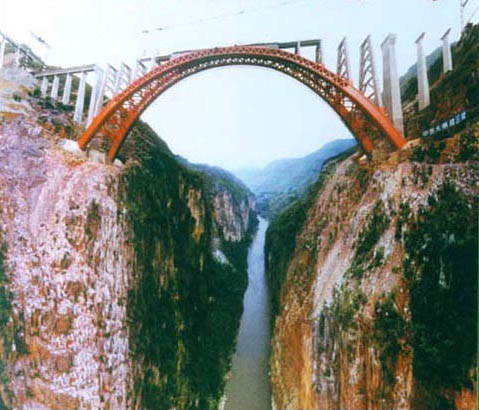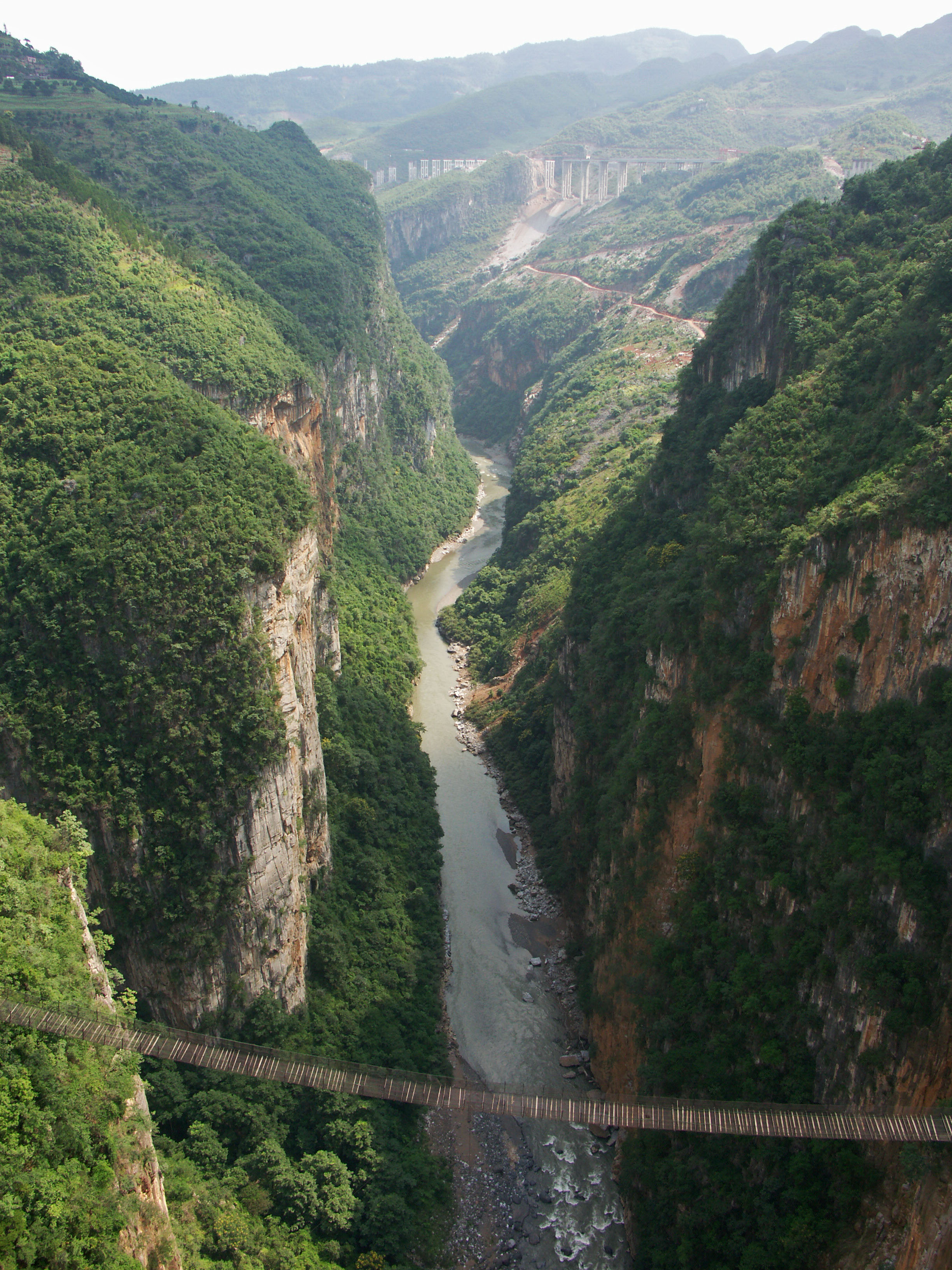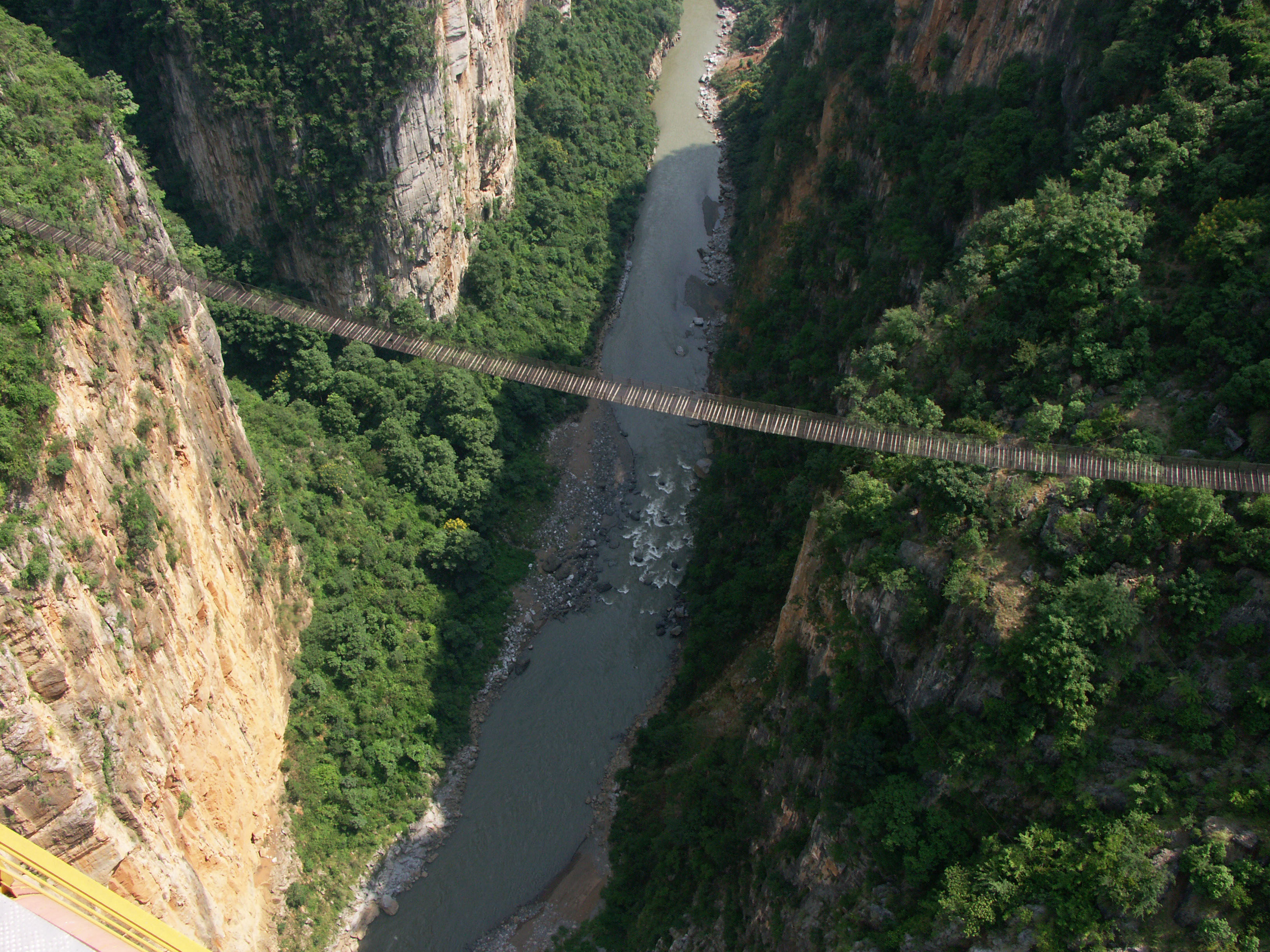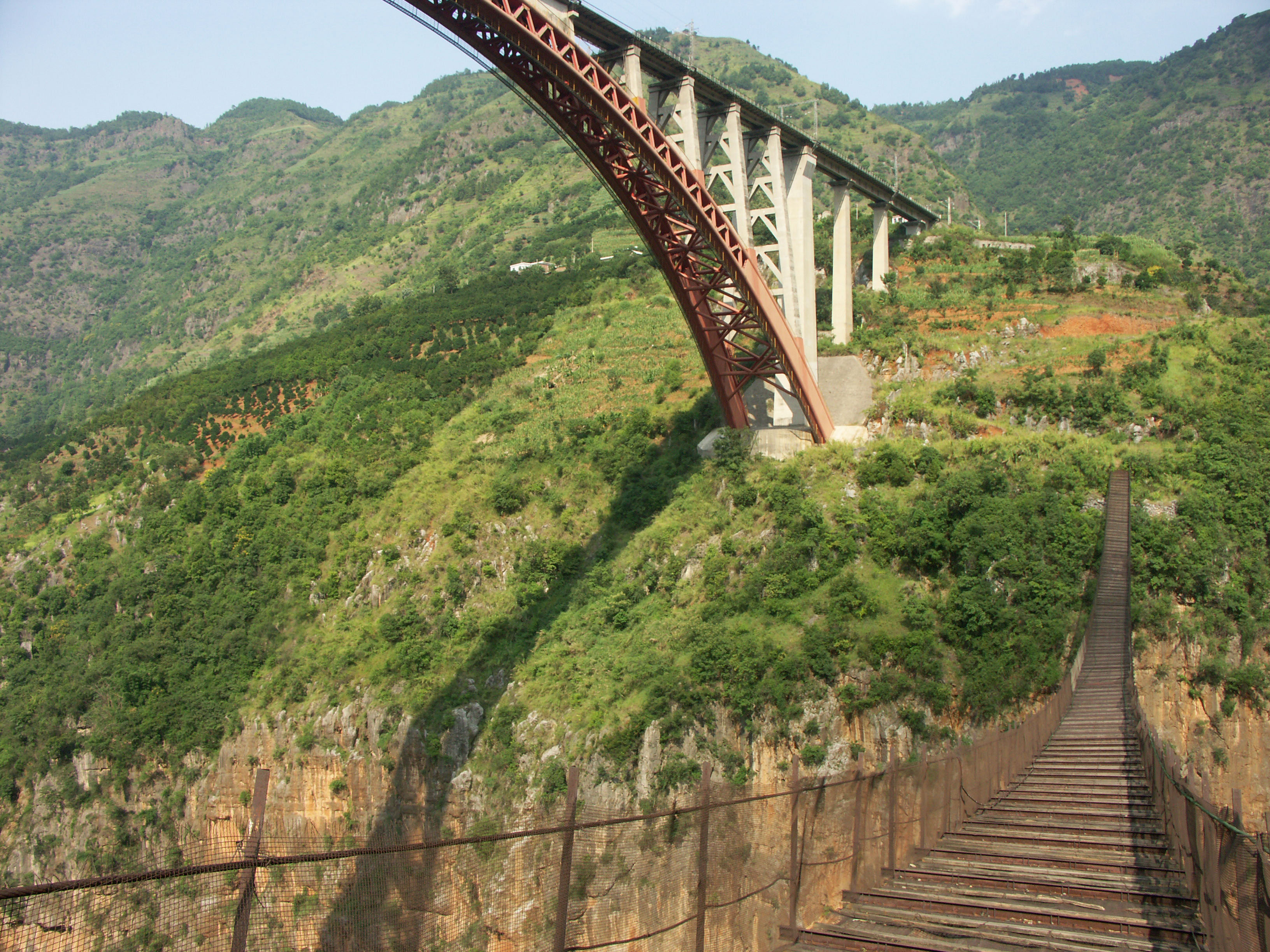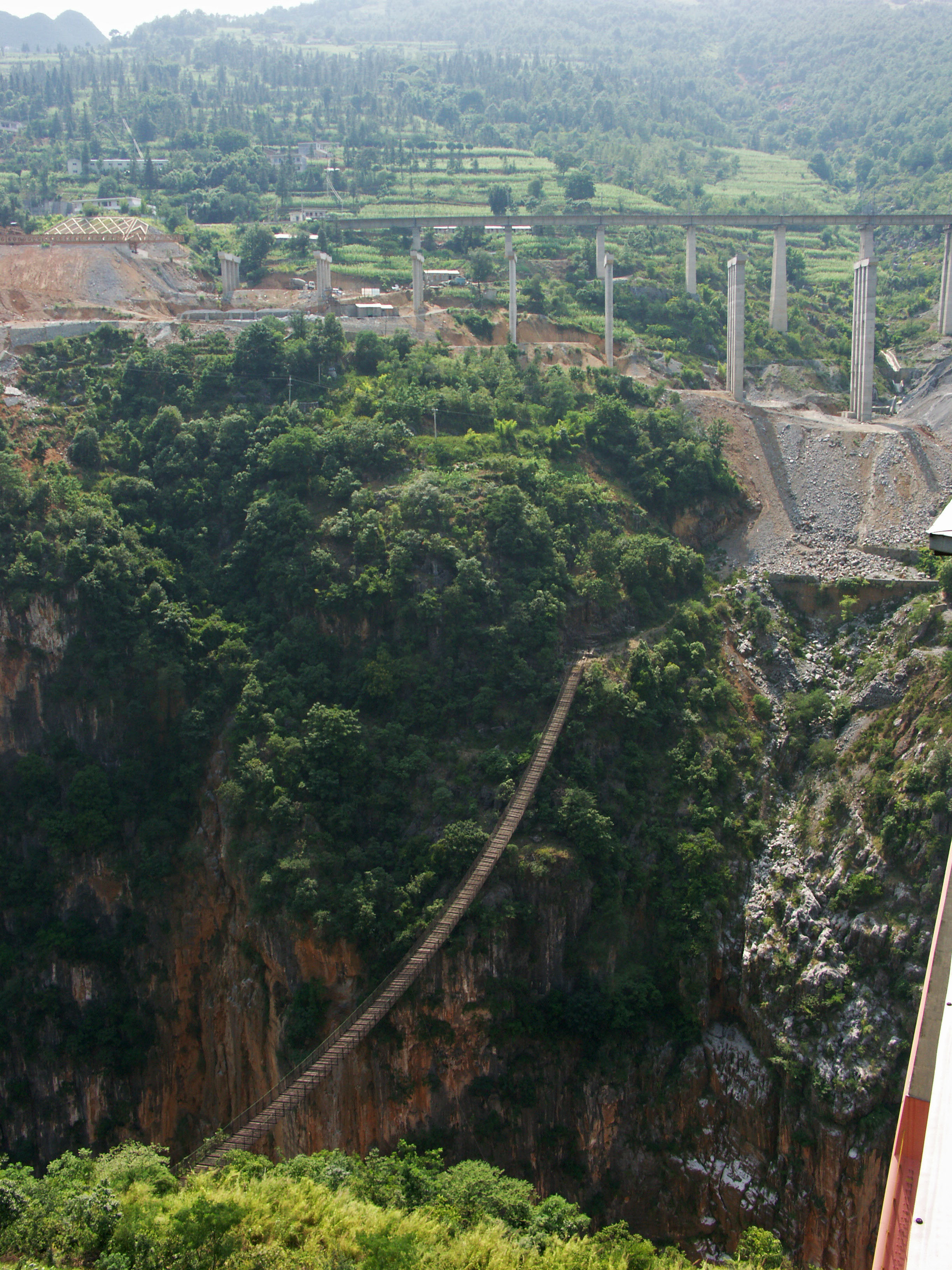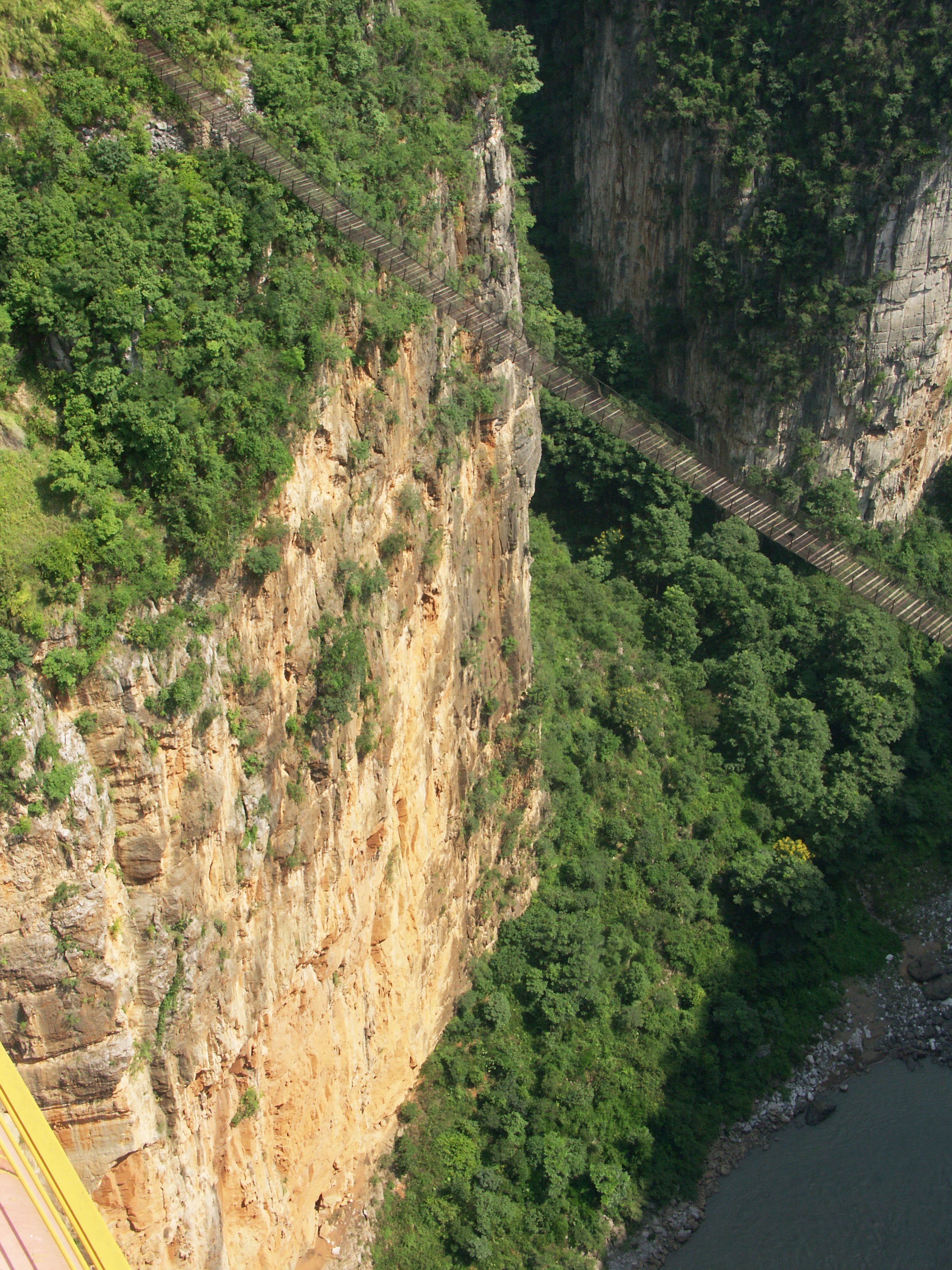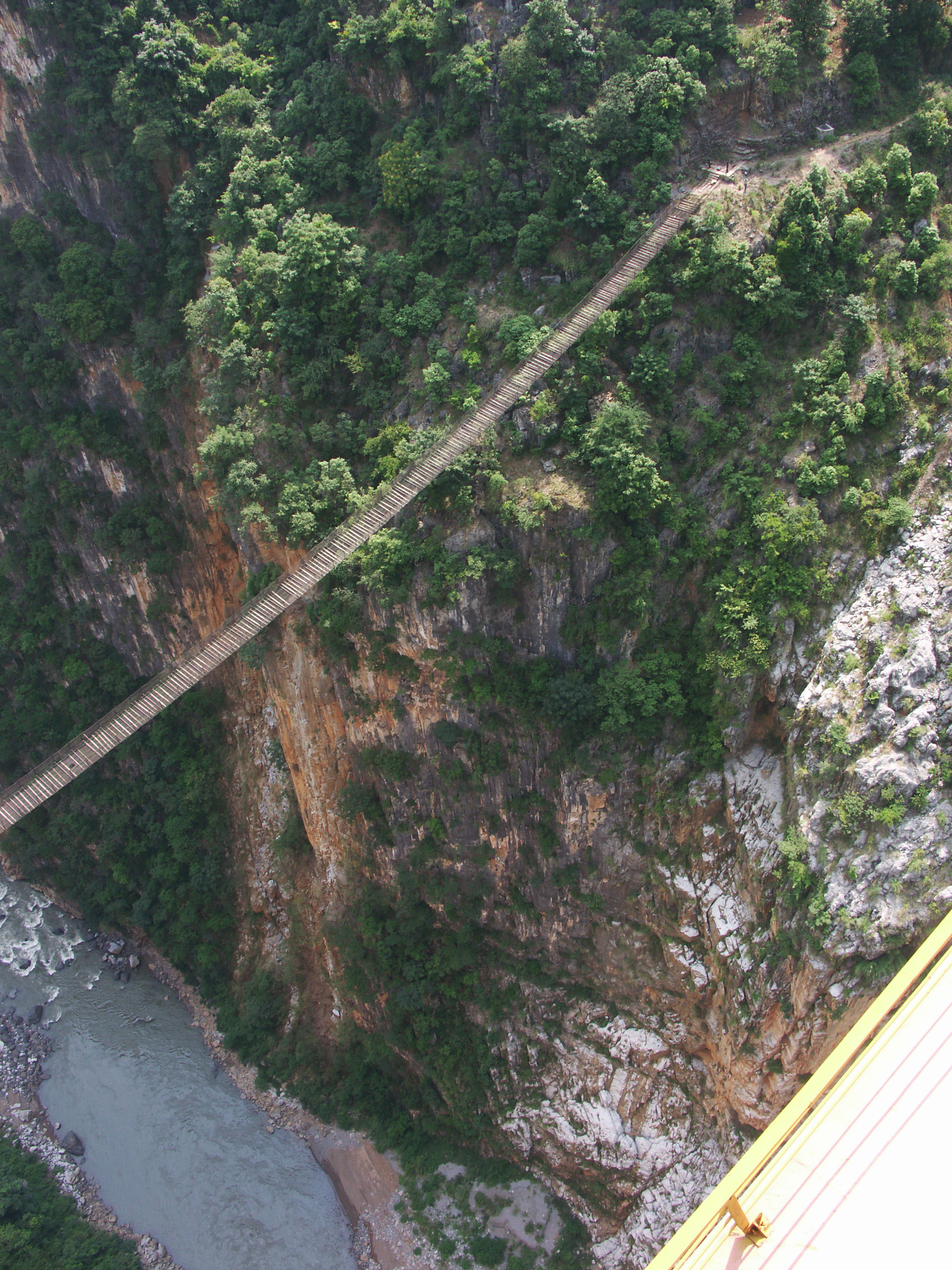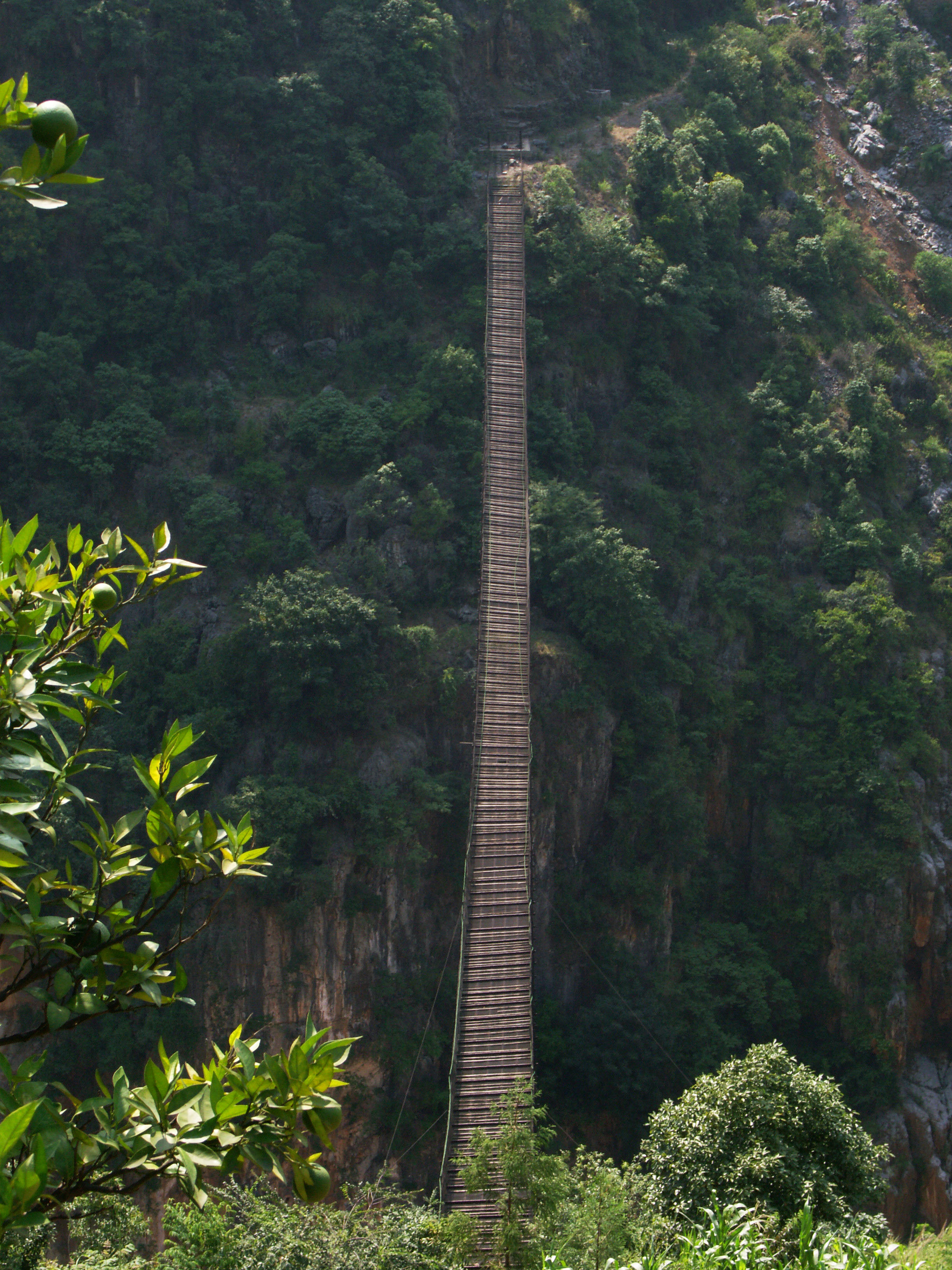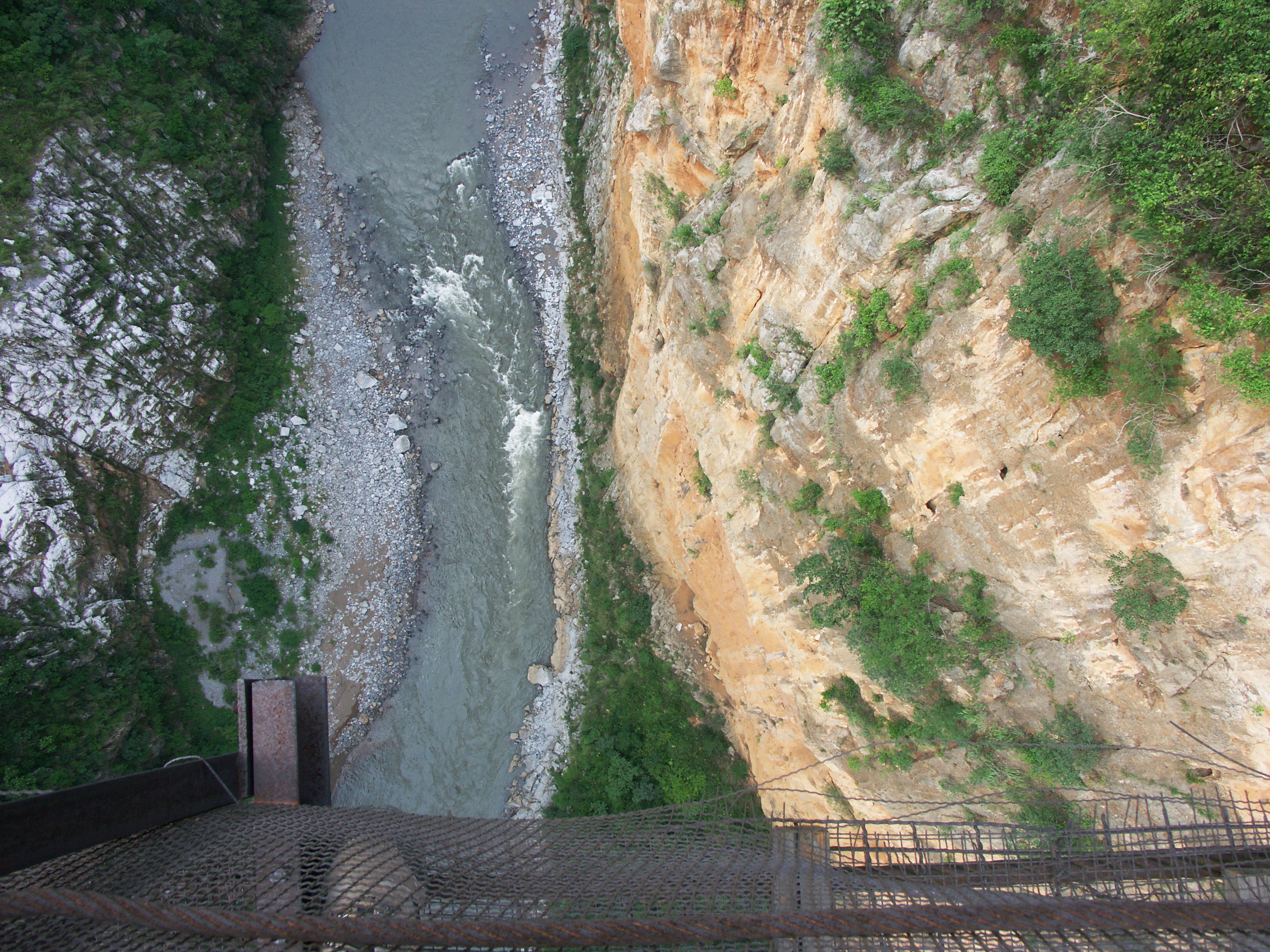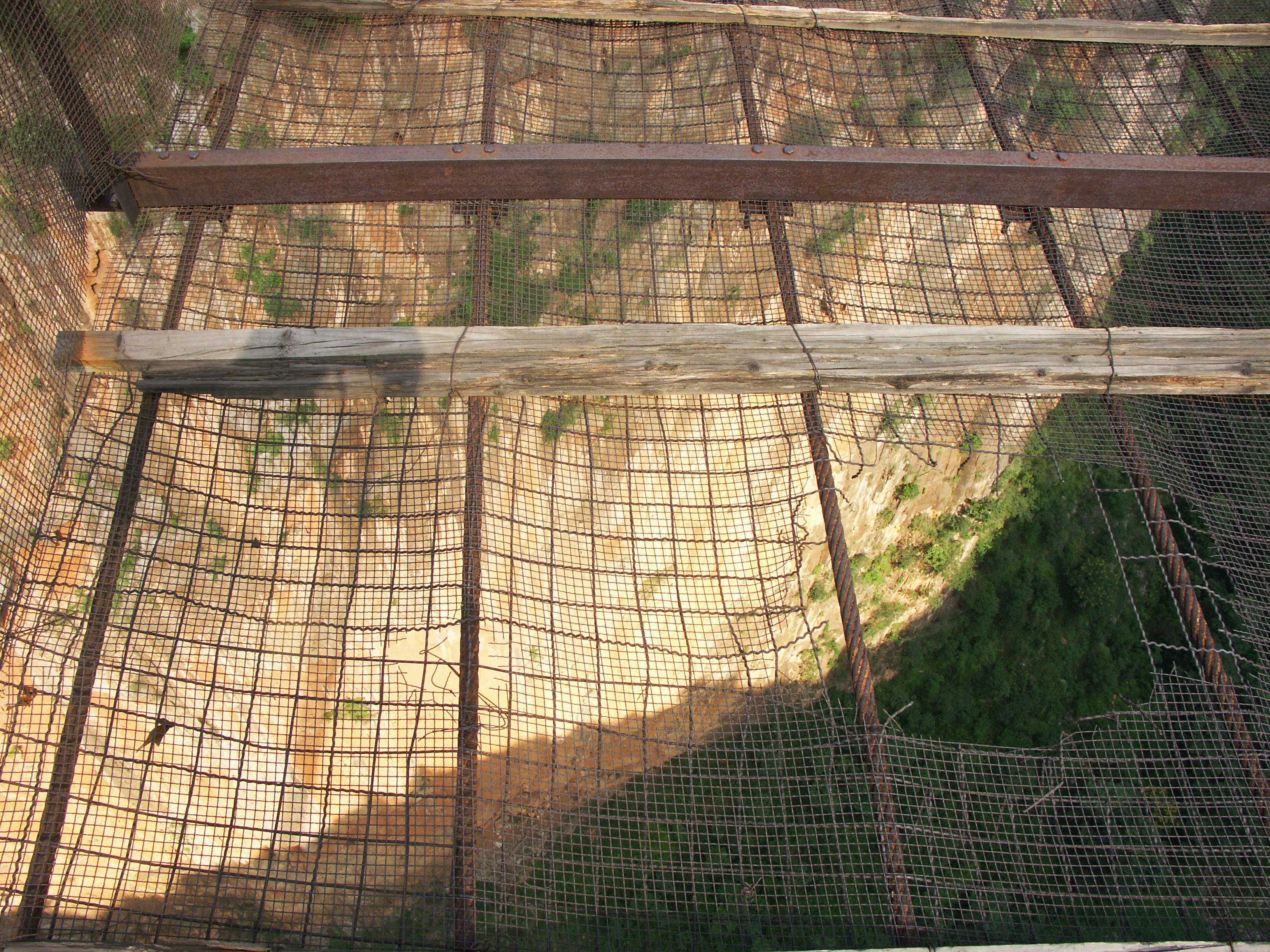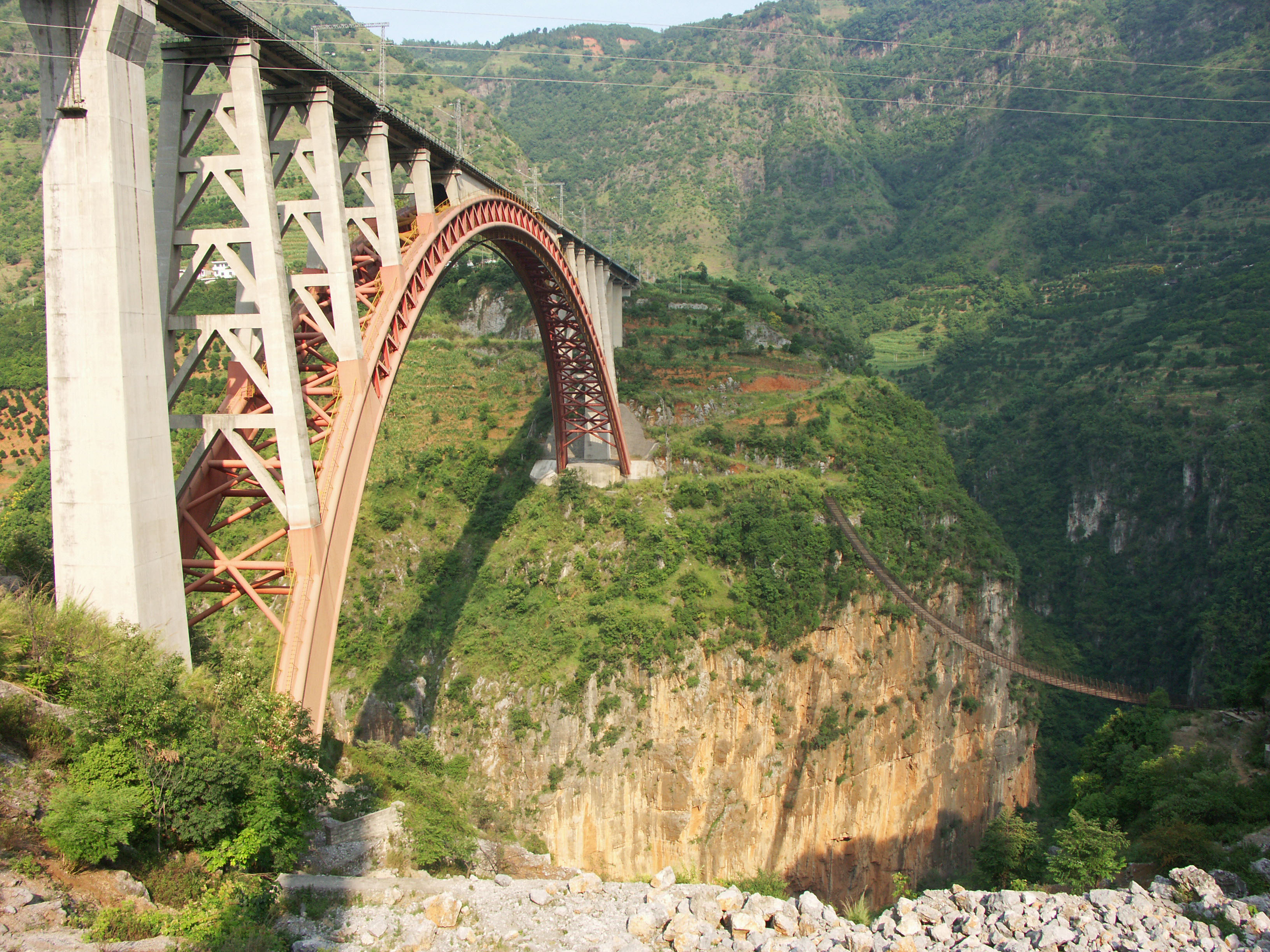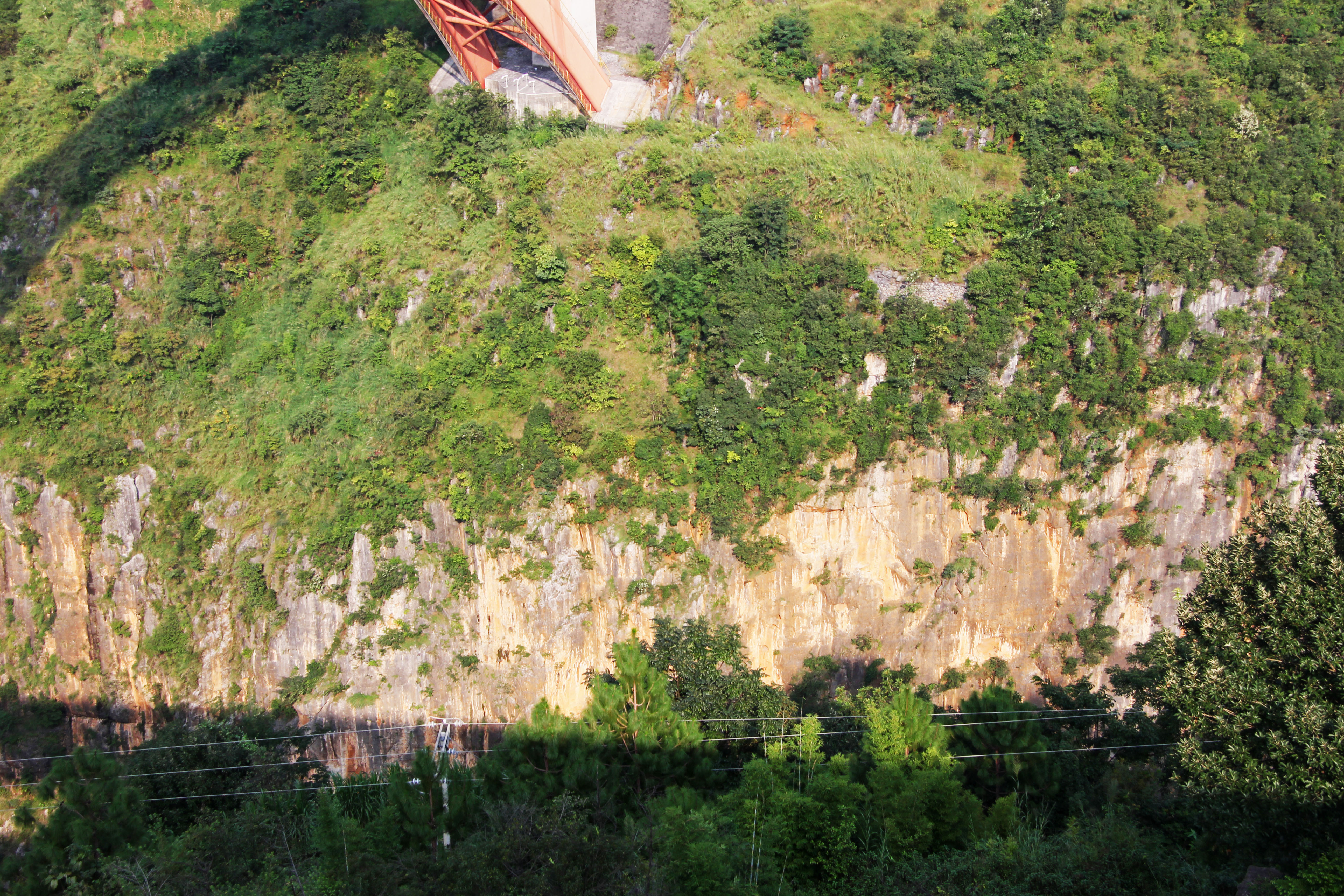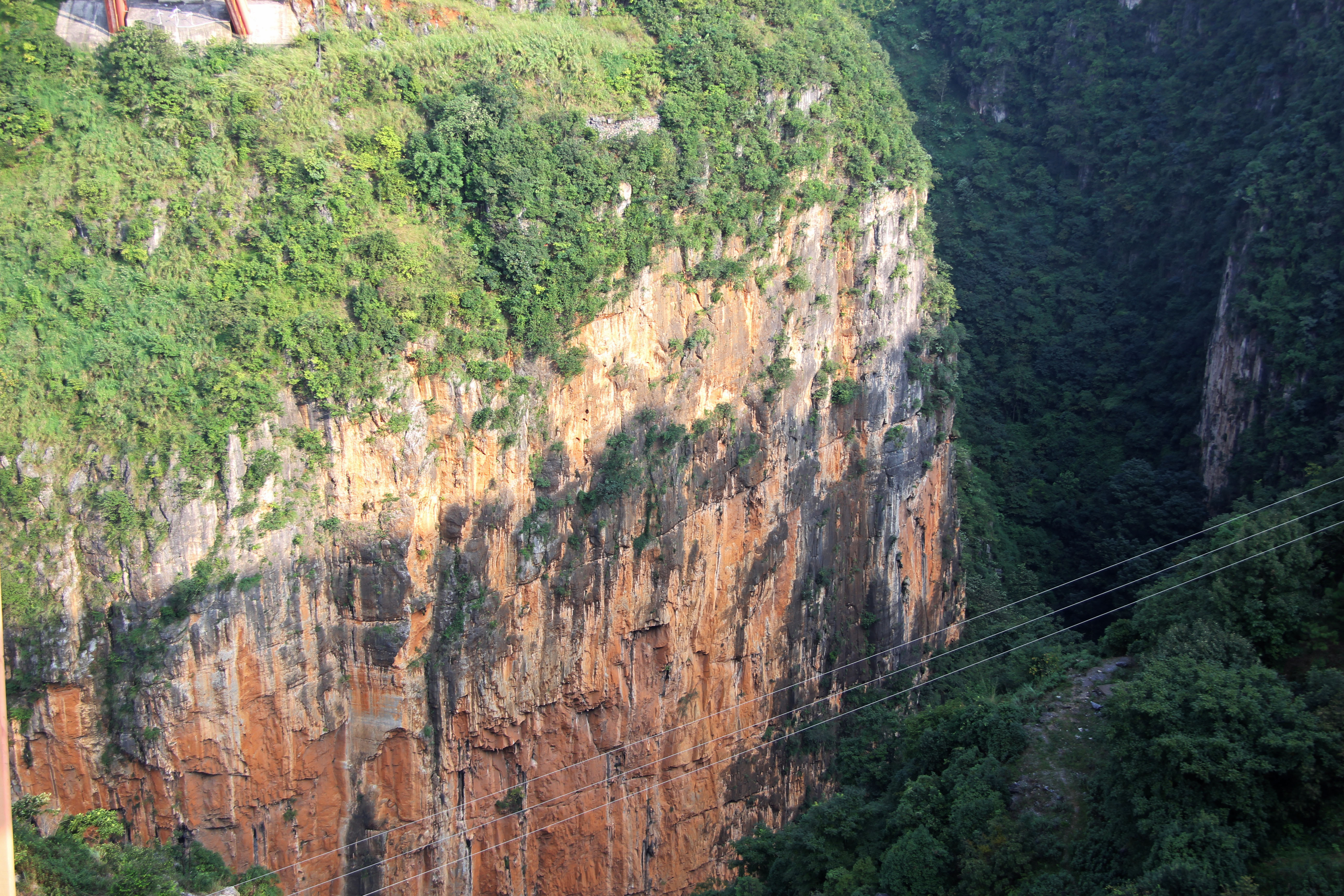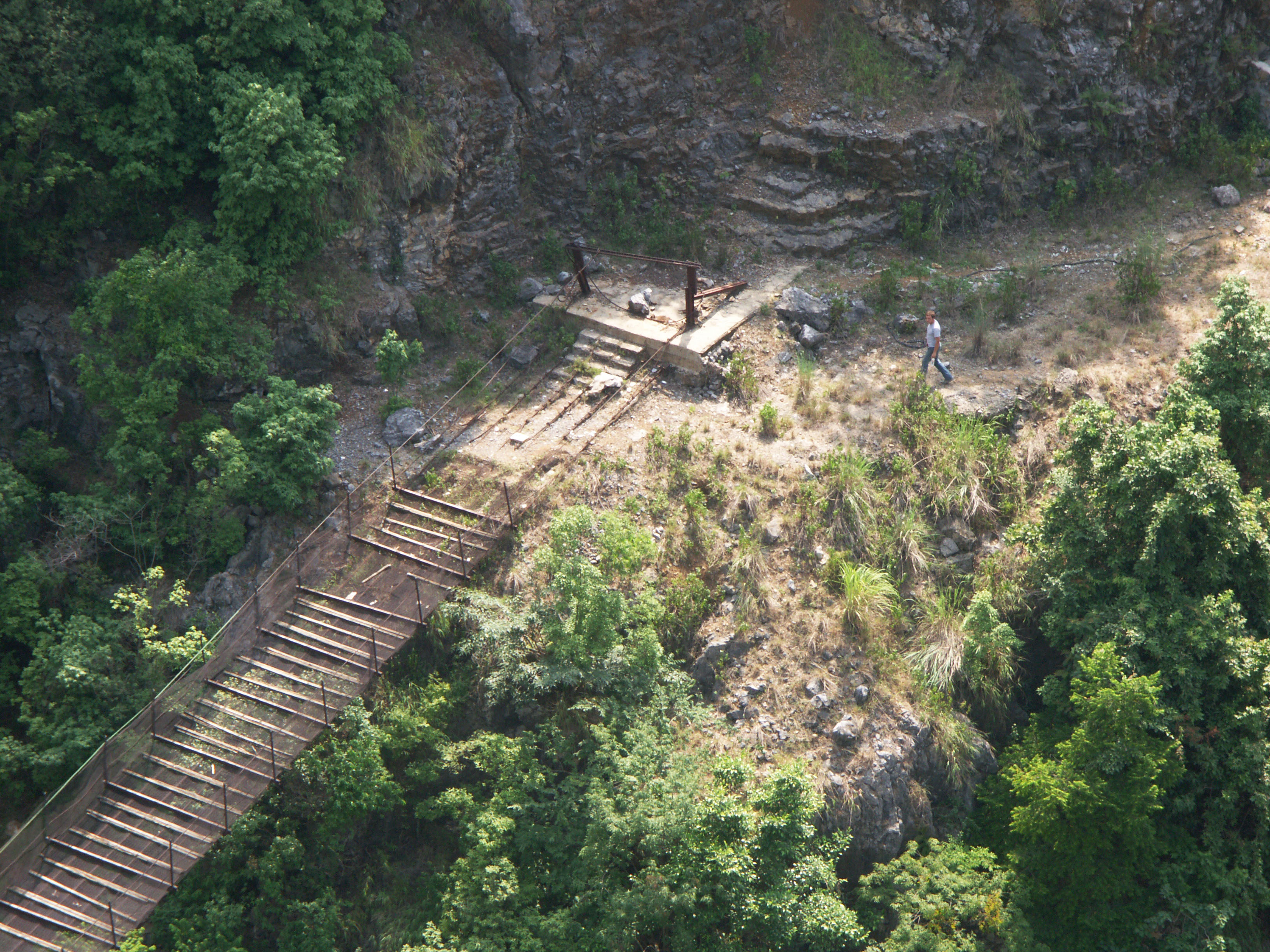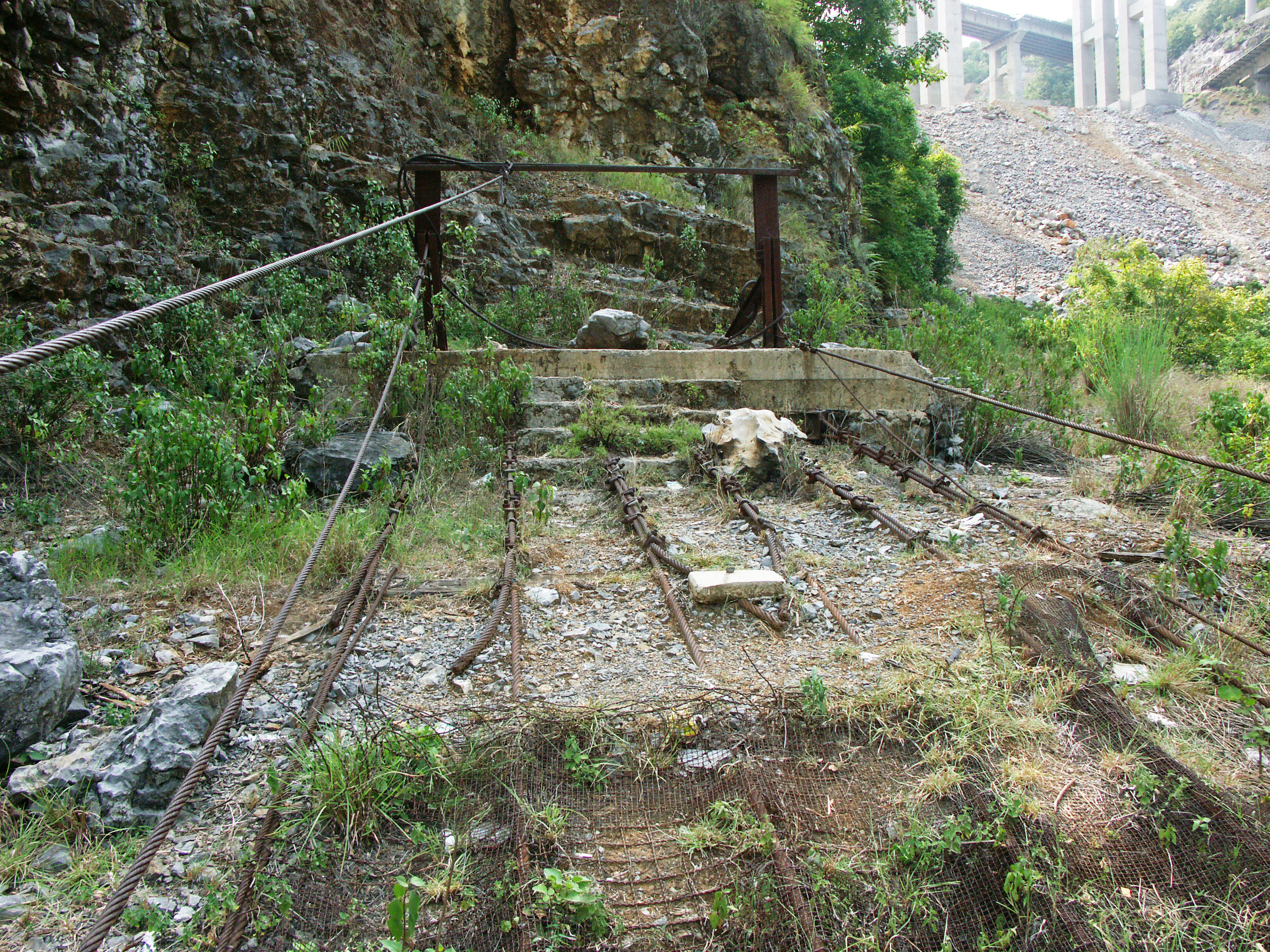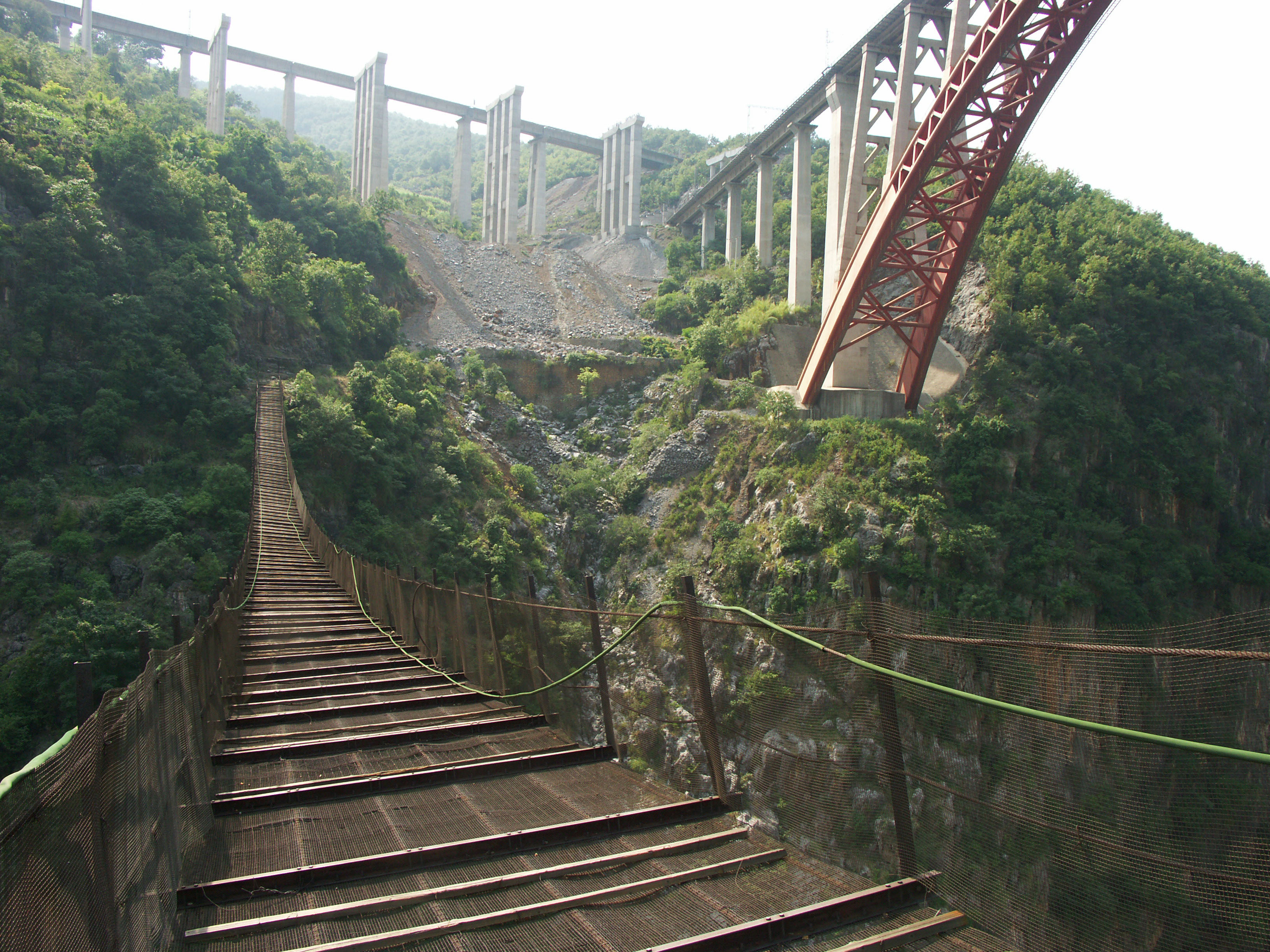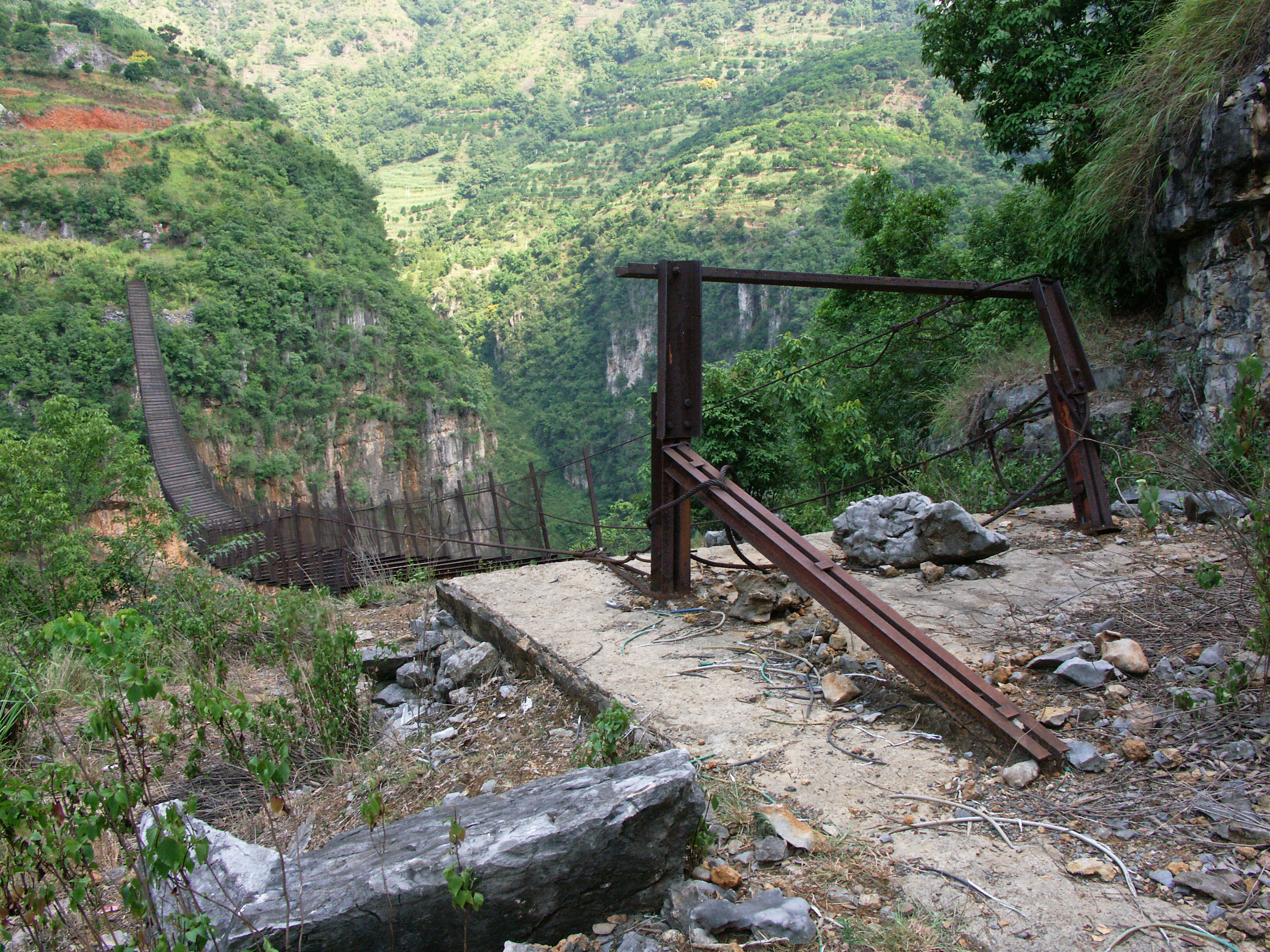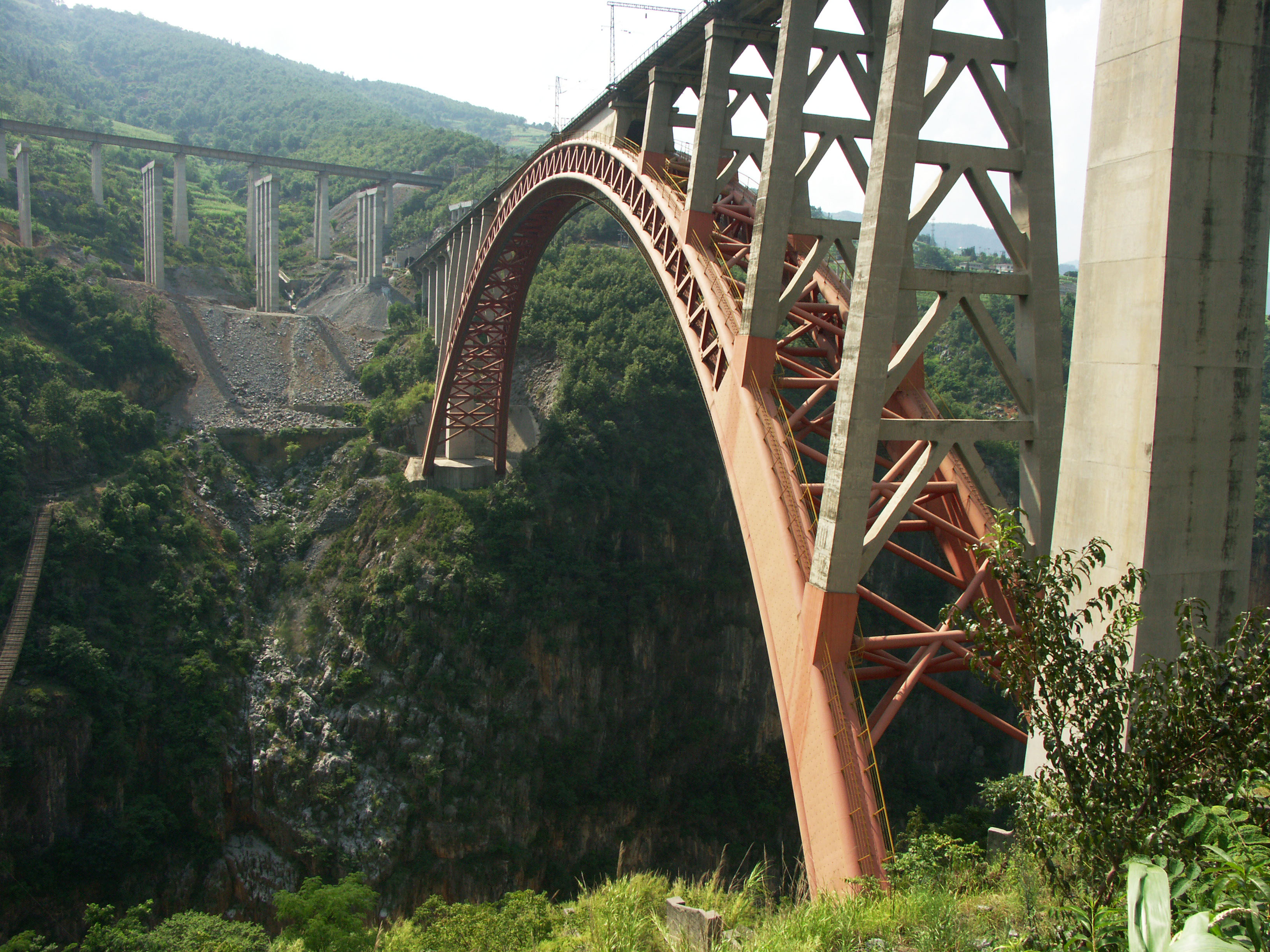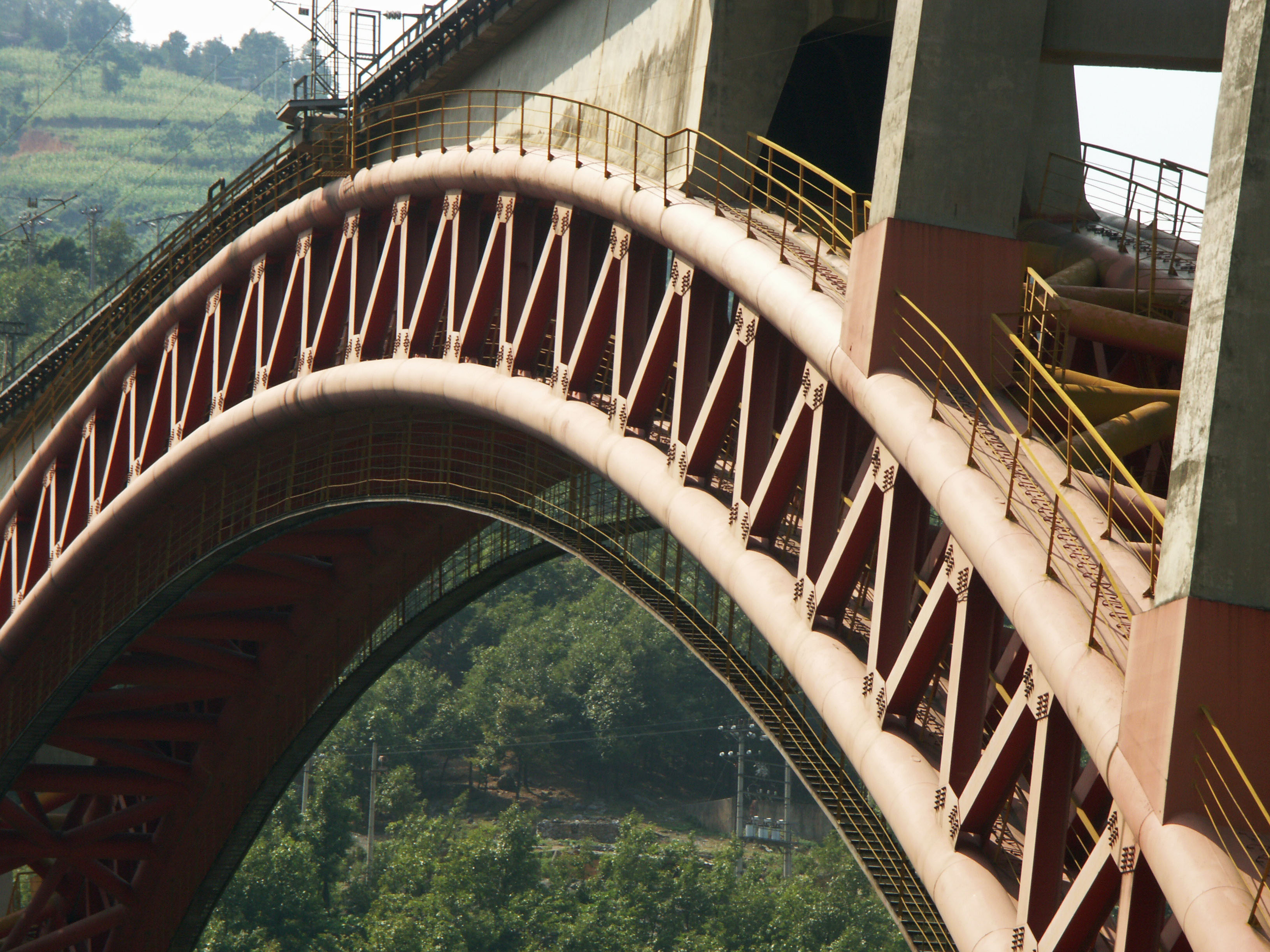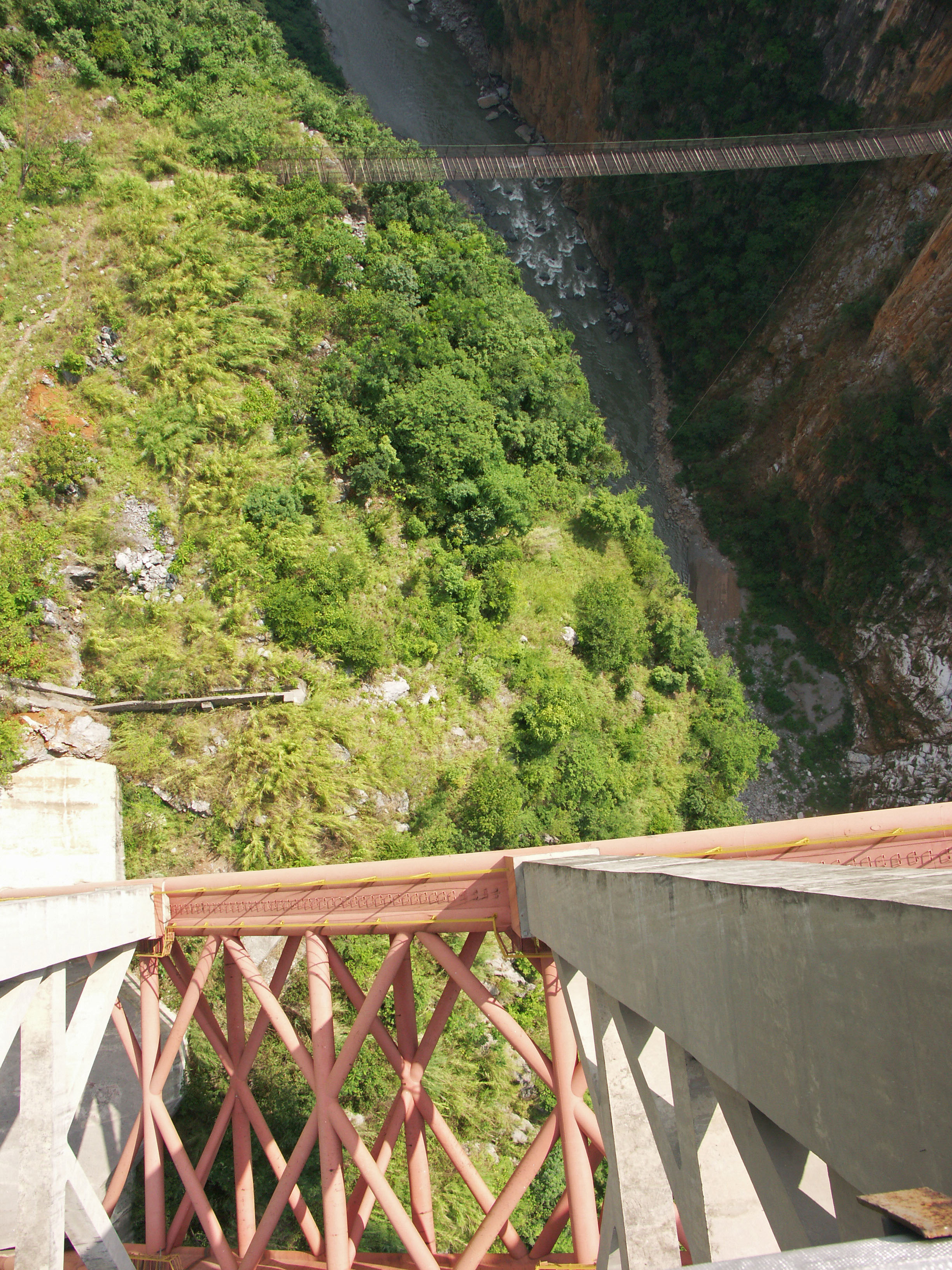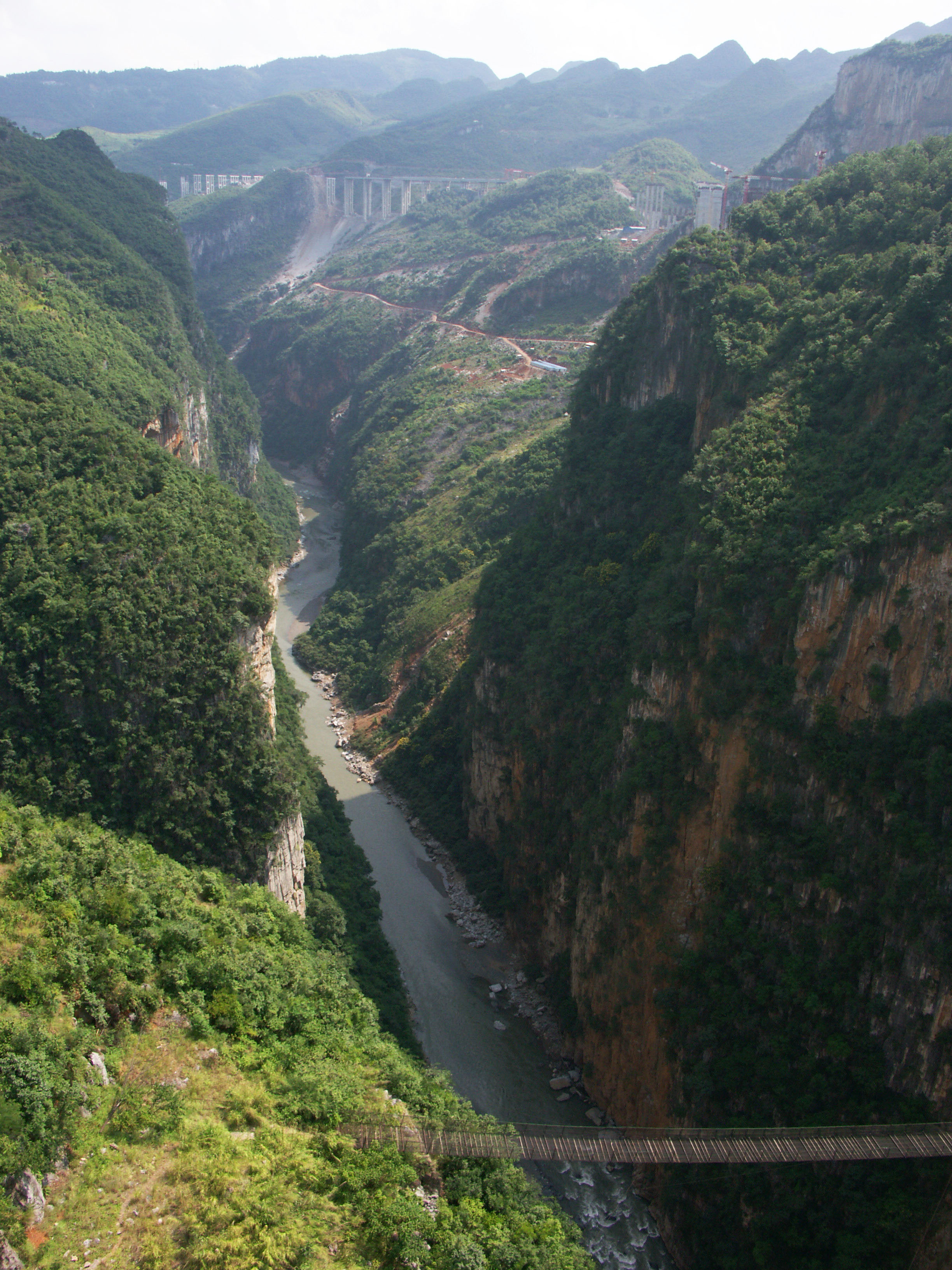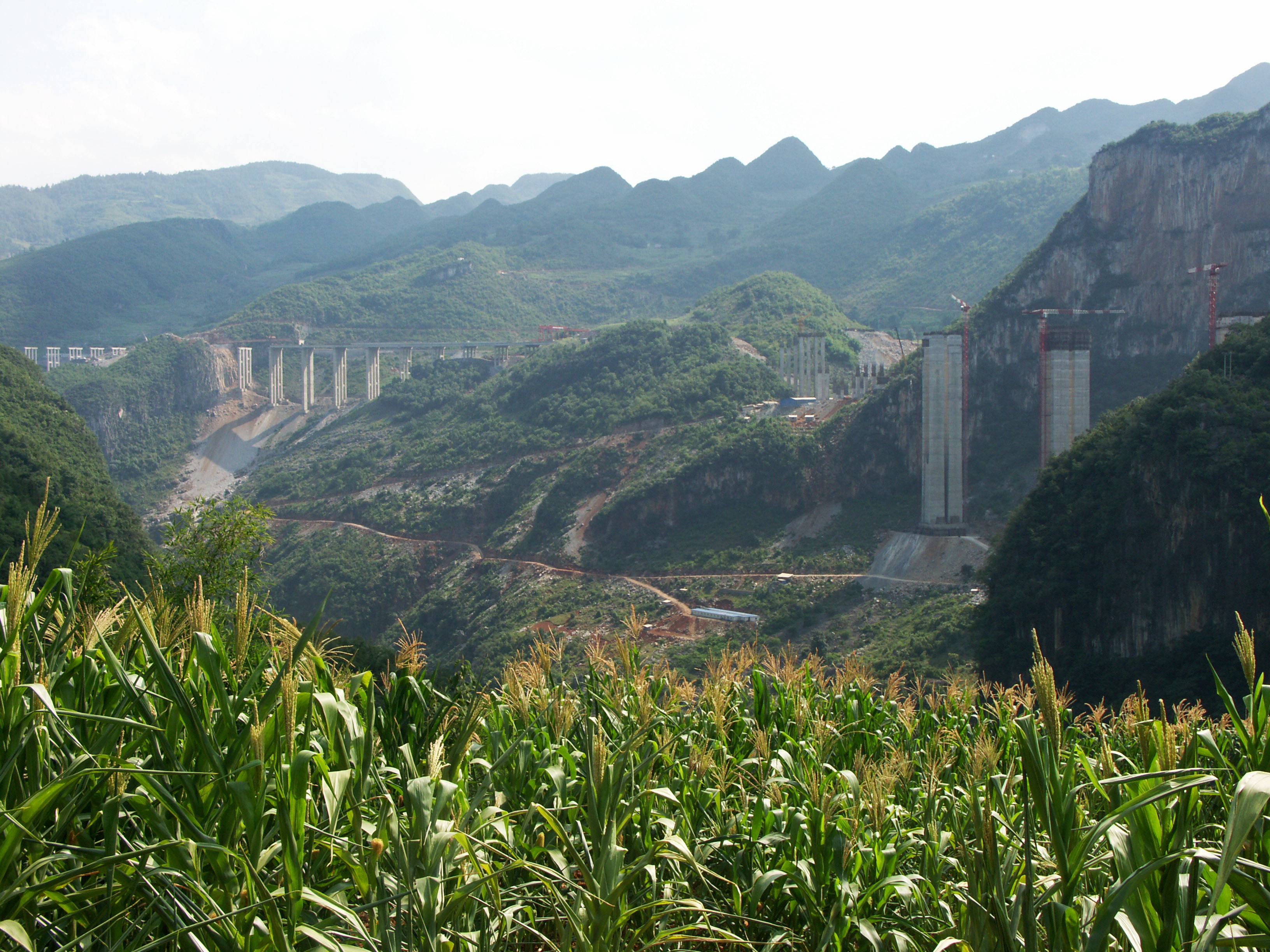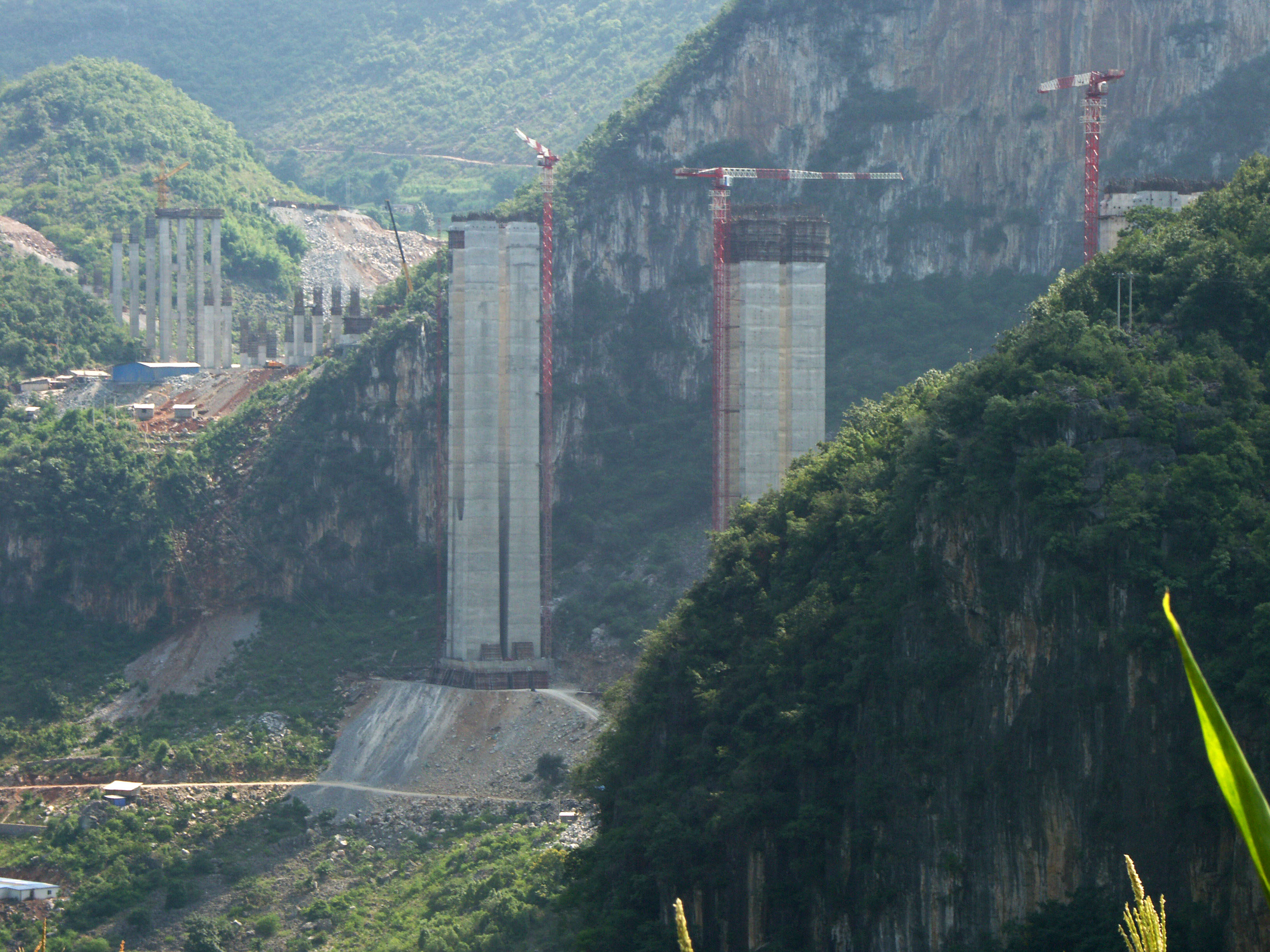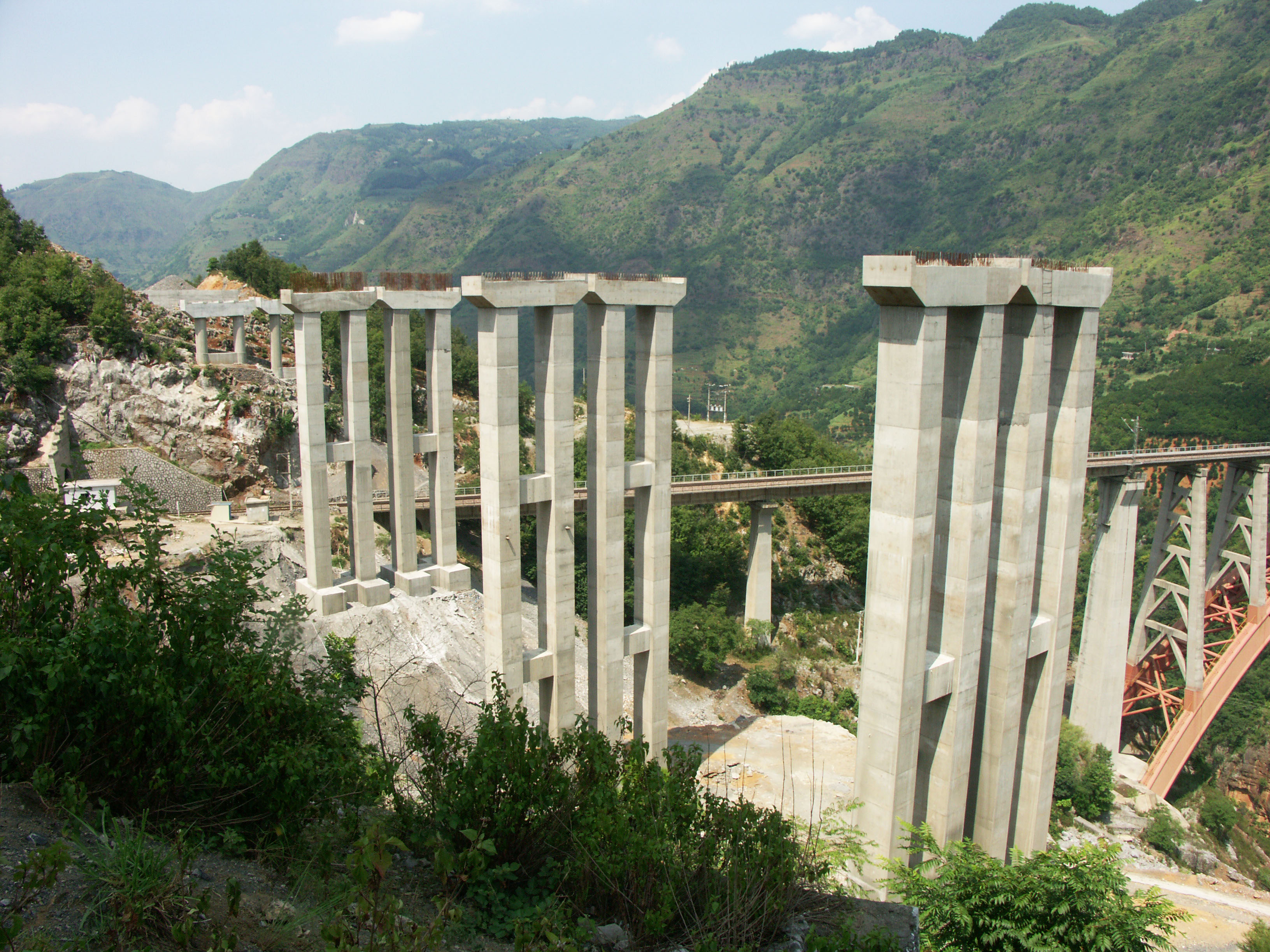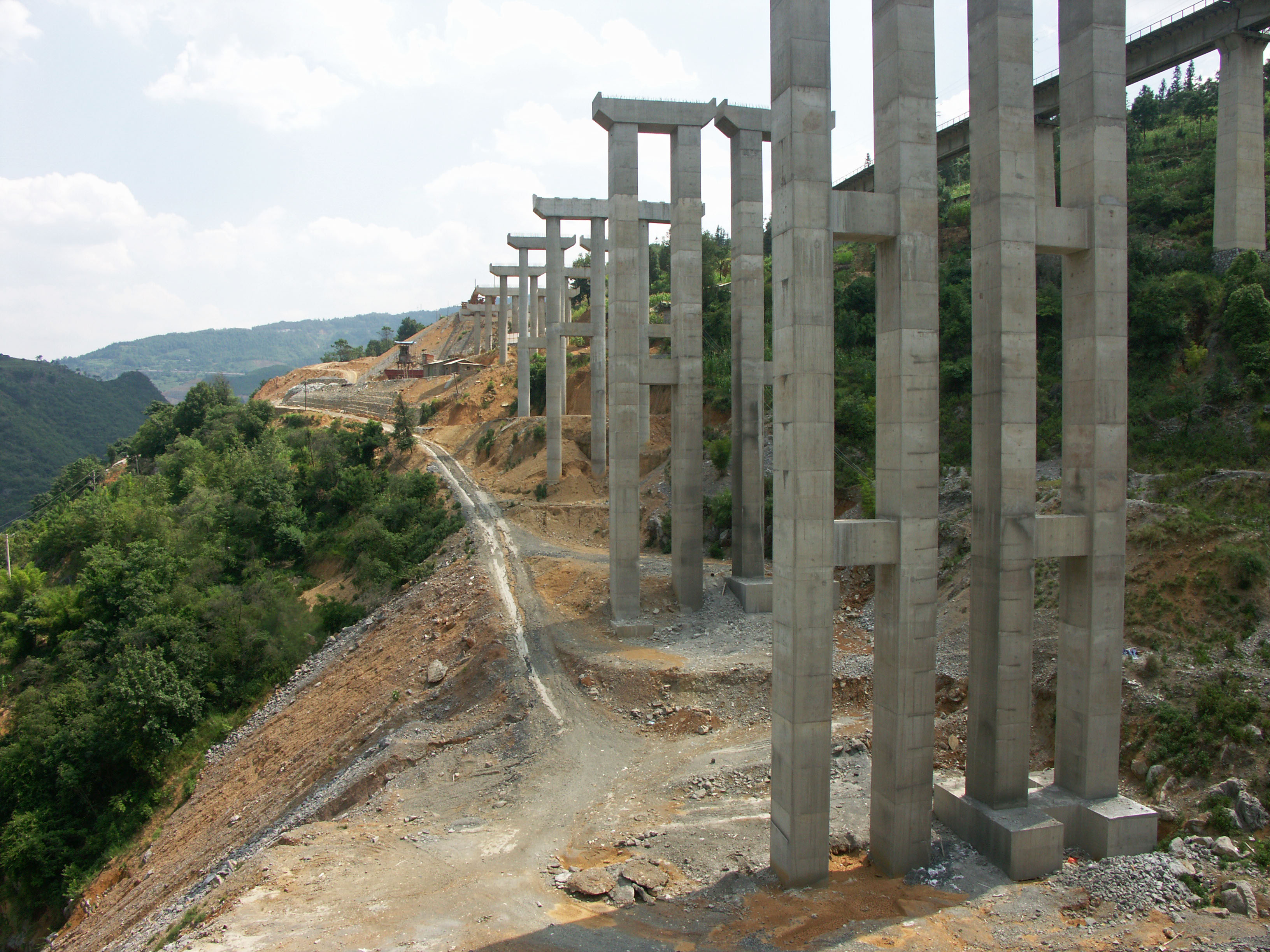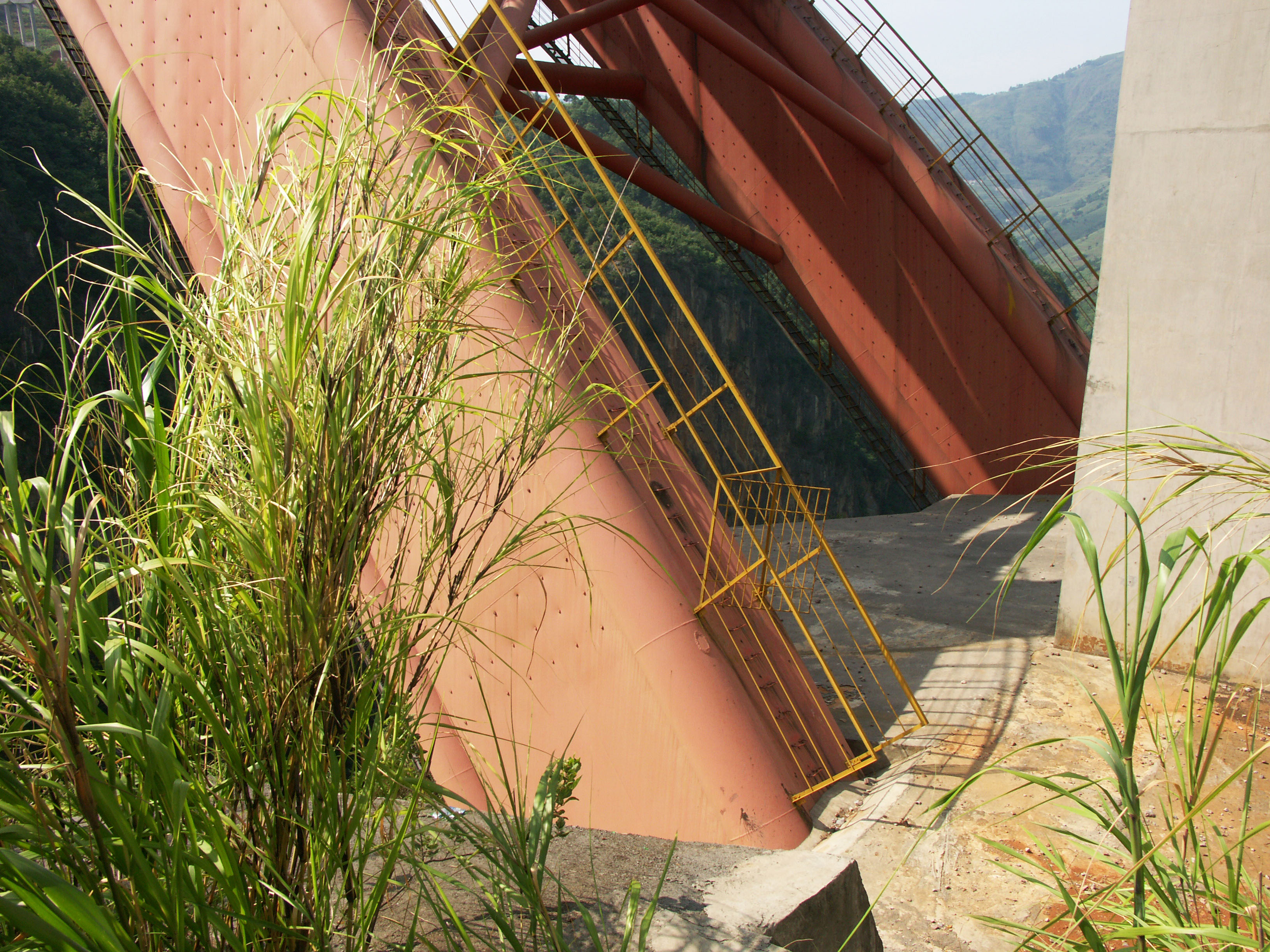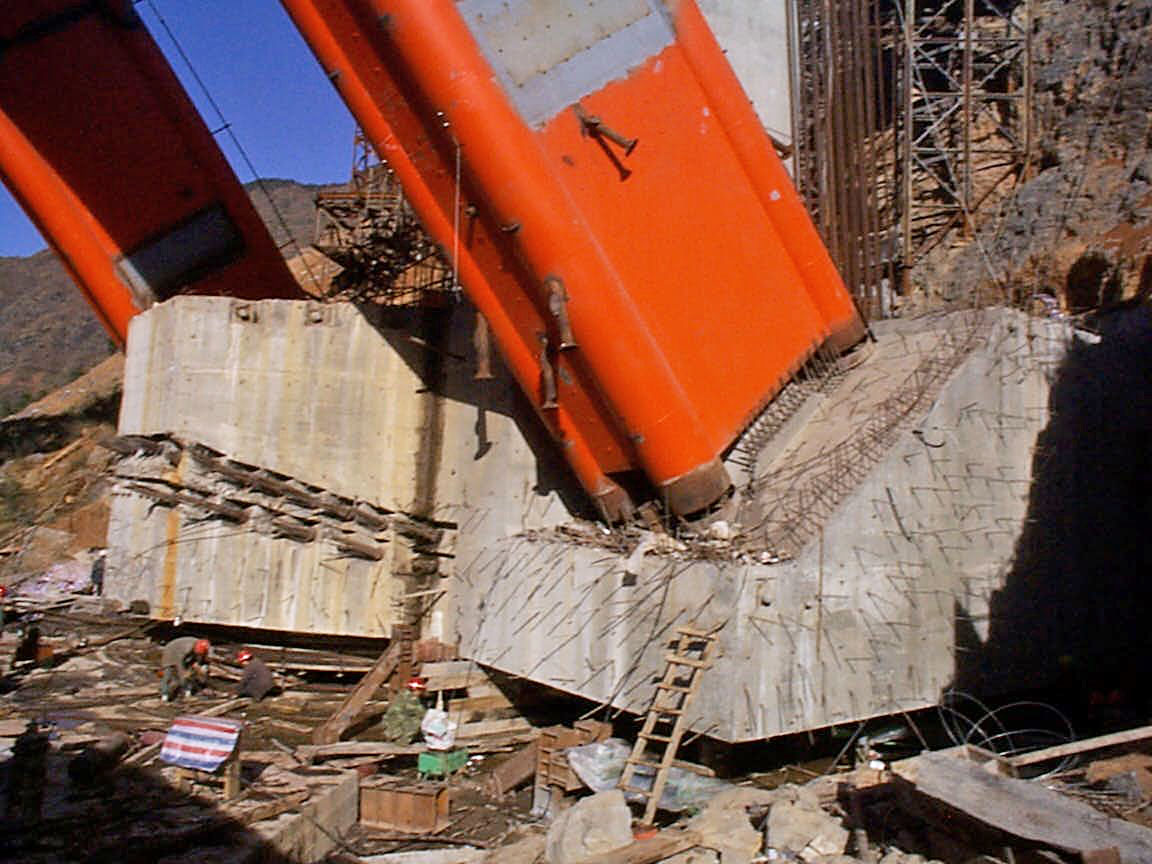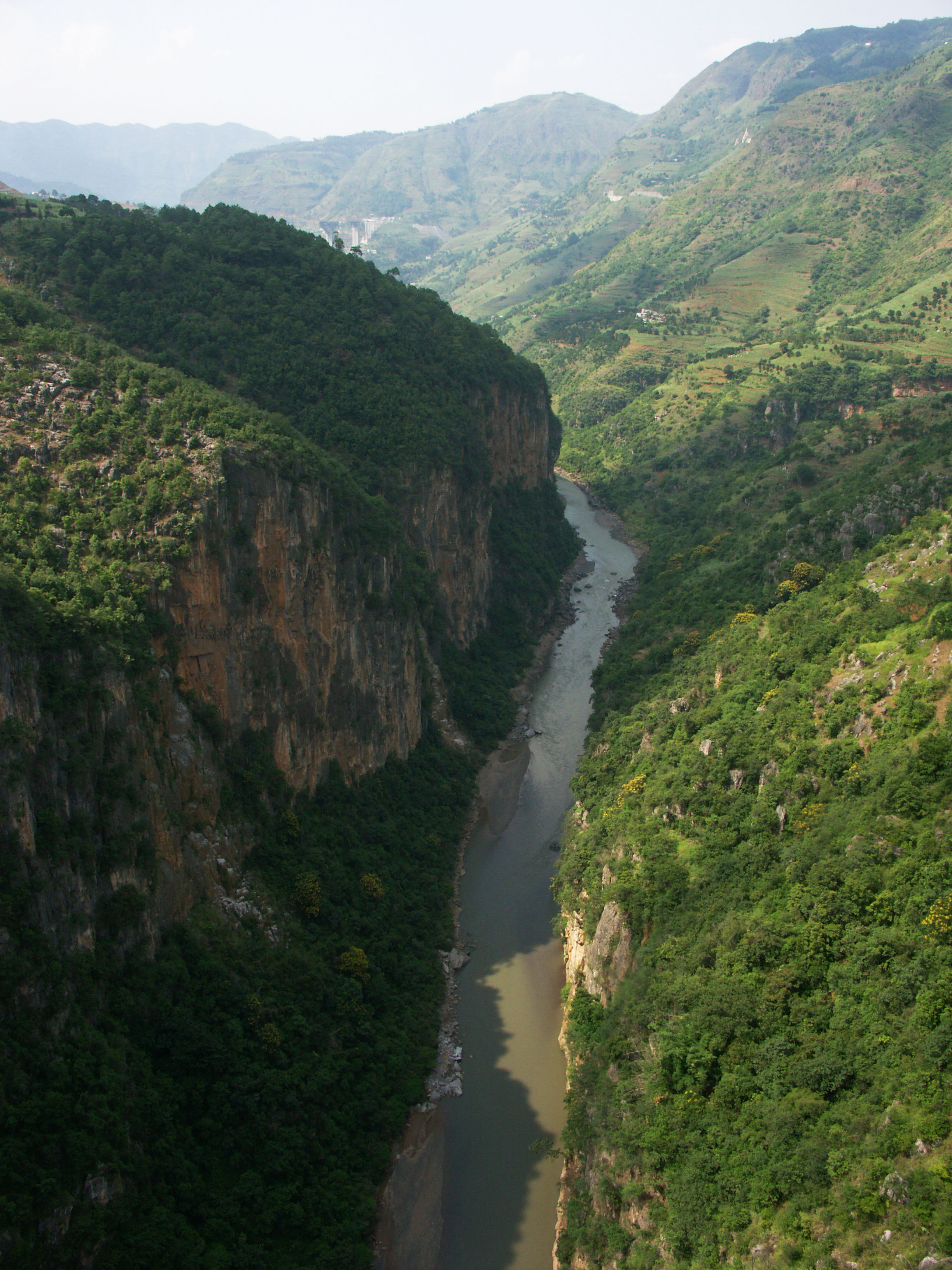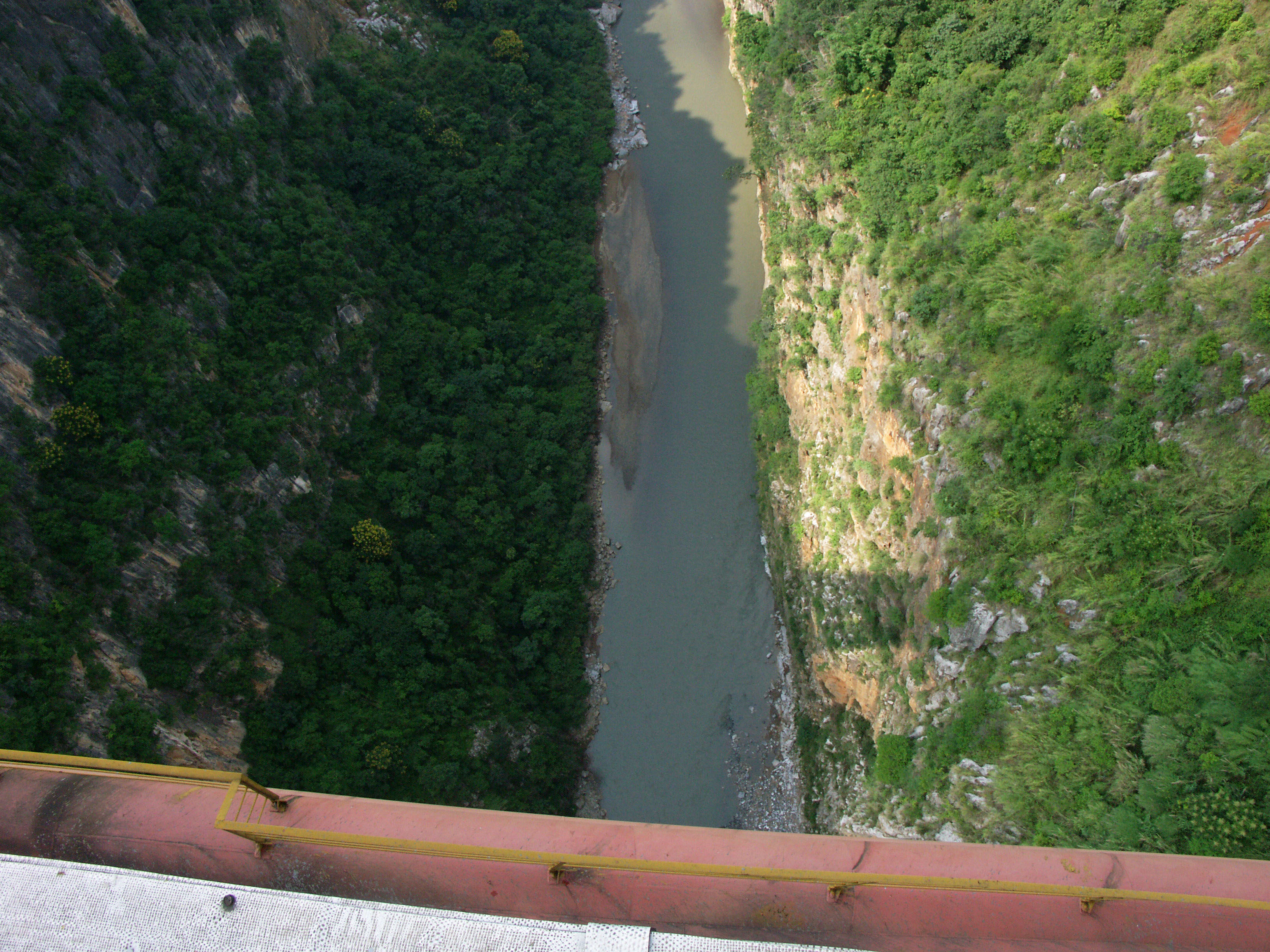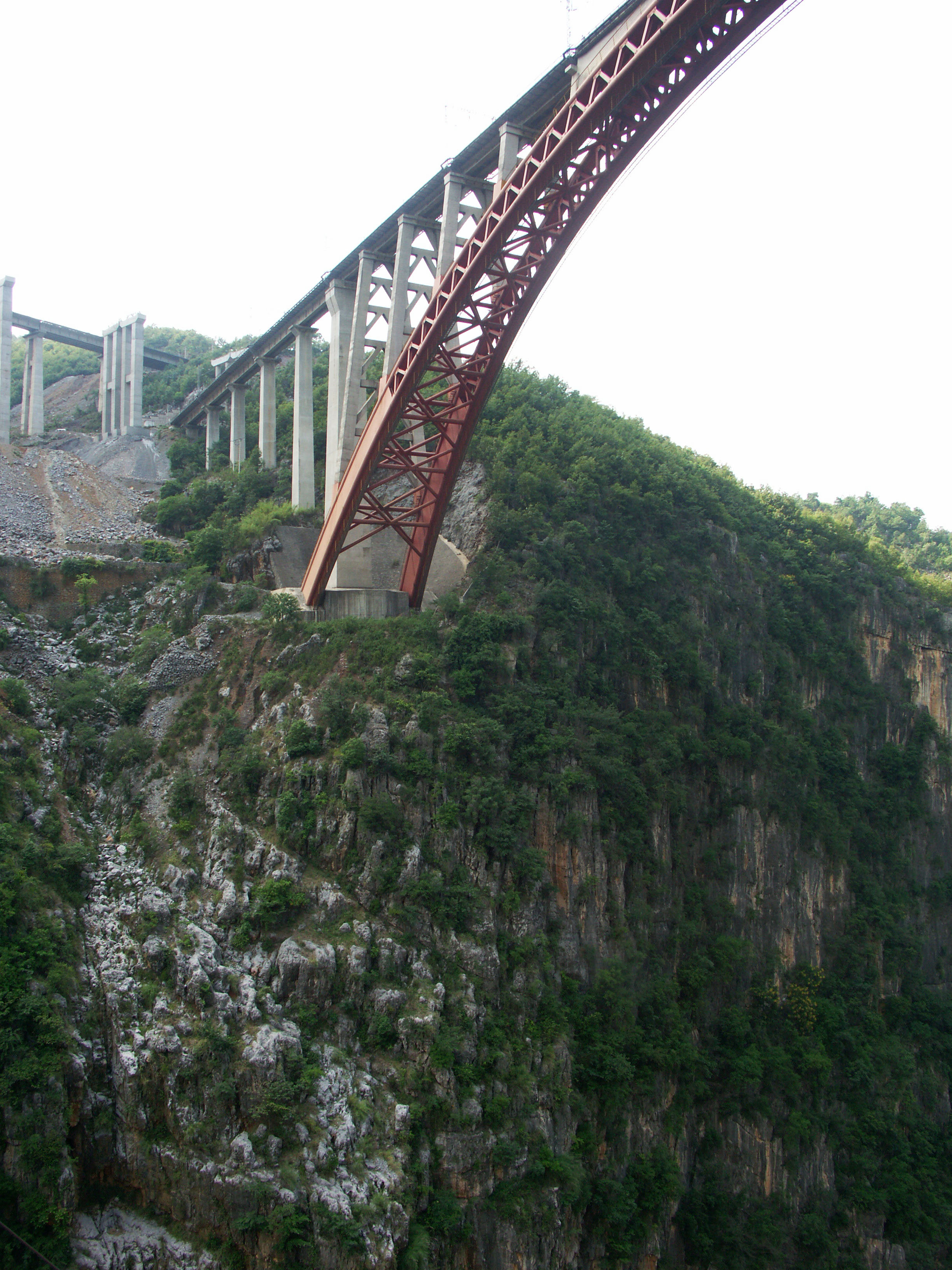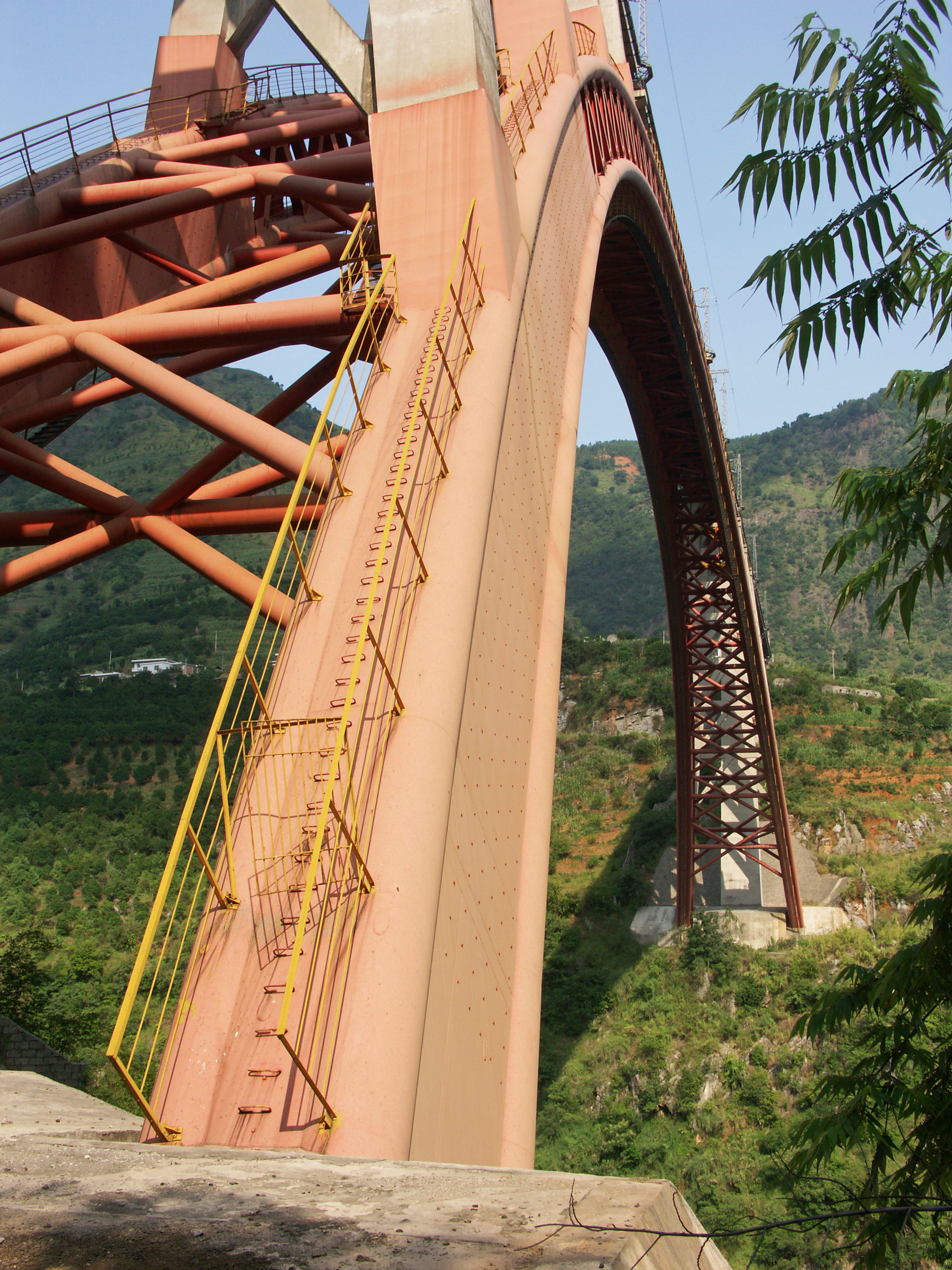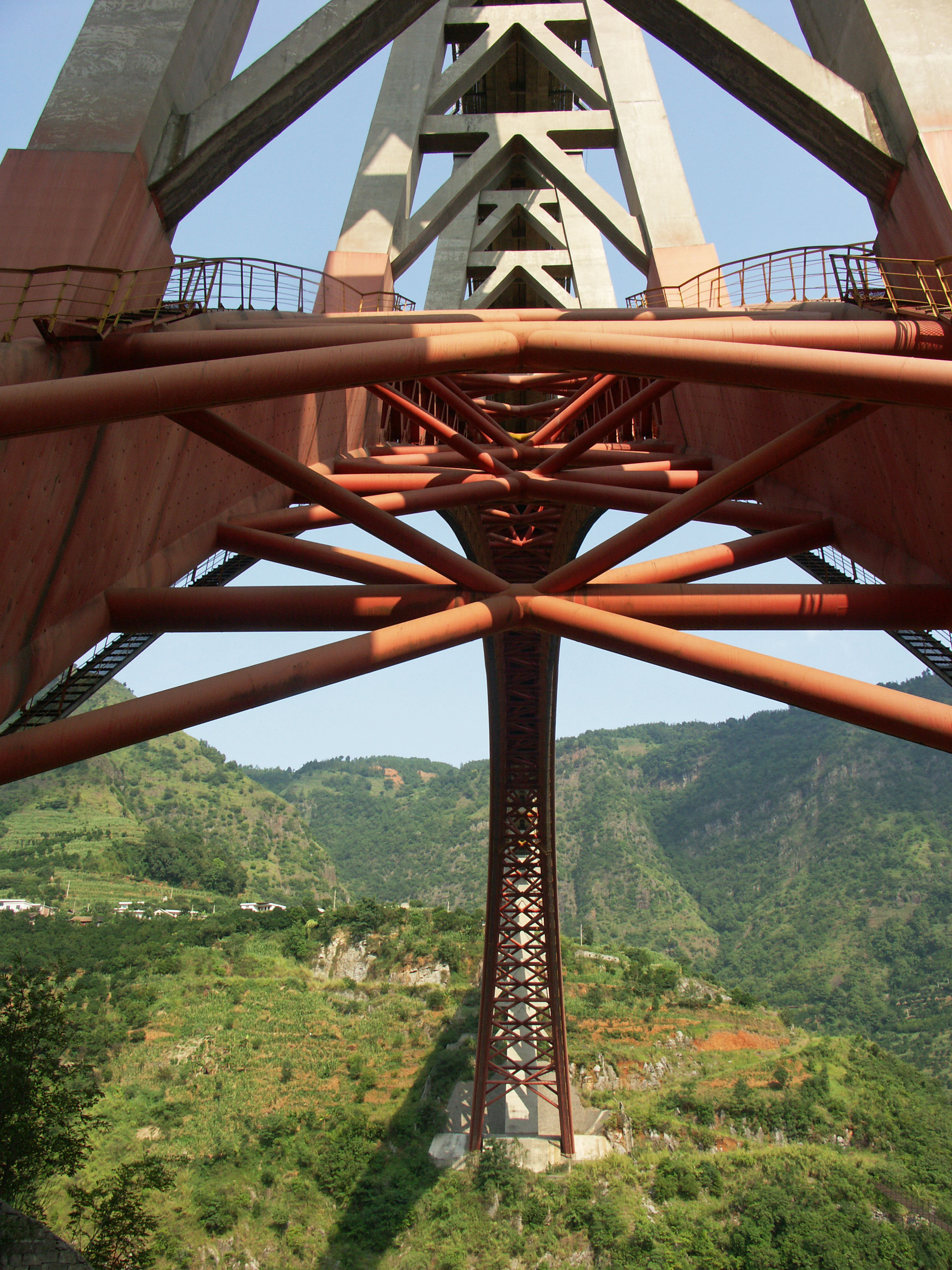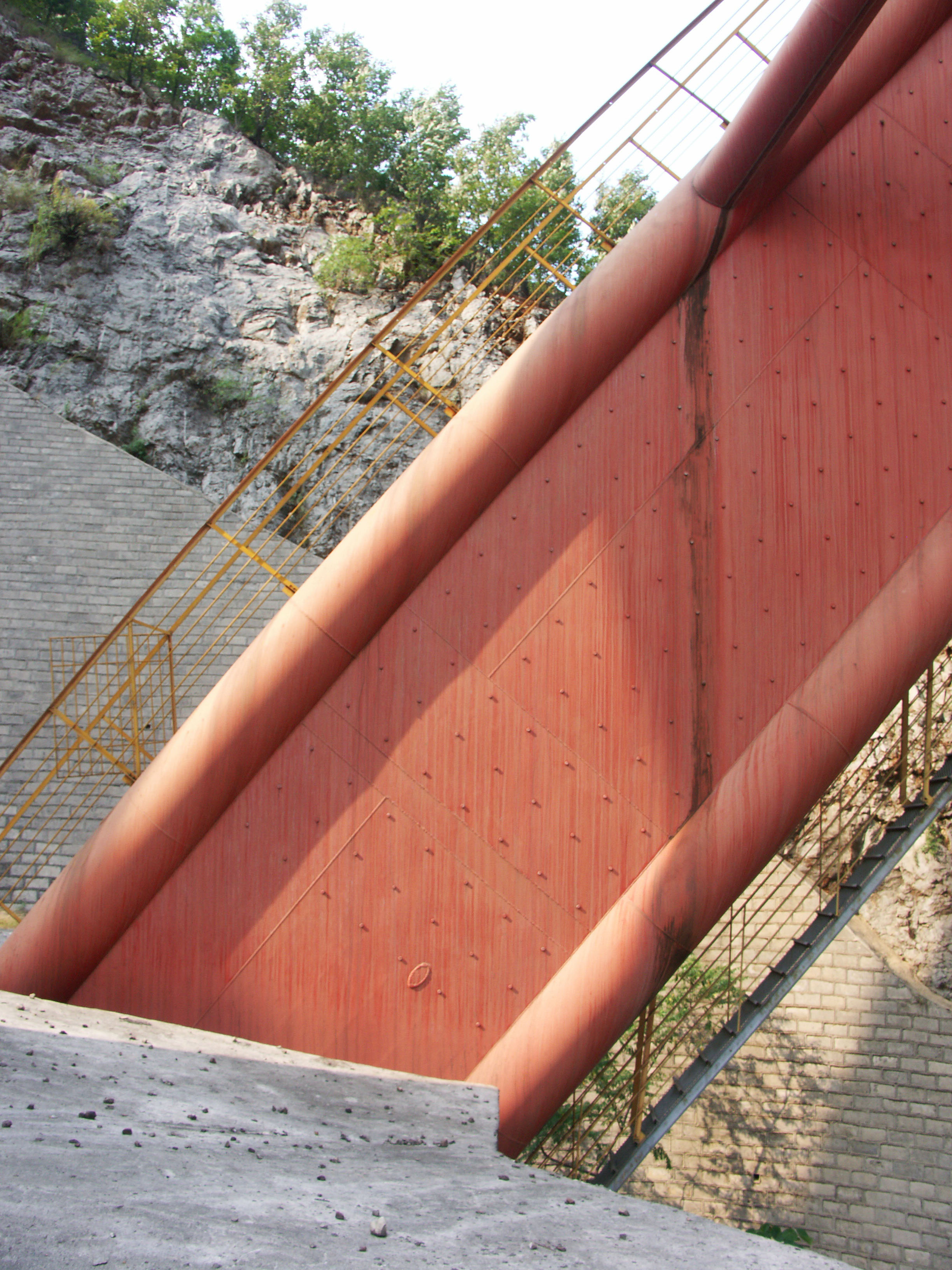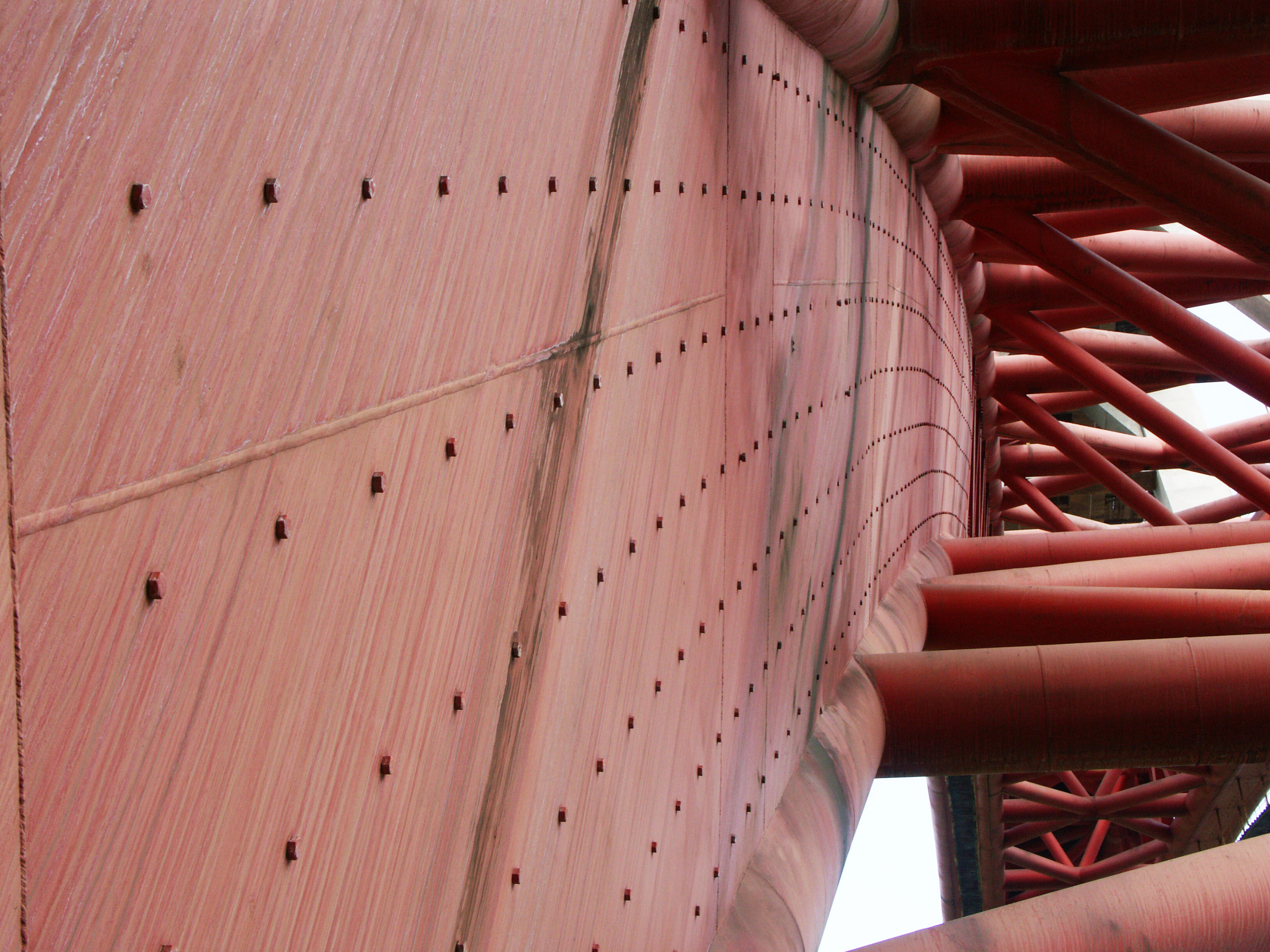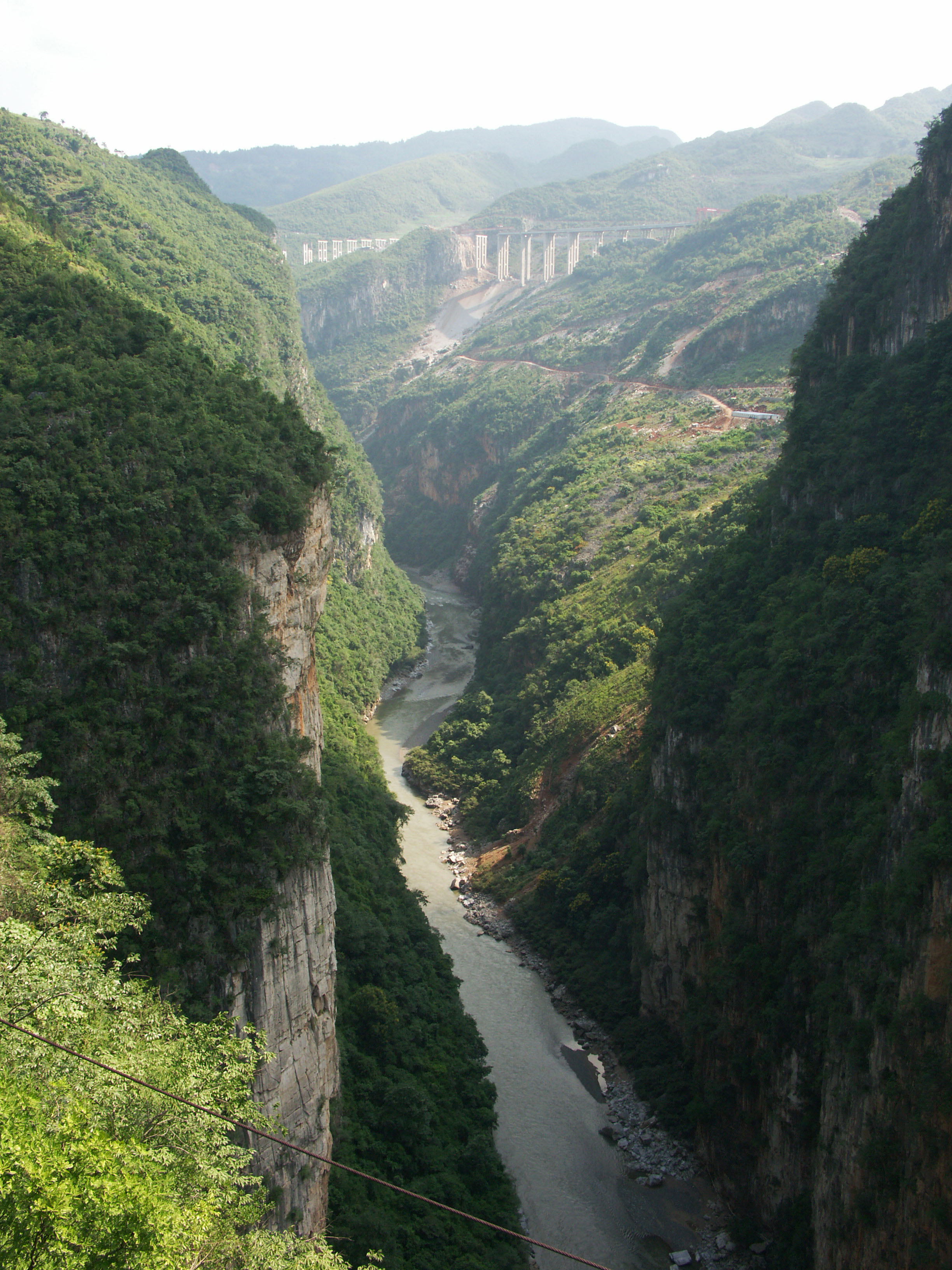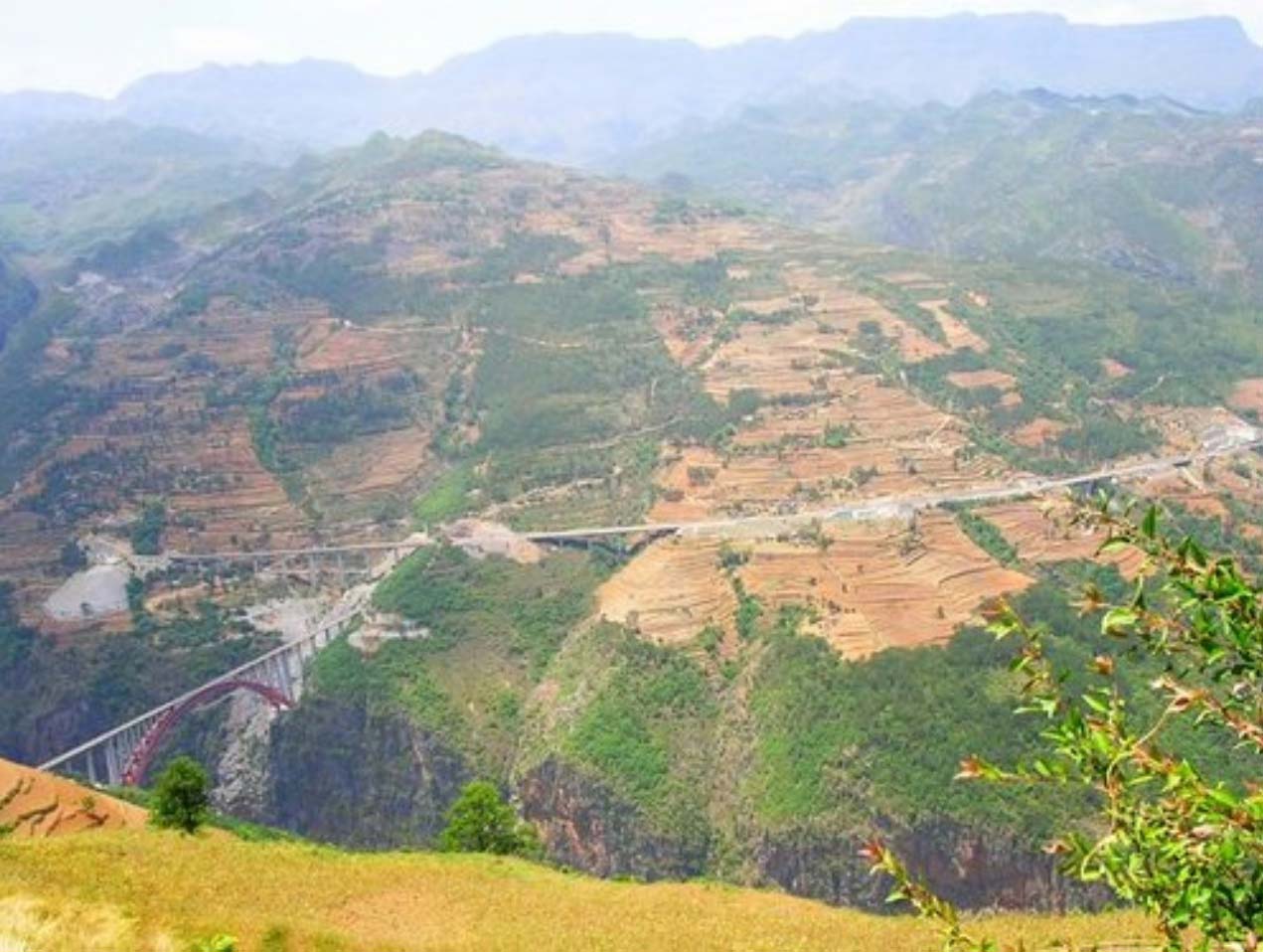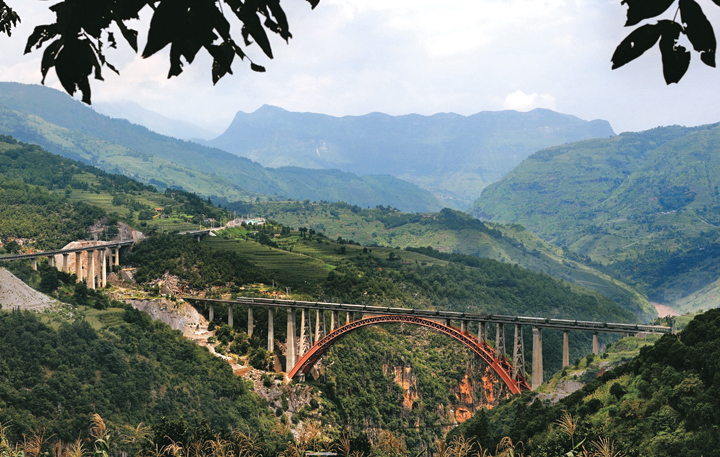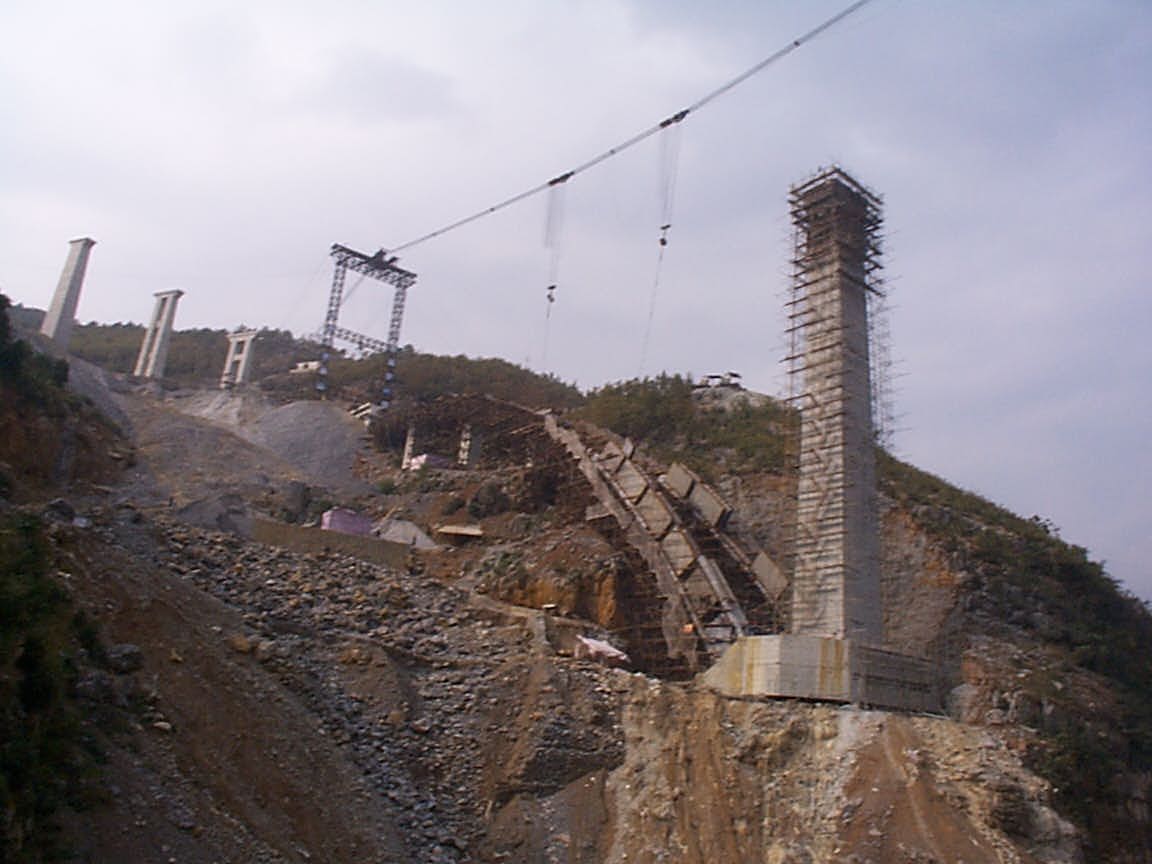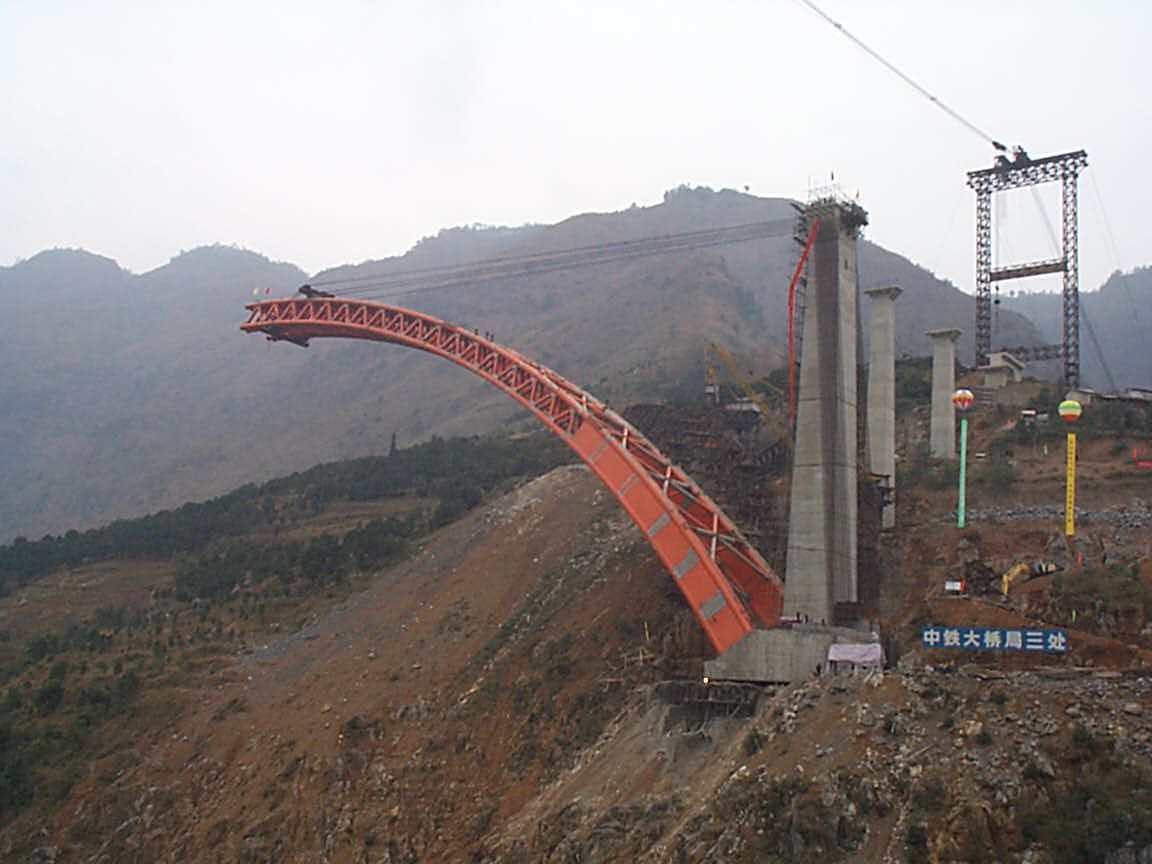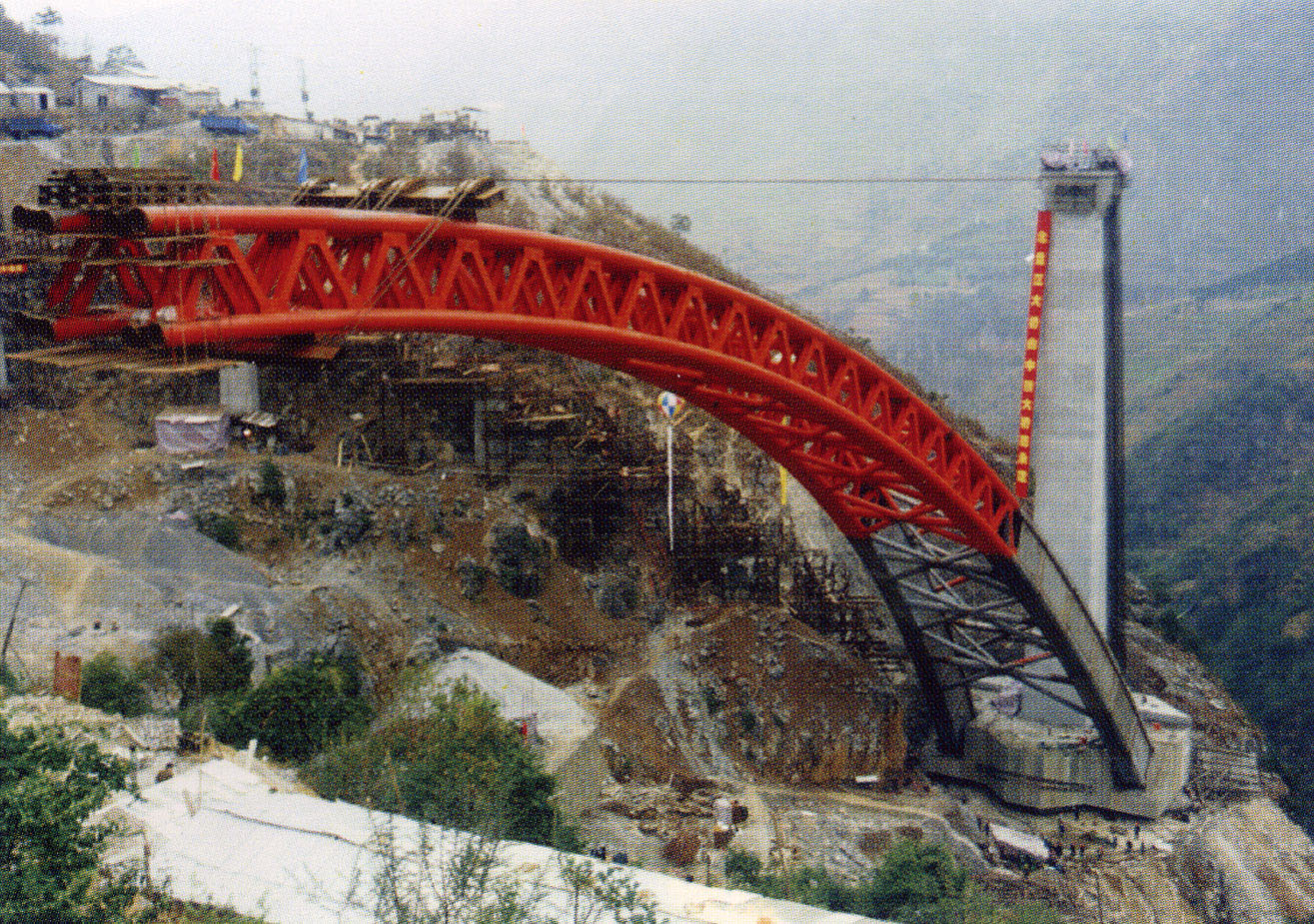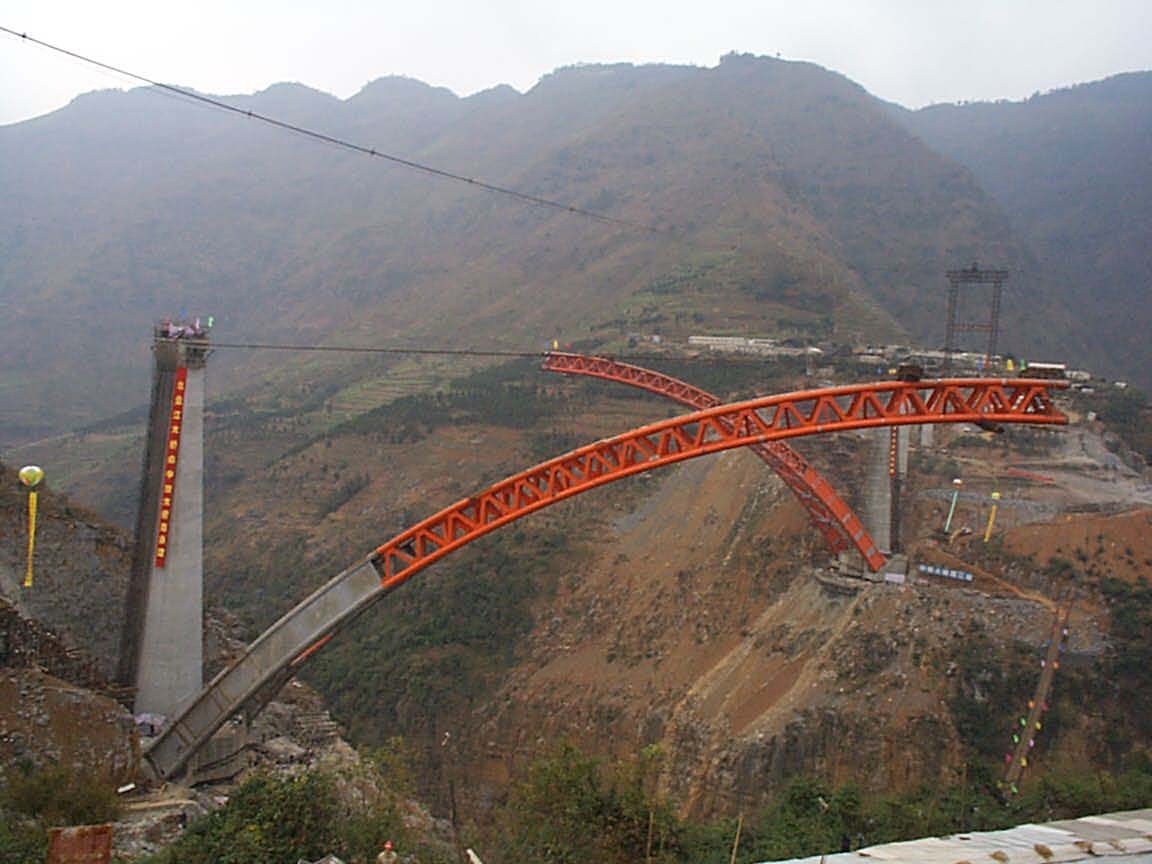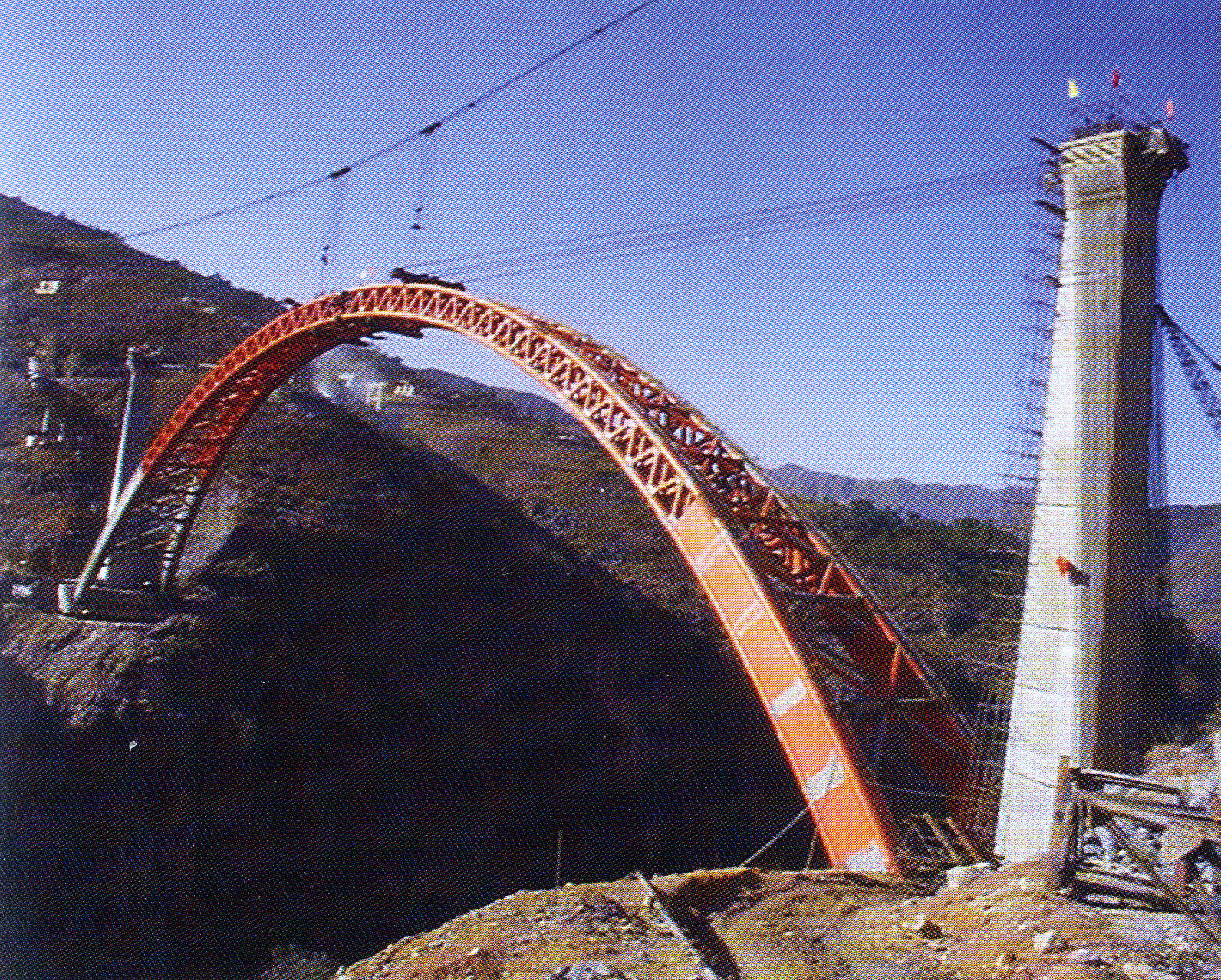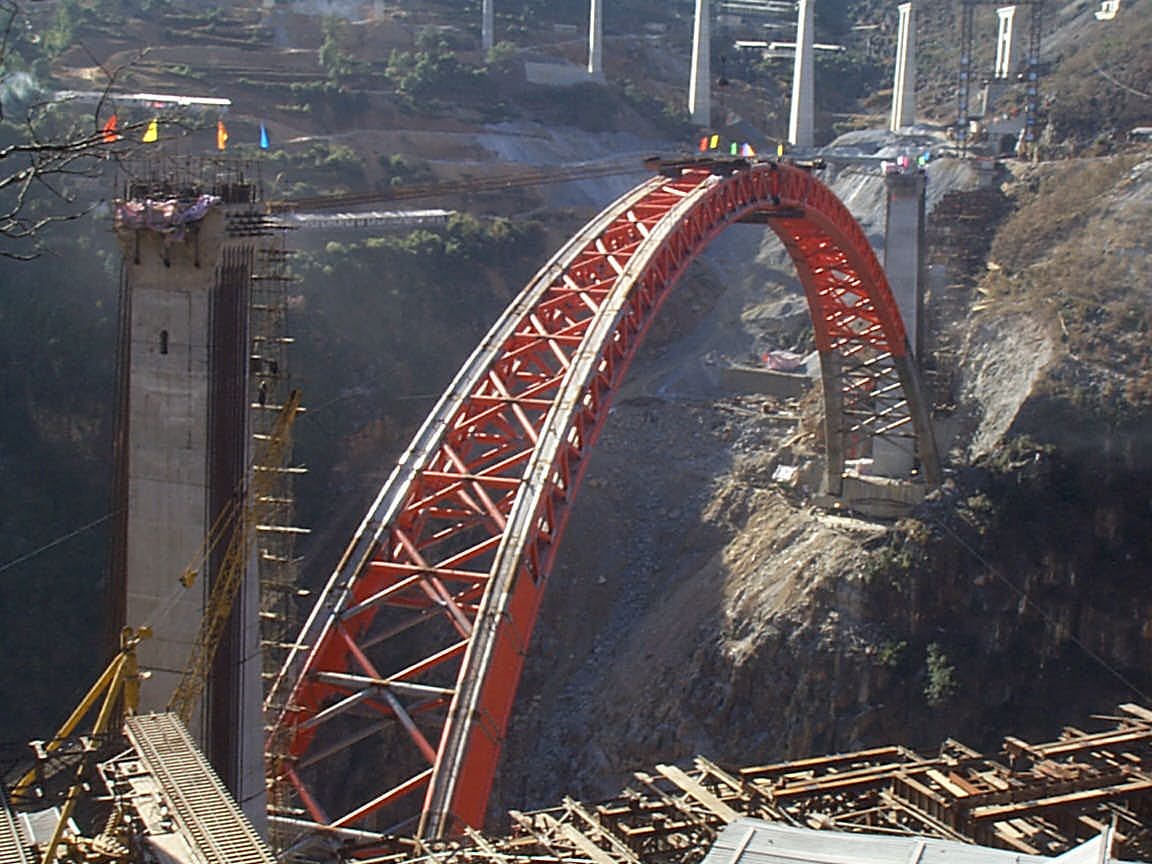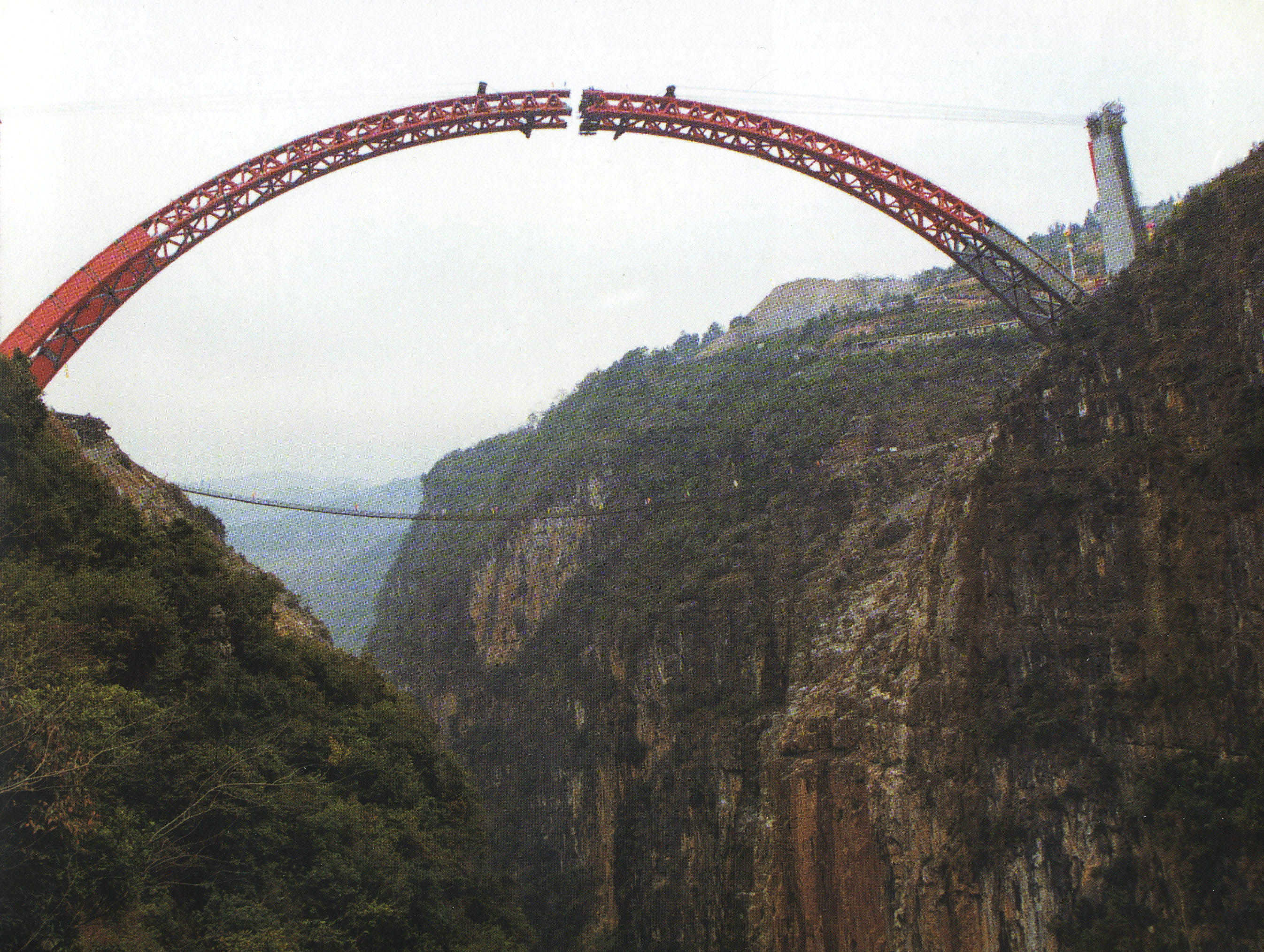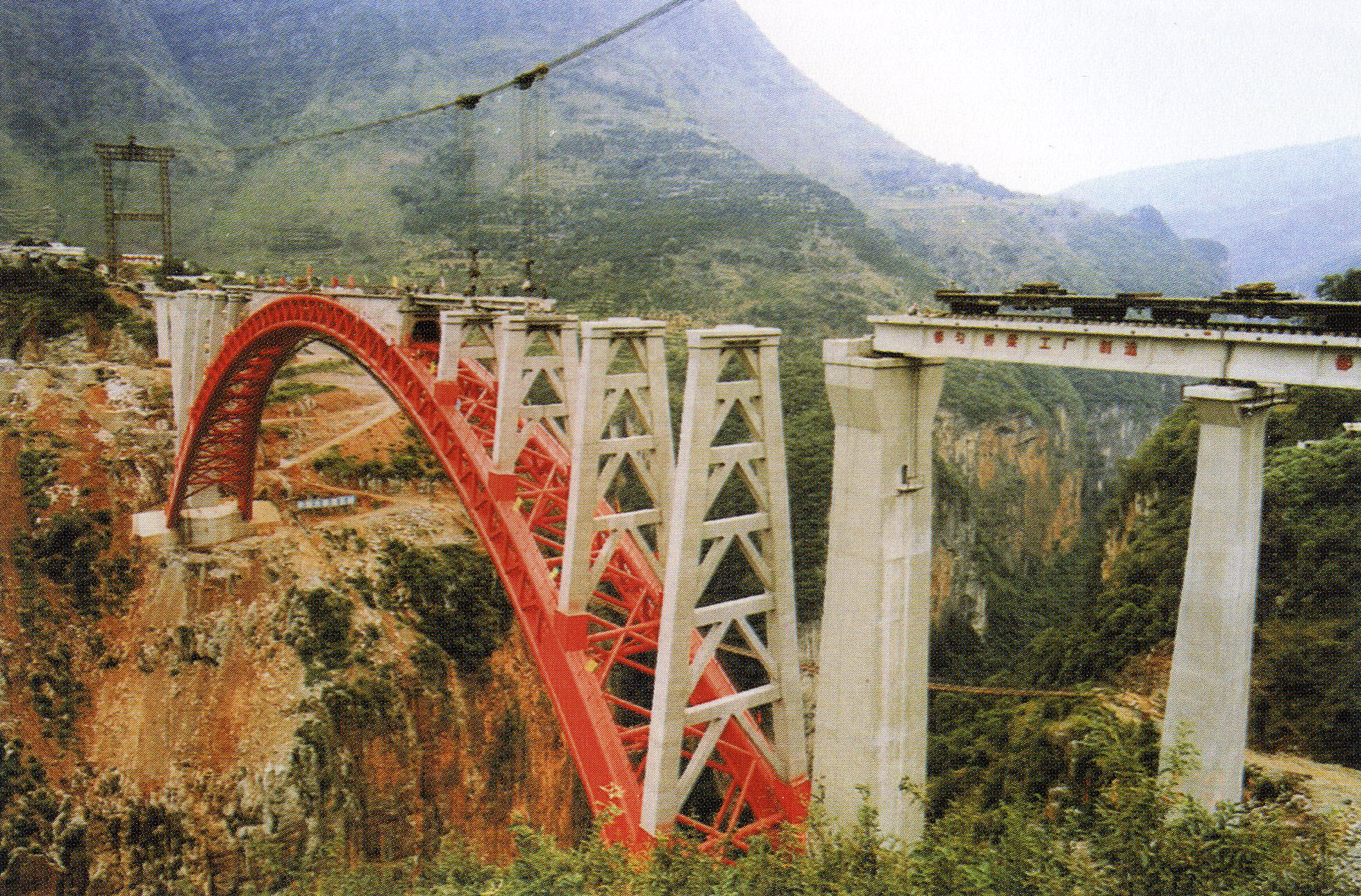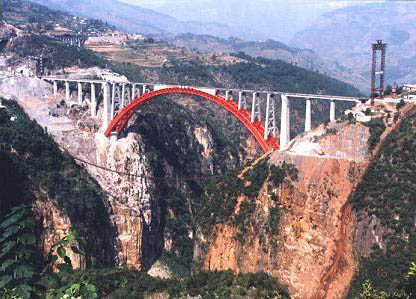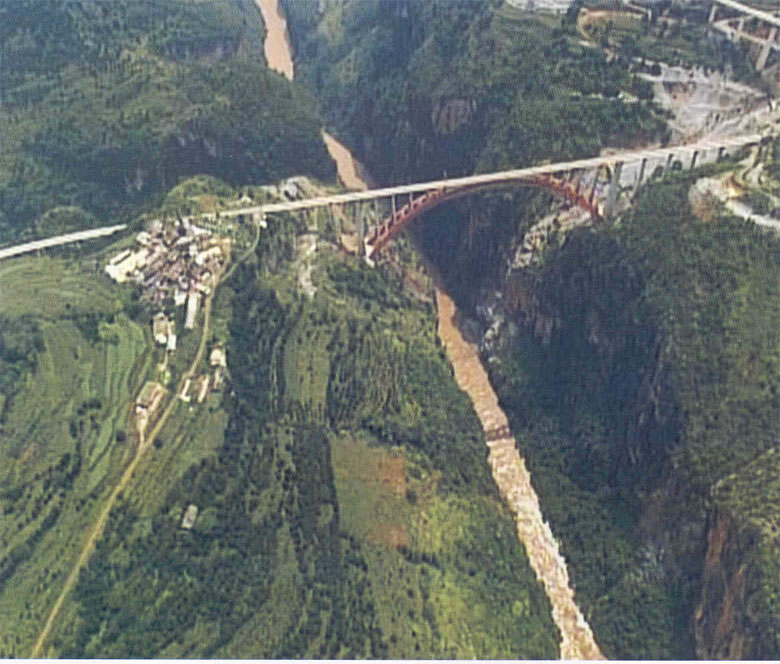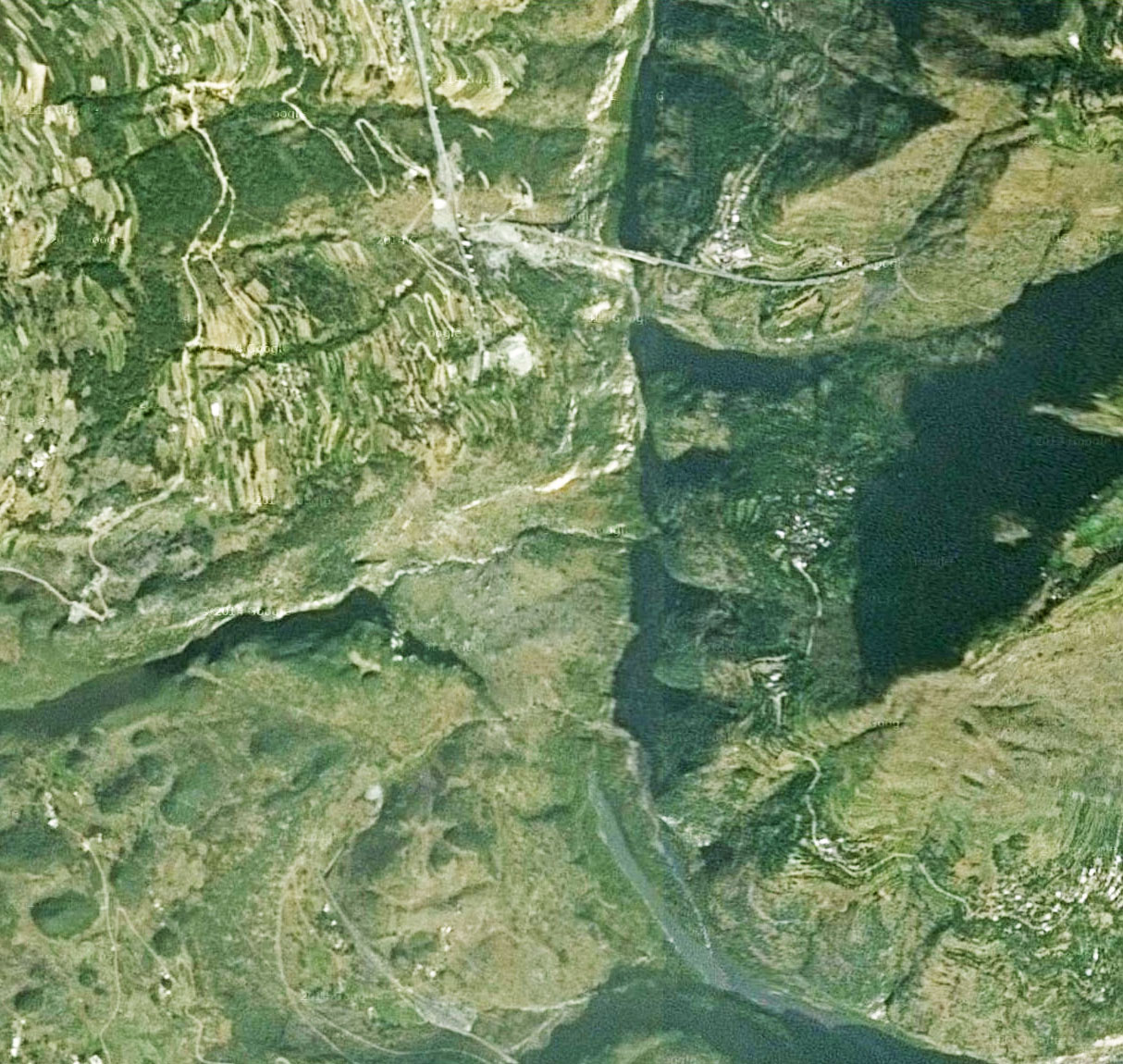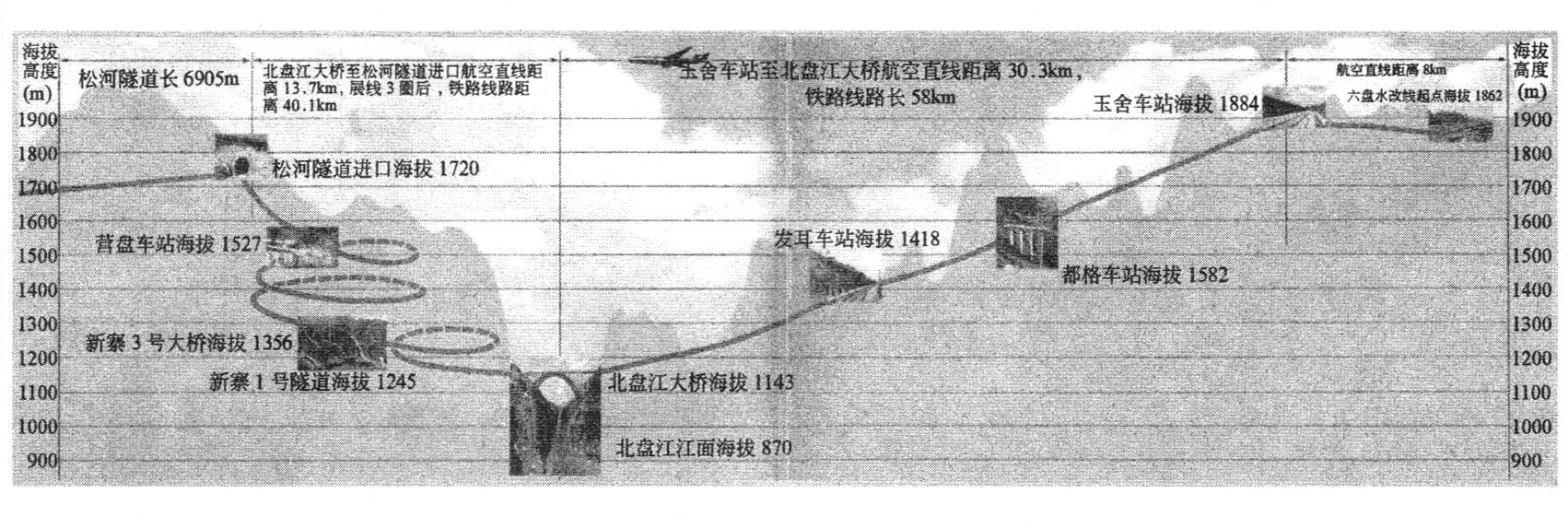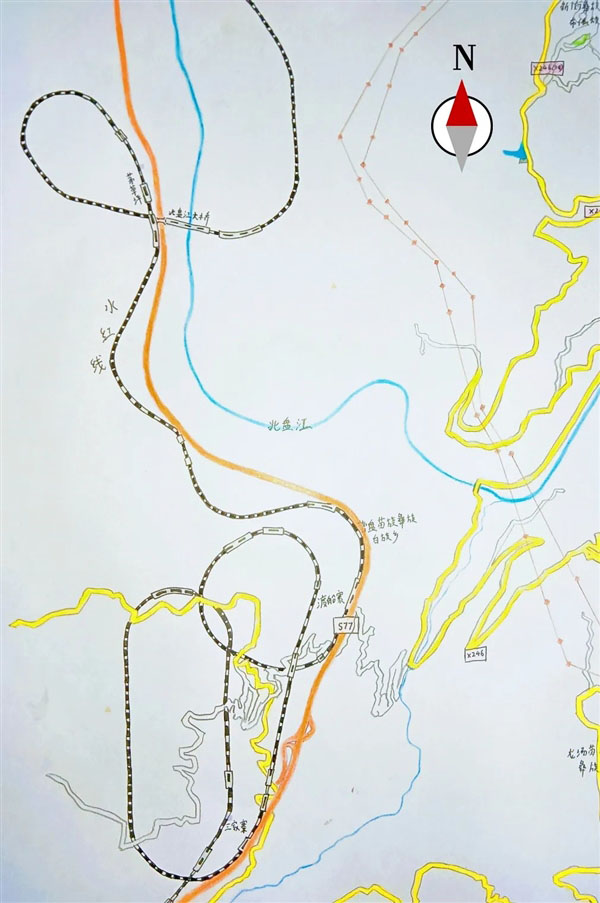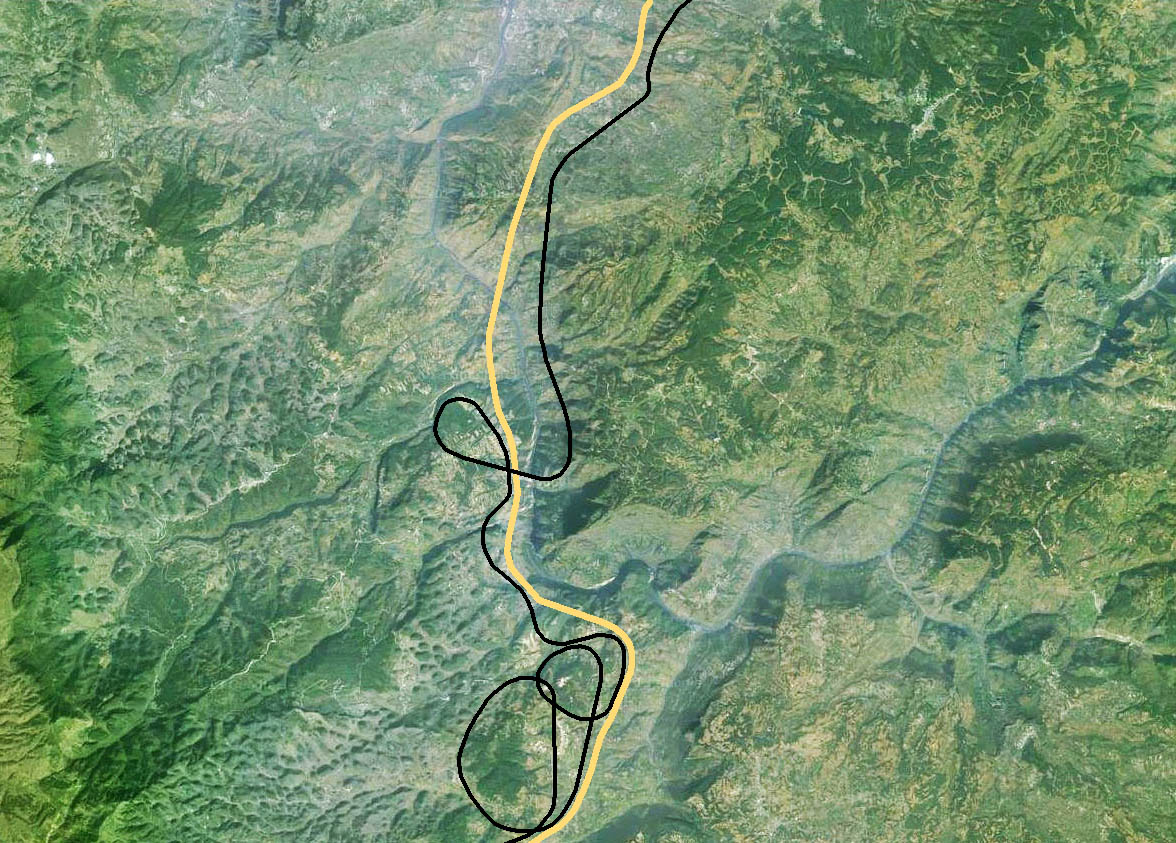Beipanjiang Railway Bridge Shuibai
Beipanjiang Railway Bridge Shuibai
水柏铁路北盘江大桥
Fa’er Bouyei, Guizhou, China
902 feet high / 275 meters high
771 foot span / 235 meter span
2001
When it opened in 2001, the 902 foot (275 meter) high Beipanjiang River railway bridge became the highest arch bridge on earth, unseating the 23-year old record long held by West Virginia’s New River Gorge bridge as well as being the second highest bridge of any kind in the world. It also became the World’s Highest Railway bridge, toppling the quarter century record of the Mala Rijeka viaduct in Podgorica, Montenegro. In 2009, the Beipanjiang Railway Bridge Shuibai lost its highest arch title to another Chinese span, the 965 foot (294 mtr) high Zhijinghe road bridge while in 2016, the opening of the Najiehe Railway Bridge and the Beipanjiang Railway Bridge Qinglong pushed it further down in the overall ranking of high railway bridges.
In 2014 the downstream Shannipo Dam created a reservoir that is partially beneath the Beipanjiang Railway Bridge reducing the height to 258 meters with another 17 meters of reservoir hiding the original river level of approximately 868 meters.
Located southwest of the city of Liupanshui near the north end of China’s Guizhou province on the Shuibai Railway, the Beipanjiang railway bridge crosses an exceptionally deep gorge with vertical cliffs rising hundreds of feet from either side of the Beipan river. The 118 kilometer railway connects Liupanshui and Baiguo with 65% of the track in tunnels or on bridges. The longest tunnel is 7 kilometers.
The bridge was the first of what is now 4 Beipanjiang crossings to have been among the world’s 10 highest. The second was the Beipanjiang Guanxing highway bridge that opened in 2003 near Huajiang. The third came along in 2009 on the Guiyang to Kunming Hukun Expressway. Then in 2016 the Beipanjiang Bridge Duge opened with a World Record deck height of 564 meters. While not in the 300+ meter super-high category as these Beipan crossings, there are several other high bridges that have been built over the Beipan river gorge including the the Beipanjiang Bridge on the Shuipan expressway with the world’s longest span high-level beam bridge, the Beipanjiang Bridge Wang’an expressway and the Beipanjiang Bridge Zhenfeng. Most of these bridges are spaced about 50 miles apart from each other. No other river on earth outside China has more than one or two high bridges over it - the Beipanjiang has 8 with more to come!
The word Beipanjiang (pronounced Bay-Pan-Gee-Ang) translates into North Winding River with the word “bei” meaning north and “pan” meaning winding. Cutting a huge swath from the northwest end of Guizhou Province to the southwest where it becomes the Hongshui he River at the border of Guangxi Province, the Beipanjiang River traverses through some of China’s most spectacular mountain gorges. The river remains the biggest obstacle between the city of Guiyang and the city of Kunming.
Construction of the bridge was built using a method developed by the Chinese that had never been used before on a bridge so large. Instead of building two temporary towers to support a “high line” to assist in building the two sides of the arch outward until they met in the middle, the two halves of the bridge were built separately on falsework constructed just above ground on the hillsides at the edge of the canyon. Once completed, each side was then rotated horizontally outward over the river in one delicate maneuver and then connected at the crown. The central bearing located on top of each of the foundations consisted of a pair of closely fitted 11.5 foot (3.5 mtr) diameter concave spherical sections with a radius of 26 feet (8 mtrs). On top of the lower bearing, between the two sections, 610 pieces of 60mm x 18mm teflon flakes were used to keep friction to a minimum. A massive water tank was installed on the back of the counter weighting pier to assist in finding an accurate center of gravity as well as preventing the system from overturning. Once the two halves of the arch were closed at the crown, the rotatable foundations were entombed in tons of concrete. This unique method of rotating the arch halves during construction has been used on other large arch bridges in China including those that are built on flat terrain just above the level of the river.
Also unique to the Beipanjiang span are the two steel arch ribs. Initially hollow during construction, concrete was pumped inside of them from the foundations upward to the crown. First used by the Chinese in 1990, they have refined and improved the technique and now use it on the majority of their steel arch bridges. Depending on the length of the span and the width of the bridge, different styles of tubing are used. For the Beipanjiang, a mix of a horizontal dumbbell and single tubes was adopted. Other configurations have single tubes further apart, double dumbbells or a tight cluster of tubes known as “multiple contiguous”. Once hardened, the concrete solidifies and stiffens the arch, improving the compressive strength of the entire structure.
The bridge is located about 30 miles (48 kilometers) south of Liupanshui City next to the Shuipan Expressway.
You can watch a nice video of the bridge design and construction below. http://video.sina.com.cn/v/b/17860424-1244196734.html
在其2001年通车之际,275米高的北盘江铁路桥就成为了地球上最高的拱桥了,将尘封了23年之久的西弗吉尼亚的新河峡谷大桥的纪录刷新。它同时也成为了世界上最高的铁路桥梁,也更替保持了半个世纪多的蒙特内格罗的波德戈里查的马拉·里耶卡高架桥的记录。就在2009年,北盘江铁路桥世界第一高度拱桥的头衔拱手让给了另一座中国的大桥,294米高的支井河大桥,而在不久将来的201年的印度,321米高的奇纳布河桥将会取而代之称为铁路桥的世界第一。
地处中国的贵州省西北部的六盘水市以西的北盘江铁路桥,跨越的是相当之深的峡谷,北盘江两侧陡峭的岩壁笔直立起数百英尺之高。该桥是北盘江上建成的进入世界前十高度桥梁之列的三座北盘江大桥中的第一座桥。第二座是2003年在花江附近的公路桥,第三座是2009年建成的贵阳至昆明的高速公路桥梁。这三座北盘江大桥各自间距约50英里远,除了在中国,地球上没有任何一条河流上同时有三座很高的桥梁建成——仅仅只有北盘江,3座!如果这还不让人难以置信的话,规划中的昆明至毕节的公路干线上建有第四座跨越天堑的通道!并且紧邻北盘江铁路桥!
词语“北盘江”的意思,拆解开来是“曲曲折折盘在山岭间的大江的北段”。从贵州西北角发源,像一道深深的刀痕一样,北盘江一路蜿蜒直至贵州西南角,直至接近广西时成为了红水河,它横贯过了中国许多雄峻的山脉。北盘江仍然是贵阳和昆明之间最大的阻隔。
该桥的施工使用的方法由中国工程师们开创,而且之前从未在如此大规模的桥梁上使用过。该桥的未采用——先建设两个临时性主塔,用以架设一道高空索道来辅助两侧的拱圈的施工,直至拱圈在跨中合拢——的方法,而是将两个拱桥的两半片的拱圈分别在峡谷两侧的山坡上预制,然后将每半片拱圈通过一个精妙的方式,向河中心方向水平旋转,再在拱顶处成功连接。在每个拱座顶部的中心支座是紧密结合的3.5米直径的凹面相上的摩擦副球型铰,整个支座半径8米。在较低的支座表面,位于两个接触面之间,设置了610片60mmX80mm的聚四氟乙烯滑板用以将摩擦力降至最低。在结构的后半部份安装了巨大的水箱配重,用以平衡自重和使得转体式结构的中心精确地落在支承处,也可以防止结构旋转过度。一旦两个半片拱圈在拱顶位置接近时,在可转动的基座处就会浇注上大量的混凝土来起到固定效果。这种独特的拱桥转体施工方法也在功过其他的一些大型拱桥上使用过,包括那些平坦地区的河流上的拱桥。
另一个在北盘江上使用的独特的技术是其两个劲性钢管。施工初期空心的钢管,最后会有混凝土从拱脚基础处向拱顶处进行灌注填充。这一技术最初在20世纪90年在中国使用,之后又被加以完善改进,现在已经在中国多数的钢拱桥上使用。根据桥梁跨度和宽度的不同,许多不同的钢管形式均有使用。对北盘江大桥而言,采用的是水平向哑铃型和单管的混合形式。其他的构造形式,有分离式单管,双哑铃式或者紧促的钢管束(组合式钢管)。一旦强化,混凝土就会固结并加强拱圈,增强整个结构的整体强度。
Image by Eric Sakowski / HighestBridges.com
Image by Georges.
Image by flily.
A rare view of the arch taken from the inaccessible Bei Pan River gorge. The photographer chose to remove the footbridge with a program like Photoshop.
Image by flily.
A passenger train rolls across the arch in this August, 2011 view. Image by Eric Sakowski / HighestBridges.com
Image by Eric Sakowski / HighestBridges.com
Image by Eric Sakowski / HighestBridges.com
Image by Eric Sakowski / HighestBridges.com
Image by Eric Sakowski / HighestBridges.com
Image by Eric Sakowski / HighestBridges.com
Transportation fan Roger Perrin watches as a train comes out of the West tunnel. Image by Eric Sakowski / HighestBridges.com
Image by Eric Sakowski / HighestBridges.com
Image by Eric Sakowski / HighestBridges.com
Local farmers also use the walkways to get across the river canyon. Image by Eric Sakowski / HighestBridges.com
Image by Eric Sakowski / HighestBridges.com
Image by Eric Sakowski / HighestBridges.com
Image by Eric Sakowski / HighestBridges.com
Image by Eric Sakowski / HighestBridges.com
Image by Eric Sakowski / HighestBridges.com
Image by Eric Sakowski / HighestBridges.com
Image by Eric Sakowski / HighestBridges.com
Image by Eric Sakowski / HighestBridges.com
Image by Eric Sakowski / HighestBridges.com
A reservoir several meters deep began to form below the bridge in 2014 from the completion of a downstream dam. Image by Eric Sakowski / HighestBridges.com
A construction view from 2000.
Image by Eric Sakowski / HighestBridges.com
A huge footbridge was built across the gorge to allow bridge workers access to both sides of the arch construction. With a maximum vertical deck to water distance of 650 feet (198 meters), this is the highest catenary footbridge ever built. Despite its dilapidated condition, I ventured across the chicken wire walkway in August of 2011. Travel mates Roger Perrin and Georges thought I was a bit crazy. This once-in-lifetime experience made for some great photos as well as bragging rights of being the only person outside of China to have crossed such a high, Tibet-style footbridge. The 656 foot long (200 meter) long structure is composed of 6 parallel cables that support a wire mesh. On the East side there are 2 wind stabilizing cables. Image by Eric Sakowski / HighestBridges.com
Image by Eric Sakowski / HighestBridges.com
Image by Eric Sakowski / HighestBridges.com
Image by Eric Sakowski / HighestBridges.com
Image by Eric Sakowski / HighestBridges.com
Image by Eric Sakowski / HighestBridges.com
A view looking 650 feet (198 meters) straight down! Image by Eric Sakowski / HighestBridges.com
Image by Eric Sakowski / HighestBridges.com
Image by Eric Sakowski / HighestBridges.com
A 2015 view showing the location of the now removed Shuibai Railway Footbridge. Image by Eric Sakowski / HighestBridges.com
Image by Eric Sakowski / HighestBridges.com
Georges checks out the bridge in 2011. Image by Eric Sakowski / HighestBridges.com
A simple steel frame holds the hand cables while a concrete anchorage holds the 6 deck cables. Image by Eric Sakowski / HighestBridges.com
Image by Eric Sakowski / HighestBridges.com
Image by Eric Sakowski / HighestBridges.com
Image by Eric Sakowski / HighestBridges.com
There are catwalks on 3 different levels of the arch including the top, bottom and inside the truss. Image by Eric Sakowski / HighestBridges.com
Image by Eric Sakowski / HighestBridges.com
The new G56 expressway was under construction in the summer of 2011 and passes alongside the older railway line. Once it is open to traffic in 2012 the once inaccessible railway bridge will be easy to see by simply pulling over on the highway. There are many viaducts that traverse along the steep slopes of the Beipanjiang river as well as a huge crossing of the river itself on a massive concrete beam viaduct 820 feet (250 meters) above the river. There are two other nearby beam viaducts over 100 meters high. Image by Eric Sakowski / HighestBridges.com
Image by Eric Sakowski / HighestBridges.com
The impressive Laoyingyan Bridge can be seen from the arch. Translated as Eagle Rock Bridge, the 4-lane crossing has two main spans of 160 meters and a height of approximately 150 meters though the roadway is 300 meters above the elevation of the Bei Pan River. Image by Eric Sakowski / HighestBridges.com
Image by Eric Sakowski / HighestBridges.com
Image by Eric Sakowski / HighestBridges.com
Image by Eric Sakowski / HighestBridges.com
A view of the rotatable foundation before it was sealed in to become one solid foundation block.
Image by Eric Sakowski / HighestBridges.com
Image by Eric Sakowski / HighestBridges.com
Image by Eric Sakowski / HighestBridges.com
Image by Eric Sakowski / HighestBridges.com
Image by Eric Sakowski / HighestBridges.com
Image by Eric Sakowski / HighestBridges.com
Image by Eric Sakowski / HighestBridges.com
Image by Eric Sakowski / HighestBridges.com
The railway line crosses the bridge and then makes a tear-drop shaped loop of almost 270 degrees before it continues south for a long climb out of the river valley that includes a double helix and several more long tunnels. Image by flily.
Beipanjiang arch bridge plan.
Beipanjiang Railway Bridge satellite image.
An elevation of the railway line descent shows just how unforgiving the Beipanjiang River gorge is to engineers who must confront elevation differences of up to 1,000 meters.
A wider view showing the giant tunnel spirals of the Shuibai Railway that were necessary to reduce the steepness of the railway grade that descends hundreds of meters down into the Beipanjiang River gorge.
The many high bridges of the Shuipan expressway are in close proximity to the Baiguo Railway line and the Beipanjiang Railway Bridge.
